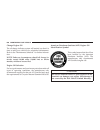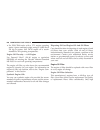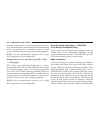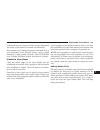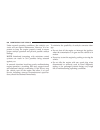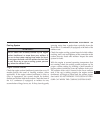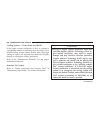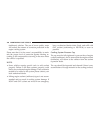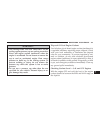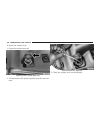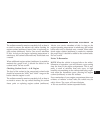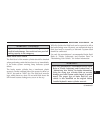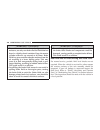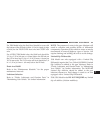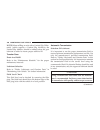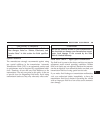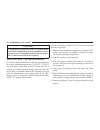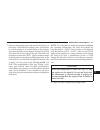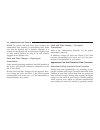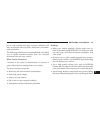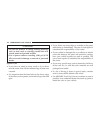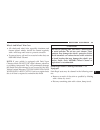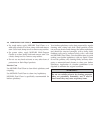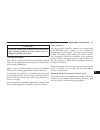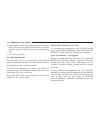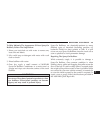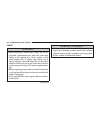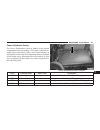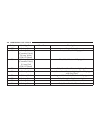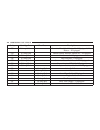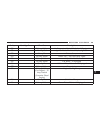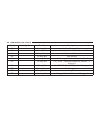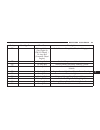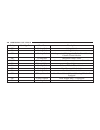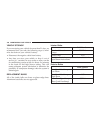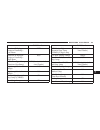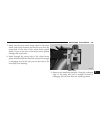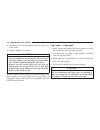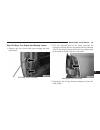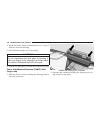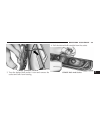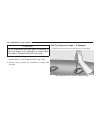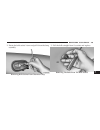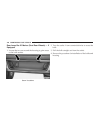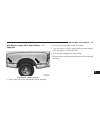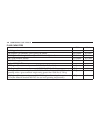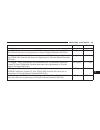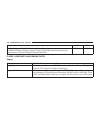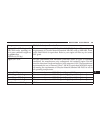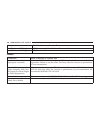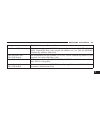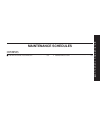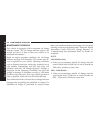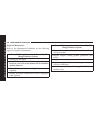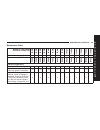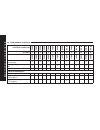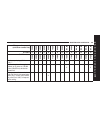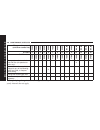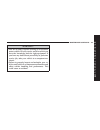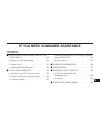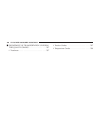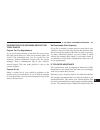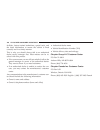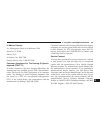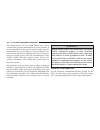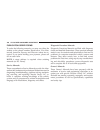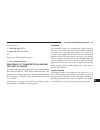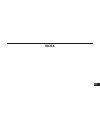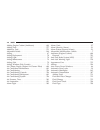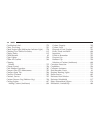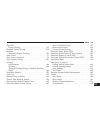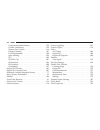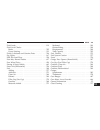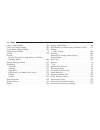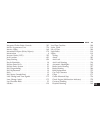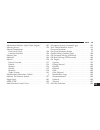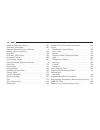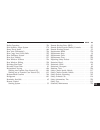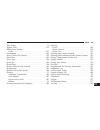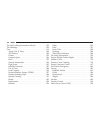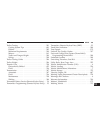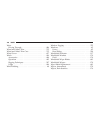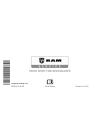- DL manuals
- RAM
- Automobile
- TRUCK 1500 2014
- Owner's Manual
RAM TRUCK 1500 2014 Owner's Manual
Summary of TRUCK 1500 2014
Page 1
1 5 0 0 / 2 5 0 0 / 3 5 0 0 chrysler group llc o w n e r ’ s m a n u a l 2 0 1 4 2014 ram truck 1500/2500/3500 14d241-126-ac third edition printed in u.S.A. R a m t r u c k.
Page 2
Vehicles sold in canada with respect to any vehicles sold in canada, the name chrysler group llc shall be deemed to be deleted and the name chrysler canada inc. Used in substitution therefore. Driving and alcohol drunken driving is one of the most frequent causes of accidents. Your driving ability c...
Page 3: Table Of Contents
Table of contents section page 1 introduction . . . . . . . . . . . . . . . . . . . . . . . . . . . . . . . . . . . . . . . . . . . . . . . . . . . . . . . . . . . . . 3 2 things to know before starting your vehicle . . . . . . . . . . . . . . . . . . . . . . . . . . . . . 9 3 understanding the feat...
Page 5: Introduction
Introduction contents 䡵 introduction . . . . . . . . . . . . . . . . . . . . . . . .4 䡵 how to use this manual . . . . . . . . . . . . . .4 䡵 warnings and cautions . . . . . . . . . . . . . .6 䡵 van conversions/campers . . . . . . . . . . . .6 䡵 vehicle identification number . . . . . . . .6 䡵 vehic...
Page 6
Introduction congratulations on selecting your new chrysler group llc vehicle. Be assured that it represents precision workmanship, distinctive styling, and high quality - all essentials that are traditional to our vehicles. This owner’s manual has been prepared with the assis- tance of service and ...
Page 7
1 introduction 5.
Page 8
Warnings and cautions this owners manual contains warnings against op- erating procedures that could result in a collision or bodily injury. It also contains cautions against proce- dures that could result in damage to your vehicle. If you do not read this entire owners manual, you may miss importan...
Page 9
Frame and underbody as well as the automobile infor- mation disclosure label affixed to a window on your vehicle, the vehicle registration and title. Note: it is illegal to remove or alter the vin. Vehicle modifications/alterations warning! Any modifications or alterations to this vehicle could seri...
Page 11: Contents
Things to know before starting your vehicle contents 䡵 a word about your keys . . . . . . . . . . . . .12 ▫ ignition node module (ignm) — if equipped. .12 ▫ keyless ignition node (kin) — if equipped . . .13 ▫ key fob . . . . . . . . . . . . . . . . . . . . . . . . . . . . .14 ▫ removing key fob from...
Page 12
▫ using the panic alarm . . . . . . . . . . . . . . . . . .27 ▫ rke air suspension (remote lowering of the vehicle) — if equipped . . . . . . . . . . . . . . . . . .28 ▫ programming additional transmitters. . . . . . . .29 ▫ transmitter battery replacement . . . . . . . . . . .29 ▫ general informati...
Page 13
▫ enhanced seat belt use reminder system (beltalert®) . . . . . . . . . . . . . . . . . . . . . . . . . .65 ▫ seat belts and pregnant women . . . . . . . . . . .66 ▫ seat belt extender . . . . . . . . . . . . . . . . . . . . .66 ▫ supplemental restraint system (srs) — air bags . . . . . . . . . . . ...
Page 14
A word about your keys your vehicle uses either a key start ignition system or keyless ignition system. The key start ignition system consists of a either a bladed key with an immobilizer chip in it, or a key fob with remote keyless entry (rke) transmitter and an ignition node module (ignm). The key...
Page 15
Keyless ignition node (kin) — if equipped this feature allows the driver to operate the ignition switch with the push of a button, as long as the remote keyless entry (rke) transmitter is in the passenger compartment. The keyless ignition node (kin) has four operating positions, three of which are l...
Page 16
Note: for further information, refer to starting proce- dures in “starting and operating”. Key fob the key fob operates the ignition switch. Insert the square end of the key fob into the ignition switch located on the instrument panel and rotate to the desired posi- tion. It also contains the remote...
Page 17
To remove the emergency key, slide the mechanical latch at the top of the key fob sideways with your thumb and then pull the key out with your other hand. Note: you can insert the double-sided emergency key into the lock cylinder with either side up. Emergency key removal (ignm) emergency key remova...
Page 18
Removing key fob from ignition place the shift lever in park (if equipped with an automatic transmission). Turn the key fob to the off position and then remove the key fob. Note: • for vehicles not equipped with the electronic vehicle information center (evic), the power window switches, radio, powe...
Page 19
Warning! • before exiting a vehicle, always apply the parking brake, shift the transmission into park, and push ignition button to place ignition in off position. When leaving the vehicle, always lock your ve- hicle. • never leave children alone in a vehicle, or with access to an unlocked vehicle. •...
Page 20
Key-in-ignition reminder opening the driver’s door when the key fob is in the ignition and the ignition switch position is off or acc, a chime will sound to remind you to remove the key fob. Note: • ⬙keyed⬙ ignition systems will chime in off or acc when the driver door is open. • “keyless⬙ ignition ...
Page 21
During normal operation, after turning on the ignition switch, the vehicle security light will turn on for three seconds for a bulb check. If the light remains on after the bulb check, it indicates that there is a problem with the electronics. In addition, if the light begins to flash after the bulb...
Page 22
Caution! • always remove the key fobs from the vehicle and lock all doors when leaving the vehicle unat- tended. • for vehicles equipped with keyless enter-n-go™, always remember to place the ignition in the off position. At the time of purchase, the original owner is provided with a four-digit pers...
Page 23
Note: changes or modifications not expressly approved by the party responsible for compliance could void the user’s authority to operate the equipment. Vehicle security alarm the vehicle security alarm monitors the vehicle doors and ignition for unauthorized operation. When the ve- hicle security al...
Page 24
The horn will sound three times when you unlock the doors and the exterior lights will blink three times. Check the vehicle for tampering. The vehicle security alarm will also disarm if a pro- grammed sentry key® is inserted into the ignition switch. To exit the alarming mode, press the rke trans- m...
Page 25
Note: • the front courtesy overhead console and door cour- tesy lights will not turn off if the dimmer control is in the “dome on” position (rotate horizontal thumb wheel on the bottom of the switch to the far right detent position). • the illuminated entry system will not operate if the dimmer cont...
Page 26
Remote unlock the doors press and release the unlock button on the rke transmitter once to unlock the driver’s door. Press the unlock button twice within five seconds to unlock all doors, the tailgate and the rambox® (if equipped). The key fob with remote keyless entry (rke) transmitter (ignm) key f...
Page 27
Turn signal lights will flash to acknowledge the unlock signal. The illuminated entry system will also turn on. Note: the evic is setup for driver door first, otherwise this will unlock all doors . Remote key unlock, driver door/all doors first this feature lets you program the system to unlock eith...
Page 28
Flash lamps with remote key lock this feature will cause the turn signal lights to flash when the doors are locked or unlocked with the rke transmit- ter. This feature can be turned on or turned off. To change the current setting, proceed as follows: • for vehicles equipped with the evic, refer to “...
Page 29
Sound horn with remote key lock this feature will cause the horn to chirp when the doors are locked with the rke transmitter. This feature can be turned on or turned off. To change the current setting, proceed as follows: • for vehicles equipped with the evic, refer to “elec- tronic vehicle informat...
Page 30
The headlights will turn on, the park lights will flash, the horn will pulse on and off, and the interior lights will turn on. The panic alarm will stay on for three minutes unless you turn it off by either pressing the panic button a second time or drive the vehicle at a speed of 5 mph (8 km/h) or ...
Page 31
Cancelling remote lowering vehicle lowering can be cancelled at anytime. When vehicle lowering is can- celled, the vehicle will raise up to the next defined level and lock out the remote lowering feature until the ignition has been cycled on/off. To cancel vehicle lowering, press the key fob air sus...
Page 32
2. Separating rke halves requires screw removal and gently prying the two halves of the rke transmitter apart. Make sure not to damage the seal during removal. Ignition node module (ignm) emergency key removal keyless ignition node (kin) emergency key removal 30 things to know before starting your v...
Page 33
Remove screw from transmitter case separating ignition node module (ignm) transmitter case 2 things to know before starting your vehicle 31.
Page 34
3. Remove the battery by turning the back cover over (battery facing downward) and tapping it lightly on a solid surface such as a table or similar, then replace the battery. When replacing the battery, match the + sign on the battery to the + sign on the inside of the battery clip, located on the b...
Page 35
Note: changes or modifications not expressly ap- proved by the party responsible for compliance could void the user’s authority to operate the equipment. If your rke transmitter fails to operate from a normal distance, check for these two conditions: 1. A weak battery in the transmitter. The expecte...
Page 36
• battery at an acceptable charge level • rke panic button not pressed • fuel meets minimum requirement • system not disabled from previous remote start event • vehicle security alarm not active warning! • do not start or run an engine in a closed garage or confined area. Exhaust gas contains carbon...
Page 37
To enter remote start mode press and release the remote start button on the rke transmitter twice within five sec- onds. The parking lights will flash, vehicle doors will lock, and the horn will chirp twice (if programmed). Once the vehicle has started, the engine will run for 15 minutes. Note: • if...
Page 38
To exit remote start mode and drive the vehicle before the end of the 15-minute cycle, press and release the unlock button on the rke transmitter to unlock the doors and disarm the vehicle security alarm system (if equipped). Then, prior to the end of the 15 minute cycle, press and release the start...
Page 39
Door locks manual door locks front and rear doors may be locked by moving the lock knob down or unlocked by moving the lock knob up. Front doors may be opened with the inside door handle without lifting the lock knob. Doors locked before closing will remain locked when closed. The emergency key will...
Page 40
Warning! (continued) • before exiting a vehicle, always turn the vehicle off, apply the parking brake, shift the automatic transmission into park or the manual transmis- sion into reverse, and remove the key fob from the ignition. When leaving the vehicle, always lock your vehicle. • never leave chi...
Page 41
If you press the power door lock switch while the key fob is in the ignition, and any front door is open, the power locks will not operate. This prevents you from accidentally locking your key fob in the vehicle. Remov- ing the key fob or closing the door will allow the locks to operate. A chime wil...
Page 42
Automatic doors unlock programming — if equipped the automatic doors unlock feature can be enabled or disabled as follows: for vehicles equipped with the evic, refer to “electronic vehicle information center (evic)/personal settings (system setup)” in “understanding your instrument panel” for furthe...
Page 43
Warning! Avoid trapping anyone in a vehicle in a collision. Remember that the rear doors can only be opened from the outside when the child-protection locks are engaged. Note: • after setting the child-protection door lock system, always test the door from the inside to make certain it is in the des...
Page 44
Note: • passive entry may be programmed on/off; refer to “uconnect® settings” in “understanding your instru- ment panel” for further information. • if wearing gloves on your hands, or if it has been raining on the passive entry door handle, the unlock sensitivity can be affected, resulting in a slow...
Page 45
Note: if “unlock all doors 1st press” is programmed, all doors will unlock when you grab hold of the front driver’s door handle. To select between “unlock driver door 1st press” and “unlock all doors 1st press”, refer to “uconnect® settings” in “understanding your instru- ment panel” for further inf...
Page 46
To lock the vehicle’s doors with one of the vehicle’s passive entry rke transmitters within 5 ft (1.5 m) of the driver or passenger front door handles, press the door handle lock button to lock all doors. Do not grab the door handle when pressing the door handle lock button. This could unlock the do...
Page 47
Note: • after pressing the door handle lock button, you must wait two seconds before you can lock or unlock the doors, using either passive entry door handle. This is done to allow you to check if the vehicle is locked by pulling the door handle, without the vehicle reacting and unlocking. • the pas...
Page 48
The front passenger door for passenger window control and on the rear doors of the quad cab and crew cab models. The windows will operate when the ignition switch is turned to the on/run or acc position, and for up to 10 minutes after the ignition is turned off or until a front door is opened. Note:...
Page 49
Auto-up feature with anti-pinch protection (4-door models driver and front passenger door only) — if equipped lift the window switch fully upward to the second detent, release, and the window will go up automatically. To stop the window from going all the way up during the auto up operation, push do...
Page 50
2. Pull the window switch up to close the window completely and continue to hold the switch up for an additional two seconds after the window is closed. 3. Push the window switch down firmly to the second detent to open the window completely and continue to hold the switch down for an additional two...
Page 51
Open or partially open positions. This is a normal occur- rence and can be minimized. If the buffeting occurs with the rear windows open, then open the front and rear windows together to minimize the buffeting. If the buffeting occurs with the sunroof open, adjust the sun- roof opening to minimize t...
Page 52
Please pay close attention to the information in this section. It tells you how to use your restraint system properly, to keep you and your passengers as safe as possible. If you will be carrying children too small for adult-sized seat belts, the seat belts or the lower anchors and tether for childr...
Page 53
Children to slide the shoulder belt behind them or under their arm. If a child from 2 to 12 years old (not in a rear facing child seat) must ride in the front passenger seat, move the seat as far back as possible and use the proper child restraint. (refer to “child restraints”). You should read the ...
Page 54
Warning! (continued) • being too close to the steering wheel or instrument panel during advanced front air bag deployment could cause serious injury, including death. Air bags need room to inflate. Sit back, comfortably extending your arms to reach the steering wheel or instrument panel. • supplemen...
Page 55
Research has shown that seat belts save lives, and they can reduce the seriousness of injuries in a collision. Some of the worst injuries happen when people are thrown from the vehicle. Seat belts reduce the possibility of ejection and the risk of injury caused by striking the inside of the vehicle....
Page 56
Warning! (continued) • wearing a seat belt incorrectly is dangerous. Seat belts are designed to go around the large bones of your body. These are the strongest parts of your body and take the forces of a collision the best. Wearing your belt in the wrong place could make your injuries in a collision...
Page 57
3. When the belt is long enough to fit, insert the latch plate into the buckle until you hear a “click.” pulling out latch plate and webbing latch plate to buckle 2 things to know before starting your vehicle 55.
Page 58
Warning! • a belt buckled into the wrong buckle will not protect you properly. The lap portion could ride too high on your body, possibly causing internal inju- ries. Always buckle your belt into the buckle nearest you. • a belt that is too loose will not protect you prop- erly. In a sudden stop you...
Page 59
Warning! • a lap belt worn too high can increase the risk of internal injury in a collision. The belt forces won’t be at the strong hip and pelvic bones, but across your abdomen. Always wear the lap belt as low as possible and keep it snug. • a twisted belt may not protect you properly. In a collisi...
Page 60
6. To release the belt, push the red button on the buckle. The belt will automatically retract to its stowed posi- tion. If necessary, slide the latch plate down the webbing to allow the belt to retract fully. Warning! A frayed or torn belt could rip apart in a collision and leave you with no protec...
Page 61
2. To reattach the seat belt to the front center seat, pull the black buckle latch plate forward from the cab back panel and insert it into the black keyed buckle until there is an audible “click”. For proper seat belt usage, refer “lap/shoulder belt operating instructions”. Detaching buckle with se...
Page 62
Warning! • if the black latch and black buckle are not properly connected when the seat belt is used by an occu- pant, the seat belt will not be able to provide proper restraint and will increase the risk of injury in a collision. • when reattaching the black latch and black buckle, ensure the seat ...
Page 63
2. At about 6 to 12 in (15 to 30 cm) above the latch plate, grasp and twist the belt webbing 180 degrees to create a fold that begins immediately above the latch plate. 3. Slide the latch plate upward over the folded webbing. The folded webbing must enter the slot at the top of the latch plate. 4. C...
Page 64
Center lap belts the center seating position for the quad cab®, mega cab® and crew cab front seat has a lap belt only. To fasten the lap belt, slide the latch plate into the buckle until you hear a “click”. To lengthen the lap belt, tilt the latch plate and pull. To remove slack, pull the loose end ...
Page 65
For standard cab only driver center passenger first row n/a alr alr second row n/a n/a n/a • n/a — not applicable • alr — automatic locking retactor if the passenger seating position is equipped with an alr and is being used for normal usage: only pull the belt webbing out far enough to comfortably ...
Page 66
3. Allow the belt to retract. As the belt retracts, you will hear a clicking sound. This indicates the safety belt is now in the automatic locking mode. How to disengage the automatic locking mode unbuckle the combination lap/shoulder belt and allow it to retract completely to disengage the automati...
Page 67
Note: these devices are not a substitute for proper seat belt placement by the occupant. The seat belt still must be worn snugly and positioned properly. The pretensioners are triggered by the occupant re- straint controller (orc). Like the air bags, the preten- sioners are single use items. A deplo...
Page 68
Beltalert® can be enabled or disabled by your autho- rized dealer. Chrysler group llc does not recommend deactivating beltalert®. Note: although beltalert® has been deactivated, the seat belt reminder light will continue to illuminate while the driver’s or front passenger (if equipped with beltalert...
Page 69
Supplemental restraint system (srs) — air bags this vehicle has advanced front air bags for both the driver and front passenger as a supplement to the seat belt restraint systems. The driver’s advanced front air bag is mounted in the center of the steering wheel. The passenger’s advanced front air b...
Page 70
The advanced front air bags have a multistage inflator design. This allows the air bag to have different rates of inflation based on several factors, including the severity and type of collision. This vehicle may be equipped with a driver and/or front passenger seat belt buckle switch that detects w...
Page 71
• knee impact bolsters • driver advanced front air bag • passenger advanced front air bag • supplemental seat-mounted side air bags (sab) • supplemental side air bag inflatable curtains (sabic) — if equipped • front and side impact sensors • seat belt buckle switch • seat belt pretensioners advanced...
Page 72
Warning! (continued) • do not put anything on or around the air bag covers or attempt to open them manually. You may damage the air bags and you could be injured because the air bags may no longer be functional. The protective covers for the air bag cushions are designed to open only when the air ba...
Page 73
Supplemental side air bag inflatable curtain (sabic) — if equipped sabic air bags may offer side-impact and vehicle roll- over protection to front and rear seat outboard occupants in addition to that provided by the body structure. Each air bag features inflated chambers placed adjacent to the head ...
Page 74
• being too close to the sab and sabic air bags during deployment could cause you to be severely injured or killed. • should a vehicle rollover occur, the pretensioners (if equipped) and/or sab and sabic air bags on both sides of the vehicle may deploy. The system includes side impact sensors that a...
Page 75
Sab and sabic air bags are a supplement to the seat belt restraint system. Occupants, including children who are up against or very close to sab or sabic air bags can be seriously injured or killed. Occupants, especially chil- dren, should not lean on or sleep against the door, side windows, or area...
Page 76
Including the severity and type of collision. Advanced front air bags are not expected to reduce the risk of injury in rear, rollover, or side collisions. The advanced front air bags will not deploy in all frontal collisions, including some that may produce sub- stantial vehicle damage — for example...
Page 77
Turns on the air bag warning light, either momentarily or continuously. A single chime will sound if the light comes on again after initial startup. It also includes diagnostics that will illuminate the instru- ment cluster air bag warning light if a malfunction is noted that could affect the air ba...
Page 78
The advanced front air bag gas is vented through the vent holes in the sides of the air bag. In this way, the air bags do not interfere with your control of the vehicle. Supplemental seat-mounted side air bag (sab) inflator units the supplemental seat-mounted side air bags are de- signed to activate...
Page 79
Inflates. This especially applies to children. The side curtain air bag is only about 3-1/2 in (9 cm) thick when it is inflated. Because air bag sensors estimate deceleration over time, vehicle speed and damage are not good indicators of whether or not an air bag should have deployed. Note: in a rol...
Page 80
In order to reset the enhanced accident response system functions after an event, the ignition switch must be changed from ign on to ign off. If a deployment occurs the advanced front air bags are designed to deflate immediately after deployment. Note: front and/or side air bags will not deploy in a...
Page 81
Warning! Deployed air bags and seat belt pretensioners cannot protect you in another collision. Have the air bags, seat belt pretensioners, and the front seat belt retrac- tor assemblies replaced by an authorized dealer im- mediately. Also, have the occupant restraint con- troller (orc) system servi...
Page 82
Warning! (continued) • do not attempt to modify any part of your air bag system. The air bag may inflate accidentally or may not function properly if modifications are made. Take your vehicle to an authorized dealer for any air bag system service. If your seat, including your trim cover and cushion,...
Page 83
Located on the inside of the fuse block cover for the proper air bag fuses. See your authorized dealer if the fuse is good. Event data recorder (edr) this vehicle is equipped with an event data recorder (edr). The main purpose of an edr is to record, in certain crash or near crash-like situations, s...
Page 84
Child restraints everyone in your vehicle needs to be buckled up at all times, including babies and children. Every state in the united states, and every canadian province, requires that small children ride in proper restraint systems. This is the law, and you can be prosecuted for ignoring it. Chil...
Page 85
Summary of recommendations for restraining children in vehicles child size, height, weight or age recommended type of child restraint infants and toddlers children who are two years old or younger and who have not reached the height or weight limits of their child restraint either an infant carrier ...
Page 86
Infants and child restraints safety experts recommend that children ride rearward- facing in the vehicle until they are two years old or until they reach either the height or weight limit of their rear facing child safety seat. Two types of child restraints can be used rearward-facing: infant carrie...
Page 87
Have outgrown the rear-facing weight or height limit of their rear-facing convertible child seat. Children should remain in a forward-facing child seat with a harness for as long as possible, up to the highest weight or height allowed by the child seat. All children whose weight or height is above t...
Page 88
Seatback, should use the seat belt in a rear seat. Use this simple 5-step test to decide whether the child can use the vehicle’s seat belt alone: 1. Can the child sit all the way back against the back of the vehicle seat? 2. Do the child’s knees bend comfortably over the front of the vehicle seat – ...
Page 89
Recommendations for attaching child restraints — quad cab®/crew cab restraint type combined weight of the child + child restraint use any attachment method shown with an “x” below latch – lower anchors only seat belt only latch – lower anchors + top tether anchor seat belt + top tether anchor rear-f...
Page 90
Recommendations for attaching child restraints — standard cab, mega cab® restraint type combined weight of the child + child restraint use any attachment method shown with an “x” below latch – lower anchors only seat belt only latch – lower anchors + top tether anchor seat belt + top tether anchor r...
Page 91
Lower anchors and tethers for children (latch) restraint system your vehicle is equipped with the child restraint anchor- age system called latch, which stands for lower anchors and tethers for children. The latch system has three vehicle anchor points for installing latch- equipped child seats. The...
Page 92
Latch positions for installing child restraints in this vehicle standard cab lower anchorage symbol 2 anchorages per seating position top tether anchorage symbol quad cab®/crew cab full bench lower anchorage symbol 2 anchorages per seating position top tether anchorage symbol 90 things to know befor...
Page 93
Quad cab®/mega cab®/crew cab split bench lower anchorage symbol 2 anchorages per seating position top tether anchorage symbol 2 things to know before starting your vehicle 91.
Page 94
Quad cab®/crew cab what is the weight limit (child’s weight + weight of the child restraint) for using the latch anchorage system to attach the child restraint? 65 lbs (29.5 kg) use the latch anchorage system until the combined weight of the child and the child restraint is 65 lbs (29.5 kg). Use the...
Page 95
Can two child restraints be attached using a common lower latch anchorage? No never “share” a latch anchorage with two or more child restraints. If the center posi- tion does not have dedicated latch lower anchorages, use the seat belt to install a child seat in the center position next to a child s...
Page 96
Mega cab®/standard cab what is the weight limit (child’s weight + weight of the child restraint) for using the latch anchorage system to attach the child restraint? 65 lbs (29.5 kg) use the latch anchorage system until the combined weight of the child and the child restraint is 65 lbs (29.5 kg). Use...
Page 97
Can the rear-facing child restraint touch the back of the front passenger seat? Yes the child seat may touch the back of the front passenger seat if the child restraint manufac- turer also allows contact. See your child re- straint owner’s manual for more information. Can the head restraints be remo...
Page 98
Locating the latch anchorages in addition, regular cab models have tether strap anchorages behind the front center and right seats. Quad cab®, mega cab® and crew cab models have tether strap anchorages lo- cated behind each of the rear seats. 1 — tether strap hook 2 — tether strap to child restraint...
Page 99
Latch-compatible child restraint systems will be equipped with a rigid bar or a flexible strap on each side. Each will have a hook or connector to attach to the lower anchorage and a way to tighten the connection to the anchorage. Forward-facing child restraints and some rear-facing infant restraint...
Page 100
Center seat latch — quad cab®/mega cab®/crew cab split bench if a child restraint installed in the center position blocks the seat belt webbing or buckle for the outboard position, do not use that outboard position. If a child seat in the center position blocks the outboard latch anchors or seat bel...
Page 101
4. Attach the lower hooks or connectors of the child restraint to the lower anchorages in the selected seat- ing position. 5. If the child restraint has a tether strap, connect it to the top tether anchorage. See the section “installing child restraints using the top tether anchorage” for direc- tio...
Page 102
Warning! • improper installation of a child restraint to the latch anchorages can lead to failure of an infant or child restraint. The child could be badly injured or killed. Follow the manufacturer’s directions ex- actly when installing an infant or child restraint. • child restraint anchorages are...
Page 103
Lap/shoulder belt systems for installing child restraints in this vehicle standard cab quad cab®/mega cab®/crew cab 2 things to know before starting your vehicle 101.
Page 104
Quad cab®/crew cab what is the weight limit (child’s weight + weight of the child restraint) for using the tether anchor with the seat belt to attach a forward facing child restraint? Weight limit of the child restraint always use the tether anchor when using the seat belt to install a forward facin...
Page 105
Mega cab®/standard cab what is the weight limit (child’s weight + weight of the child restraint) for using the tether anchor with the seat belt to attach a forward facing child restraint? 65 lbs (29.5 kg) the tether anchor can be used with the seat belt until the combined weight of the child and the...
Page 106
Installing a child restraint with a switchable automatic locking retractor (alr) 1. Place the child seat in the center of the seating position. For some second row seats, you may need to recline the seat and/or raise the head restraint to get a better fit. If the rear seat can be moved forward and r...
Page 107
Strap. See the section “installing child restraints using the top tether anchorage” for directions to attach a tether anchor. 9. Test that the child restraint is installed tightly by pulling back and forth on the child seat at the belt path. It should not move more than 1 inch (25.4 mm) in any direc...
Page 108
Strap. Refer to “installing child restraints using the top tether anchorage” for directions to attach a tether anchor. 6. Test that the child restraint is installed tightly by pulling back and forth on the child seat at the belt path. It should not move more than 1 inch (25 mm) in any direction. Any...
Page 109
1 — tether strap hook 2 — tether strap to child restraint 3 — tether anchor 2. Route the tether strap to provide the most direct path between the anchorage and the child seat. The tether strap should go between the head restraint posts underneath the head restraint. You may need to adjust the head r...
Page 110
Warning! Never place a rear facing infant seat in front of an air bag. A deploying passenger advanced front air bag can cause death or serious injury to a child 12 years or younger, including a child in a rearward facing infant seat. Quad cab® or crew cab trucks: the top tether an- chorages in this ...
Page 111
2. Place a child restraint on the seat and adjust the tether strap so that it will reach over the seat back, under the head restraint, through the tether strap loop behind the seat and over to the tether strap loop behind the center seat. Head restraint in raised position tether strap loop with cent...
Page 112
3. Pass the tether strap hook under the head restraint behind the child seat, though the tether strap loop behind the seat and over to the center tether strap loop. 4. Attach the hook to the center tether strap loop (see diagram). Tighten the tether strap according to the child seat manufacturer’s i...
Page 113
Note: if there are child seats in both of the outboard (left and right) seating positions, the tether strap hooks of both child seats should be connected to the center tether strap loop. This is the correct way to tether two outboard child seats. Center seat: 1. Raise the head restraint and reach be...
Page 114
3. Pass the tether strap hook under the head restraint behind the child seat, though the tether strap loop behind the seat and over to the right or left outboard tether strap loop. 4. Attach the hook to the outboard tether strap loop (see diagram). Tighten the tether strap according to the child sea...
Page 115
Installing three child restraints: 1. Place a child restraint on each outboard rear seat. Route the tether straps following the directions for right and left seating positions, above. 2. Attach both hooks to the center tether strap loop, but do not tighten the straps yet. 3. Place a child restraint ...
Page 116
Warning! • an incorrectly anchored tether strap could lead to increased head motion and possible injury to the child. Use only the anchorage position directly behind the child seat to secure a child restraint top tether strap. • if your vehicle is equipped with a split rear seat, make sure the tethe...
Page 117
Caution! Never use non-detergent oil or straight mineral oil in the engine or damage may result. Note: a new engine may consume some oil during its first few thousand miles (kilometers) of operation. This should be considered a normal part of the break-in and not interpreted as an indication of diff...
Page 118
Warning! (continued) • be sure everyone in your vehicle is in a seat and using a seat belt properly. Exhaust gas warning! Exhaust gases can injure or kill. They contain carbon monoxide (co), which is colorless and odorless. Breathing it can make you unconscious and can eventually poison you. To avoi...
Page 119
Seams or loose connections could permit exhaust fumes to seep into the passenger compartment. In addition, inspect the exhaust system each time the vehicle is raised for lubrication or oil change. Replace as required. Safety checks you should make inside the vehicle seat belts inspect the belt syste...
Page 120
Floor mat safety information always use floor mats designed to fit the footwell of your vehicle. Use only floor mats that leave the pedal area unobstructed and that are firmly secured so that they cannot slip out of position and interfere with the pedals or impair safe operation of your vehicle in o...
Page 121
Periodic safety checks you should make outside the vehicle tires examine tires for excessive tread wear and uneven wear patterns. Check for stones, nails, glass, or other objects lodged in the tread or sidewall. Inspect the tread for cuts and cracks. Inspect sidewalls for cuts, cracks and bulges. Ch...
Page 123: Contents
Understanding the features of your vehicle contents 䡵 mirrors . . . . . . . . . . . . . . . . . . . . . . . . . . . .128 ▫ inside day/night mirror . . . . . . . . . . . . . . . .128 ▫ automatic dimming mirror — if equipped . . .128 ▫ automatic dimming mirror with rear view camera display — if equipp...
Page 124
▫ power lumbar — if equipped . . . . . . . . . . . .144 ▫ heated seats — if equipped . . . . . . . . . . . . . .145 ▫ ventilated seats — if equipped . . . . . . . . . . . .147 ▫ manual seat adjuster — if equipped. . . . . . . .149 ▫ 40-20-40 front bench seat — if equipped . . . .150 ▫ mega cab® rear...
Page 125
▫ interior lights . . . . . . . . . . . . . . . . . . . . . . .168 ▫ cargo light . . . . . . . . . . . . . . . . . . . . . . . . .171 ▫ multifunction lever . . . . . . . . . . . . . . . . . . .172 ▫ turn signals . . . . . . . . . . . . . . . . . . . . . . . . .172 ▫ lane change assist . . . . . . . ...
Page 126
▫ parksense® sensors . . . . . . . . . . . . . . . . . . . .186 ▫ parksense® warning display . . . . . . . . . . . . .186 ▫ parksense® display. . . . . . . . . . . . . . . . . . . .187 ▫ enabling and disabling parksense® . . . . . . .190 ▫ service the parksense® rear park assist system . . . . . . ....
Page 127
▫ before you begin programming homelink® . .208 ▫ programming a rolling code . . . . . . . . . . . .209 ▫ programming a non-rolling code . . . . . . . . .211 ▫ canadian/gate operator programming . . . . .212 ▫ using homelink® . . . . . . . . . . . . . . . . . . . .213 ▫ security . . . . . . . . . . ...
Page 128
▫ rear cupholder — quad cab®. . . . . . . . . . . .227 ▫ rear cupholder — crew cab . . . . . . . . . . . . .227 䡵 storage . . . . . . . . . . . . . . . . . . . . . . . . . . . .228 ▫ glove compartment . . . . . . . . . . . . . . . . . . .228 ▫ door storage. . . . . . . . . . . . . . . . . . . . . . ...
Page 129
▫ bed rail tie-down system . . . . . . . . . . . . . .255 䡵 slide-in campers . . . . . . . . . . . . . . . . . . . .257 ▫ camper applications . . . . . . . . . . . . . . . . . . .257 䡵 easy-off tailgate . . . . . . . . . . . . . . . . . . .257 ▫ disconnecting the rear camera or remote keyless entry ...
Page 130
Mirrors inside day/night mirror a single ball joint mirror is provided in the vehicle. It is a twist on mirror that has a fixed position at the wind- shield. The mirror installs on the windshield button with a counterclockwise rotation and requires no tools for mounting. The mirror head can be adjus...
Page 131
Left, and right for various drivers. The mirror should be adjusted to center on the view through the rear window. This mirror automatically adjusts for headlight glare from vehicles behind you. Note: • the automatic dimming mirror feature is disabled when the vehicle is in reverse gear to improve re...
Page 132
Assist call the rear view mirror contains an assist push button which automatically connects the vehicle occupants to one of several predefined locations for immediate sup- port: • roadside assistance – if you get a flat tire, or need a tow, just press the assist button and you’ll be con- nected to ...
Page 133
4. You should be able to speak with the 9-1-1 operator through the vehicle audio system to determine if additional help is needed. Note: once a connection is made between the vehicle’s 9-1-1 call system and the 9-1-1 operator, the 9-1-1 opera- tor may be able to open a voice connection with the vehi...
Page 134
Warning! (continued) • modifications to any part of the 9-1-1 call system could cause the air bag system to fail when you need it. You could be injured if the air bag system is not there to help protect you. 9-1-1 call system limitations vehicles sold in canada and mexico do not have 9-1-1 call syst...
Page 135
Even if the 9-1-1 call system is fully functional, factors beyond chrysler group llc’s control may prevent or stop the 9-1-1 call system operation. These include, but are not limited to, the following factors: • the ignition key has been removed from the ignition and the delayed accessories mode is ...
Page 136
Caution! To avoid damage to the mirror during cleaning, never spray any cleaning solution directly onto the mirror. Apply the solution onto a clean cloth and wipe the mirror clean. Automatic dimming mirror with rear view camera display — if equipped a single ball joint mirror is provided in the vehi...
Page 137
Outside mirrors to receive maximum benefit, adjust the outside mirrors to center on the adjacent lane of traffic with a slight overlap of the view obtained on the inside mirror. Warning! Vehicles and other objects seen in the passenger side convex mirror will look smaller and farther away than they ...
Page 138
Caution! It is recommended to fold the mirrors into the full rearward position to resist damage when entering a car wash or a narrow location. Power folding outside mirrors — if equipped if equipped with power folding mirrors, they can be electrically folded rearward and unfolded into the drive posi...
Page 139
Resetting the power folding outside mirrors you may need to reset the power folding mirrors if the following occurs: • the mirrors are accidentally blocked while folding. • the mirrors are accidentally manually folded/ unfolded. • the mirrors come out of the unfolded position. • the mirrors shake an...
Page 140
The power mirror controls consist of mirror select but- tons and a four-way mirror control switch. To adjust a mirror, press either the l (left) or r (right) button to select the mirror that you want to adjust. Using the mirror control switch, press on any of the four arrows for the direction that y...
Page 141
Heated mirrors — if equipped these mirrors are heated to melt frost or ice. This feature can be activated whenever you turn on the rear window defroster (if equipped). Refer to “rear window features” in “understanding the features of your vehicle” for further information. Driver’s outside automatic ...
Page 142
“slide-on-rod” features of sun visor — if equipped the sun visor “slide-on-rod” feature allows for addi- tional flexibility in positioning the visor to block out the sun. To use the “slide-on-rod” feature, rotate the sun visor downward and unclip it. Pull the sun visor along the “slide-on-rod” until...
Page 143
Trailer towing mirrors — if equipped these mirrors are designed with an adjustable mirror head to provide a greater vision range when towing extra-wide loads. To change position inboard or out- board, the mirror head should be rotated (flipped in or out). Note: fold the trailer towing mirrors rearwa...
Page 144
Seats seats are a part of the occupant restraint system of the vehicle. Warning! • it is dangerous to ride in a cargo area, inside or outside of a vehicle. In a collision, people riding in these areas are more likely to be seriously injured or killed. • do not allow people to ride in any area of you...
Page 145
Adjusting the seat forward or rearward the seat can be adjusted both forward and rearward. Push the seat switch forward or rearward, the seat will move in the direction of the switch. Release the switch when the desired position has been reached. Adjusting the seat up or down the height of the seats...
Page 146
Warning! (continued) • do not ride with the seatback reclined so that the shoulder belt is no longer resting against your chest. In a collision you could slide under the seat belt, which could result in serious injury or death. Caution! Do not place any article under a power seat or impede its abili...
Page 147
Heated seats — if equipped on some models, the front and rear seats may be equipped with heaters located in the seat cushions. Warning! • persons who are unable to feel pain to the skin because of advanced age, chronic illness, diabetes, spinal cord injury, medication, alcohol use, exhaus- tion or o...
Page 148
The seats independently. The controls for each seat are located near the bottom center of the instrument panel (below the climate controls) or in the radio unit. You can choose from high, low or off heat settings. Red indicator lights in each switch indicate the level of heat in use. Two indicator l...
Page 149
Rear heated seats on some models, the two outboard seats are equipped with heated seats. The heated seat switches for these seats are located on the rear of the center console. There are two heated seat switches that allow the rear passengers to operate the seats independently. You can choose from h...
Page 150
The ventilated seat switches are located in the switch bank in the center stack of the instrument panel just below the climate controls as well as soft-keys located in the radio screen. The fans operate at two speeds, high and low. Press the switch once to choose high, press it a second time to choo...
Page 151
Manual seat adjuster — if equipped both front seats are adjustable forward or rearward. The manual seat adjustment handle is located under the seat cushion at the front edge of each seat. While sitting in the seat, pull up on the handle and slide the seat forward or backward. Release the bar once yo...
Page 152
Dump feature (manual recline seat only) — standard cab actuating the recliner handle will allow the seatback to swing (dump) forward on manual recliner seats. This “dump” feature allows access to the storage bin behind the seat. Warning! • do not stand or lean in front of the seat while actuating th...
Page 153
Warning! Do not ride with the seatback reclined so that the shoulder belt is no longer resting against your chest. In a collision you could slide under the seat belt, which could result in serious injury or death. Folding rear seat (table mode) — if equipped both the left and right rear seatbacks ca...
Page 154
2. Fold the seatback forward. 3. Lift the seatback, to return the seat to the upright position. Be sure the seatback is locked in place. Folding rear seat — if equipped both the outboard rear seats will drop and move forward when the seatback is folded flat. Warning! • it is dangerous to ride in a c...
Page 155
Warning! (continued) • cargo must be securely tied down before driving your vehicle. Improperly secured cargo can fly around in a sudden stop or collision and strike someone in the vehicle, causing serious injury or death. To fold either rear seat flat: 1. Lift the handle, located on the outboard si...
Page 156
2. Fold the seatback down and push the seat forward. 3. Lift the seatback, to return the seat to the upright position. Be sure the seat is locked in place. Warning! An improperly latched seat could cause serious in- jury or death. Make sure that the seatback is securely locked into position. If the ...
Page 157
Warning! The head restraints for all occupants must be prop- erly adjusted prior to operating the vehicle or occu- pying a seat. Head restraints should never be ad- justed while the vehicle is in motion. Driving a vehicle with the head restraints improperly adjusted or removed could cause serious in...
Page 158
Note: • the rear center head restraint (crew cab and quad cab) has only one adjustment position that is used to aid in the routing of a tether. Refer to “occupant restraints” in “things to know before starting your vehicle” for further information. • the head restraints should only be removed by qua...
Page 159
The memory seat buttons are located on the outboard side of the drivers seat cushion. Programming the memory feature note: to create a new memory profile, perform the following: vehicles equipped with keyless enter-n-go 1. Without pressing the brake pedal, push the engine start/stop button and cycle...
Page 160
Vehicles not equipped with keyless enter-n-go 1. Insert the ignition key fob, and turn the ignition switch to the on/run position. 2. Adjust all memory profile settings to desired prefer- ences (seat, side mirrors, adjustable pedals [if equipped], power tilt and telescopic steering column [if equipp...
Page 161
Note: before programming your rke transmitters you must select the “memory to fob” feature through the uconnect® system screen. Refer to “customer- program- mable features — uconnect® access 8.4 settings ” in “understanding your instrument panel” for further in- formation. To program your rke transm...
Page 162
Driver one memory position recall • to recall the memory settings for driver one using the memory switch, press memory button number 1 on the memory switch. • to recall the memory settings for driver one using the rke transmitter, press the unlock button on the rke transmitter linked to memory posit...
Page 163
2. Reach into the opening beneath the center of the hood and push the safety latch lever to the left to release it, before raising the hood. Caution! To prevent possible damage, do not slam the hood to close it. Use a firm downward push at the front center of the hood to ensure that both latches eng...
Page 164
Warning! Be sure the hood is fully latched before driving your vehicle. If the hood is not fully latched, it could open when the vehicle is in motion and block your vision. Failure to follow this warning could result in serious injury or death. Lights the headlight switch is located on the left side...
Page 165
To minimize the possibility of scratching the lenses and reducing light output, avoid wiping with a dry cloth. To remove road dirt, wash with a mild soap solution fol- lowed by rinsing. Caution! Do not use abrasive cleaning components, solvents, steel wool or other abrasive materials to clean the le...
Page 166
90 seconds after you turn the ignition switch to the off position. To turn the automatic headlights off, turn the headlight switch out of the auto position. Note: the engine must be running before the head- lights will turn on in the automatic mode. Headlights on with wipers (available with automati...
Page 167
Headlight delay can be cancelled by either turning the headlight switch on then off, or by turning the ignition on. The headlight delay time is programmable on vehicles equipped with an electronic vehicle information center (evic) or a uconnect® system screen. Refer to “elec- tronic vehicle informat...
Page 168
To activate 1. Select “automatic high beams — on” through the evic. Refer to “electronic vehicle information center (evic)/customer-programmable features” in “un- derstanding your instrument panel” for further infor- mation. 2. Rotate the headlight switch counterclockwise to the auto (a) position. 3...
Page 169
Parking lights and panel lights to turn on the parking lights and instrument panel lights, rotate the headlight switch clockwise. To turn off the parking lights, rotate the headlight switch back to the o (off) position. Fog lights — if equipped the fog lights are turned on by rotating the headlight ...
Page 170
Turn off when the switch is pushed a second time, when the headlight switch is rotated to the off position, or the high beam is selected. Lights-on reminder if the headlights, parking lights, or cargo lights are left on after the ignition is turned off, a chime will sound when the driver’s door is o...
Page 171
The brightness of the instrument panel as well as the ambient lighting can be regulated by rotating the dimmer control right (brighter) or left (dimmer). When the head- lights are on you can supplement the brightness of the odometer, trip odometer, radio and overhead console by rotating the control ...
Page 172
(rke) transmitter, if equipped. These lights are also operated individually as reading lights by pressing on the corresponding lens. Note: the courtesy/reading lights will remain on until the switch is pressed a second time, so be sure they have been turned off before leaving the vehicle. If the int...
Page 173
Ambient light the overhead console is equipped with an ambient light feature. This light casts illumination for improved visibil- ity of the floor console area. Cargo light the cargo lights are turned on by pressing on the cargo button. The cargo lights will also turn on for approximately 30 seconds...
Page 174
Multifunction lever the multifunction lever is located on the left side of the steering column. Turn signals move the multifunction lever up or down and the arrows on each side of the instrument cluster flash to show proper operation of the front and rear turn signal lights. Note: if either light re...
Page 175
Lane change assist tap the lever up or down once, without moving beyond the detent, and the turn signal (right or left) will flash three times then automatically turn off. Flash-to-pass you can signal another vehicle with your headlights by partially pulling the multifunction lever toward the steer-...
Page 176
Windshield wipers and washers windshield wipers the wipers and washers are operated by a switch in the multifunction lever. Turn the end of the handle to select the desired wiper speed. Windshield wiper operation rotate the end of the lever upward, to the first detent past the intermittent settings ...
Page 177
Windshield washers to use the windshield washer, push the washer knob, located on the end of the multifunction lever, inward to the second detent. Washer fluid will be sprayed and the wiper will operate for two to three cycles after the washer knob is released from this position. If the washer knob ...
Page 178
Rain sensing wipers — if equipped this feature senses moisture on the windshield and automatically activates the wipers for the driver. The feature is especially useful for road splash or overspray from the windshield washers of the vehicle ahead. Rotate the end of the multifunction lever to one of ...
Page 179
Until the wiper switch is moved, vehicle speed is greater than 0 mph (0 km/h), or the outside tempera- ture is greater than 32°f (0°c). • transmission in neutral position — when the ignition is on, and the transmission is in the neu- tral position, the rain sensing system will not operate until the ...
Page 180
Warning! Do not adjust the steering column while driving. Adjusting the steering column while driving or driv- ing with the steering column unlocked, could cause (continued) warning! (continued) the driver to lose control of the vehicle. Failure to follow this warning may result in serious injury or...
Page 181
The heated steering wheel switch is located on the switch bank below the climate controls. There are also soft-keys in the radio screen that will activate the heated steering wheel. Press the switch to turn on the heated steering wheel. The light on the switch will illuminate to indicate the steerin...
Page 182
Driver adjustable pedals — if equipped the adjustable pedals system is designed to allow a greater range of driver comfort for steering wheel tilt and seat position. This feature allows the brake, accelerator, and clutch pedals (if equipped) to move toward or away from the driver to provide improved...
Page 183
Adjusted when the system is locked out (“adjustable pedal disabled — cruise control engaged” or “ad- justable pedal disabled — vehicle in reverse”. Note: • always adjust the pedals to a position that allows full pedal travel. • further small adjustments may be necessary to find the best possible sea...
Page 184
The electronic speed control buttons are located on the right side of the steering wheel. Note: in order to ensure proper operation, the elec- tronic speed control system has been designed to shut down if multiple speed control functions are operated at the same time. If this occurs, the electronic ...
Page 185
Warning! Leaving the electronic speed control system on when not in use is dangerous. You could accidentally set the system or cause it to go faster than you want. You could lose control and have an accident. Always leave the system off when you are not using it. To set a desired speed turn the elec...
Page 186
The speed increment shown is dependant on the speed of u.S. (mph) or metric (km/h) units: u.S. Speed (mph) • pressing the res (+) button once will result in a 1 mph increase in set speed. Each subsequent tap of the button results in an increase of 1 mph. • if the button is continually pressed, the s...
Page 187
• if the button is continually pressed, the set speed will continue to decrease until the button is released, then the new set speed will be established. To accelerate for passing press the accelerator as you would normally. When the pedal is released, the vehicle will return to the set speed. Using...
Page 188
Parksense® will retain the last system state (enabled or disabled) from the last ignition cycle when the ignition is changed to the on/run position. Parksense® can be active only when the shift lever is in reverse. If parksense® is enabled at this shift lever position, the system will remain active ...
Page 189
Fascia/bumper and the detected obstacle. Refer to “elec- tronic vehicle information center (evic)/settings” in understanding your instrument panel” for further infor- mation. Parksense® display when the vehicle is in reverse, the warning display will turn on indicating the system status. The system ...
Page 190
Slow tone fast tone 188 understanding the features of your vehicle.
Page 191
The vehicle is close to the obstacle when the warning display shows one flashing arc and sounds a continuous tone. The following chart shows the warning alert opera- tion when the system is detecting an obstacle: continuous tone 3 understanding the features of your vehicle 189.
Page 192
Warning alerts rear distance (in/cm) greater than 79 in (200 cm) 79-45 in (200-115 cm) 45-31 in (115-80 cm) 31-18 in (80-45 cm) less than 12 in (30 cm) audible alert chime none single 1/2 second tone slow fast continuous arc none 4th solid 3rd solid 2nd flashing 1st flashing radio volume reduced no ...
Page 193
Information center (evic)” in “understanding your instru- ment panel” for further information. When the shift lever is moved to reverse and the system is disabled, the evic will display the “parksense off” message for as long as the vehicle is in reverse. Note: the parksense® system will automatical...
Page 194
The rear fascia/bumper is clean and clear of snow, ice, mud, dirt or other obstruction, and then cycle the igni- tion. If the message continues to appear, see an autho- rized dealer. If ⬙parksense unavailable service required⬙ appears in the evic, see your authorized dealer. Cleaning the parksense® ...
Page 195
Obstacle behind the fascia/bumper, or it could provide a false indication that an obstacle is behind the fascia/ bumper. • ensure the parksense® system is off if objects such as bicycle carriers, trailer hitches, etc., are placed within 18 in (45 cm) from the rear fascia/bumper while driving the veh...
Page 196
Warning! • drivers must be careful when backing up even when using parksense®. Always check carefully behind your vehicle, look behind you, and be sure to check for pedestrians, animals, other vehicles, obstructions, and blind spots before backing up. You are responsible for safety and must continue...
Page 197
Up or moving forward, e.G. During a parking maneuver. Refer to parksense® system usage precautions for limi- tations of this system and recommendations. Parksense® will retain the last system state (enabled or disabled) from the last ignition cycle when the ignition is changed to the on/run position...
Page 198
Parksense® warning display the parksense® warning screen will only be displayed if sound and display is selected from the customer - programmable features section of the electronic vehicle information center (evic) or from the uconnect® sys- tem (if equipped). Refer to “electronic vehicle informa- t...
Page 199
Warning alerts rear distance (in/cm) greater than 79 in (200 cm) 79-45 in (200-115 cm) 45-31 in (115-80 cm) 31-18 in (80-45 cm) less than 18 in (45 cm) front distance (in/cm) greater than 47 in (120 cm) 47-39 in (120-100 cm) 39-25 in (100-65 cm) 25-12 in (65-30 cm) less than 12 in (30 cm) audible al...
Page 200
Adjustable chime volume settings front and rear chime volume settings can be selected from the evic or uconnect® system — if equipped. If uconnect® system is equipped, chime volume settings will not be accessible from the evic. The chime volume settings include low, medium, and high. The factory def...
Page 201
Note: arc alerts from the enabled parksense® system, will interrupt the five second messages, and the evic will display the car graphic with the corresponding arcs and ⬙off⬙ message. The front or rear parksense® switch led will be on when front or rear parksense® is disabled or requires service. The...
Page 202
Information center (evic)” in “understanding your instrument panel” for further information. If ⬙parksense unavailable wipe rear sensors⬙ or ⬙parksense unavailable wipe front sen- sors ⬙ appears in the electronic vehicle information center (evic) make sure the outer surface and the underside of the ...
Page 203
Parksense off ⬙ or ⬙rear parksense off⬙ mes- sage for five seconds, followed by a car graphic with ⬙off⬙ in the corresponding side. This car graphic will be displayed for as long as the vehicle is in reverse. • parksense®, when on, will reduce the volume of the radio when it is sounding a tone. • cl...
Page 204
Caution! (continued) • the vehicle must be driven slowly when using parksense® in order to be able to stop in time when an obstacle is detected. It is recommended that the driver looks over his/her shoulder when using parksense®. Warning! • drivers must be careful when backing up even when using par...
Page 205
Lever is put into reverse. The image will be displayed in the rearview mirror display — if equipped or uconnect® screen — if equipped along with a caution note to “check entire surroundings” across the top of the screen. After five seconds this note will disappear. The parkview® camera is located to...
Page 206
The following table shows the approximate distances for each zone: zones distance to the rear of the vehicle red 0 - 1 ft (0 - 30 cm) yellow 1 ft - 3 ft (30 cm - 1 m) green 3 ft or greater (1 m or greater) warning! Drivers must be careful when backing up even when using the parkview® rear back up ca...
Page 207
Turning parkview® on or off — with uconnect® 5.0 1. Turn the radio on. 2. Touch the “settings” button. 3. Touch the “safety & assistance” soft-key. 4. Touch the check box soft key next to “parkview® backup camera” to enable/disable. Note: a check mark will appear in the selection box to indicate the...
Page 208
Courtesy/reading lights both lights in the overhead console and rear passenger compartment will illuminate as courtesy lights when a door is opened, when the dimmer control is rotated to the courtesy light position (full right position), or when the unlock button is pressed on the remote keyless ent...
Page 209
Note: the courtesy/reading lights will remain on until the switch is pressed a second time, so be sure they have been turned off before leaving the vehicle. If the interior lights are left on after the ignition is turned off, they will automatically turn off after 15 minutes. Garage door opener — if...
Page 210
Note: homelink® is disabled when the vehicle secu- rity alarm is active. Before you begin programming homelink® ensure your vehicle is parked outside of the garage before you begin programming. For efficient programming and accurate transmission of the radio-frequency signal it is recommended that a...
Page 211
Programming a rolling code for programming garage door openers that were manu- factured after 1995. These garage door openers can be identified by the “learn” or “train” button located where the hanging antenna is attached to the garage door opener. It is not the button that is normally used to open...
Page 212
2. Place the hand - held transmitter 1 to 3 inches (3 to 8 cm) away from the homelink® button you wish to program. 3. Simultaneously press and hold both the homelink® button you want to program and the hand - held transmitter button. 4. Continue to hold buttons until the evic display changes from “c...
Page 213
Reprogramming a single homelink® button to reprogram a channel that has been previously trained, follow these steps: 1. Turn the ignition switch to the on/run position. 2. Press and hold the desired homelink® button until the evic displays “channel # training” do not release the button. 3. Without r...
Page 214
5. Press and hold the programmed homelink® button. The evic will display “channel # transmit.” if the garage door opener/device activates, program- ming is complete. To program the remaining two homelink® buttons, repeat each step for each remaining button. Do not erase the channels. Reprogramming a...
Page 215
3. Simultaneously press and hold both the homelink® button while you press and release (“cycle”), your hand - held transmitter every two seconds. 4. Continue to hold buttons until the evic display changes from “channel # training” to “chan- nel # trained,” then release both buttons. Note: • it may t...
Page 216
Security it is advised to erase all channels before you sell or turn in your vehicle. To erase the channels press and hold the two outside homelink® buttons (i and iii) for up 20 seconds. The electronic vehicle information center (evic) will display “clearing channels.” release the buttons when the ...
Page 217
Warning! (continued) or other objects are in the path of the door or gate. Only use this transceiver with a garage door opener that has a “stop and reverse” feature as required by federal safety standards. This includes most garage door opener models manufactured after 1982. Do not use a garage door...
Page 218
Power sunroof — if equipped the power sunroof switch is located on the overhead console between the courtesy/reading lights. Warning! • never leave children unattended in a vehicle, or with access to an unlocked vehicle. Never leave the key fob in or near the vehicle, or in a location accessible to ...
Page 219
Warning! (continued) • do not allow small children to operate the sunroof. Never allow your fingers, other body parts, or any object, to project through the sunroof opening. Injury may result. Opening sunroof — manual mode to open the sunroof, press and hold the switch rearward to full open. Any rel...
Page 220
Pinch protect feature this feature will detect an obstruction in the opening of the sunroof during express close operation. If an ob- struction in the path of the sunroof is detected, the sunroof will automatically retract. Remove the obstruc- tion if this occurs. Next, press the switch forward and ...
Page 221
Sunroof maintenance use only a nonabrasive cleaner and a soft cloth to clean the glass panel. Ignition off operation for vehicles not equipped with the electronic vehicle information center (evic) the power sunroof switch will remain active for 45 seconds after the ignition switch is turned to the l...
Page 222
The auxiliary power outlets can be found in the following locations: caution! • do not exceed the maximum power of 160 watts (13 amps) at 12 volts. If the 160 watts (13 amps) power rating is exceeded, the fuse protecting the system will need to be replaced. • power outlets are designed for accessory...
Page 223
• center console when equipped with bucket seats. • inside the upper lid of the center storage compartment — if equipped. Power outlet — center console power outlet — upper lid 3 understanding the features of your vehicle 221.
Page 224
• rear of the center console storage compartment — quad cab® or crew cab. The key symbol indicates that this outlet can supply power when the key is in the on/run or acc positions. All accessories connected to the outlet(s) should be removed or turned off when the vehicle is not in use to protect th...
Page 225
Warning! To avoid serious injury or death: • only devices designed for use in this type of outlet should be inserted into any 12 volt outlet. • do not touch with wet hands. • close the lid when not in use and while driving the vehicle. • if this outlet is mishandled, it may cause an electric shock a...
Page 226
Cigar lighter and ash receiver — if equipped a removable ash receiver and cigar lighter are available. For vehicles with a bench seat the cupholder tray can be used to hold the ash receiver. Optional floor shifter 1 — cigar lighter 2 — ash receiver 224 understanding the features of your vehicle.
Page 227
Power inverter — if equipped a 115 volt (150 watts maximum) outlet is located on the center stack of the instrument panel, to the right of the radio. This outlet can power cellular phones, electronics and other low power devices requiring power up to 150 watts. Certain high-end video games, such as ...
Page 228
Warning! To avoid serious injury or death: • do not insert any objects into the receptacles. • do not touch with wet hands. • close the lid when not in use. • if this outlet is mishandled, it may cause an electric shock and failure. Cupholders front seat cupholders (40–20–40 seats) the cupholders ar...
Page 229
Rear cupholder — quad cab® quad cab® vehicles may be equipped with a rear cupholder that consists of two cup wells for rear passen- ger convenience. Rear cupholder — crew cab crew cab vehicles are equipped with rear cupholders located in the center armrest. Crew cab vehicles may be equipped with a r...
Page 230
Storage glove compartment the glove compartment is located on the passenger side of the instrument panel and features both an upper and lower storage area. To open the upper glove compartment push upward on the handle release. The glove compartment door will automatically open. Rear cup wells glove ...
Page 231
To open the lower glove compartment, pull on the handle to release the latch and lower the glove compartment door. Upper glove compartment lower glove compartment 3 understanding the features of your vehicle 229.
Page 232
Door storage front door storage — if equipped storage areas and bottle holders (drivers side only) are located in the door trim panels. Rear door storage — crew cab storage compartments are located in both the driver and passenger door trim panels. Front door storage rear door storage 230 understand...
Page 233
Center storage compartment — if equipped the center storage compartment is located between the driver and passenger seats. The storage compartment provides an armrest and contains both and upper and lower storage area. Warning! • this armrest is not a seat. Anyone seated on the armrest could be seri...
Page 234
With the upper lid closed, pull on the lower handle to open the lower storage bin. Warning! Do not operate this vehicle with a console compart- ment lid in the open position. Driving with the console compartment lid open may result in injury in a collision. Upper storage compartment lower storage bi...
Page 235
Second row in-floor storage bin — if equipped in-floor storage bins are located in front of the second row seats and can be used for extra storage. The storage bins have removable liners that can be easily removed for cleaning. To open in-floor storage bin, lift upward on the handle of the latch and...
Page 236
Seatback storage located in the back of both the driver and passenger front seats are pockets that can be used for storage. Storage (regular cab) the storage bin is located behind the front seats and runs the length of the cab. Drivers side seatback storage storage bin 234 understanding the features...
Page 237
Storage and seats (crew cab) the crew cab models provide additional storage under the rear seats. Lift the seats to access the storage com- partment. To open the storage compartments, lift upward on the handle of the latch and open the lid. Caution! Always lift the storage compartment lids by using ...
Page 238
Plastic grocery bag retainers (regular cab models) retainer hooks which will hold plastic grocery bag handles are built into the back panel of the cab, behind the rear seat. Rear window features rear window defroster the rear window defroster button is located on the climate control panel. Press thi...
Page 239
Caution! Failure to follow these cautions can cause damage to the heating elements: • use care when washing the inside of the rear window. Do not use abrasive window cleaners on the interior surface of the window. Use a soft cloth and a mild washing solution, wiping parallel to the heating elements....
Page 240
Push the switch to the right to open the glass. Pull the switch to the left to close the glass. Manual sliding rear window — if equipped a locking device in the center of the window helps to prevent entry from the rear of the vehicle. Squeeze the lock to release the window. Fold flat load floor — if...
Page 241
2. Grasp the knob on the load floor and lift the knob until the load floor unfolds into position. 3. Reverse the procedure to store the load floor. Positioning the load floor for storage access under the seat 1. Lift the 60/40 seat cushion(s) to the upward position. 2. Unsnap the securing snap locat...
Page 242
4. Reverse the procedure to put the load floor back in the secured down position before you operate the vehicle. Pickup box the pickup box has many features designed for utility and convenience. Load floor securing straps pick up box features 1 — upper load floor indents 2 — bulk head dividers 3 — c...
Page 243
Note: if you are installing a toolbox, ladder rack or headache rack at the front of the pickup box, you must use mopar box reinforcement brackets that are available from your authorized dealer. You can carry wide building materials (sheets of ply- wood, etc.) by building a raised load floor. Place l...
Page 244
There are stampings in the sheet metal on the inner side bulkheads of the box in front of and behind both wheel housings. Place wooden boards across the box from side to side to create separate load compartments in the pickup box. There are four tie-down cleats bolted to the lower sides of the picku...
Page 245
Note: the cargo camera image may be deactivated by touching the uconnect® display. The previous selected screen will appear. Rambox® — if equipped the rambox® system is an integrated pickup box stor- age and cargo management system consisting of three features: • integrated box side storage bins • c...
Page 246
Caution! Failure to follow the following items could cause damage to the vehicle: • assure that all cargo inside the storage bins is properly secured. • do not exceed cargo weight rating of 150 lb (68 kg) 1500 series vehicles or 300 lbs (136 kg) for 2500 and 3500 series vehicles per bin. To open a s...
Page 247
The interior of the rambox® will automatically illumi- nate when the lid is opened. In addition to the automatic illumination switch, there is a manual on/off switch located at the rear of each storage bin. Pushing the switch once will turn off the bin lights, pushing the switch again will turn the ...
Page 248
Caution! Leaving the lid open for extended periods of time could cause the vehicle battery to discharge. If the lid is required to stay open for extended periods of time, it is recommended that the bin lights be turned off manu- ally using the on/off switch. Cargo bins feature two removable drain pl...
Page 249
Caution! (continued) • damage to the rambox® bin may occur due to heavy/sharp objects placed in bin that shift due to vehicle motion. In order to minimize potential for damage, secure all cargo to prevent movement and protect inside surfaces of bin from heavy/sharp objects with appropriate padding. ...
Page 250
Note: in the event of an individual being locked inside the storage bin, the storage bin cover can be opened from inside of the bin by pulling on the glow-in-the-dark lever attached to the storage bin cover latching mechanism. Bed extender — if equipped the bed extender has three functional position...
Page 251
2. With the side gates open, position the extender fully forward in the bed against the front panel. 3. Rotate the side gates closed allowing the outboard ends to be positioned in front of the cargo tie down loops. Center handle and lock 1 — center handle lock 2 — handle storage position 3 understan...
Page 252
4. Rotate the center handle horizontally to secure the side gates in the closed position. 5. Lock the center handle using the vehicle key to secure the panel into place. Cargo tie down loop side gates closed 250 understanding the features of your vehicle.
Page 253
Divider position the divider position is intended for managing your cargo and assisting in keeping cargo from moving around the bed. There are 11 divider slots along the bed inner panels which allow for various positions to assist in managing your cargo. To install the bed extender into a divider po...
Page 254
3. Rotate the side gates closed so that the outboard ends are secured into the intended slots of the bed. 4. Rotate the center handle horizontally to secure the side gates in the closed position. 5. Lock the center handle to secure the panel into place. Extender position the extender position allows...
Page 255
Additional cargo room is needed. The extender position utilizes a locating pin and rotating handle located on both sides of the truck bed near the tailgate. To install the bed extender into the extender position perform the following: 1. Lower the tailgate. 2. Make sure the center handle is unlocked...
Page 256
4. Rotate the handles to the horizontal position to secure into place. Warning! To reduce the risk of potential injury or property damage: • cargo must be secured. • do not exceed cargo load rating of your vehicle. • secure all loads to truck utilizing cargo tie downs. • extender should not be used ...
Page 257
Bed rail tie-down system caution! The maximum load per cleat should not exceed 250 lbs (113 kg) and the angle of the load on each cleat should not exceed 45 degrees above horizontal, or damage to the cleat or cleat rail may occur. There are two adjustable cleats on each side of the bed that can be u...
Page 258
Out on the cleat and slide it to the detent nearest the desired location. Make sure the cleat is seated in the detent and tighten the nut. To remove the cleats from the utility rail, remove the end cap screw located in the center of the end cap, using a #t30 torx® head driver. Remove the end cap and...
Page 259
Slide-in campers camper applications certain truck models are not recommended for slide-in campers. To determine if your vehicle is excluded, please refer to the “consumer information truck-camper load- ing” document available from your authorized dealer. For safety reasons, follow all instructions ...
Page 260
Disconnecting the rear camera or remote keyless entry — if equipped 1. Open the tailgate to access the rear camera or rke connector bracket located on the rear sill. 2. Remove the connector bracket from the sill by press- ing inward in the locking tab. 3. Disconnect the chassis wiring harness, ensur...
Page 261
5. Connect the tailgate plug (provided in the glove box) to the tailgate wiring harness to ensure that the terminals do not corrode. 6. Tape the tailgate harness and bracket against the forward-facing surface of the tailgate. This will pre- vent damaging the connector and bracket when stor- ing or r...
Page 262
6. Remove the tailgate from the vehicle. Note: do not carry the tailgate loose in the truck pickup box. Warning! To avoid inhaling carbon monoxide, which is deadly, the exhaust system on vehicles equipped with “cap or slide-in campers” should extend beyond the overhanging camper compartment and be f...
Page 263
Tri-fold tonneau cover removal to remove the tonneau cover follow the following steps: 1. Lower the tailgate to gain access to the first set of two tonneau cover clamps located on the driver and pas- sengers bottom side of the tonneau cover. Clamped position note: if clamp wire is damaged replace im...
Page 264
2. Pull down on the first set of clamps on both driver and passenger sides to the semi clamped position. 3. Pull down on the clamp wire and push the clamp up into the proper released position. Note: be sure the clamp and clamp wire is in the proper released position. Semi clamped position proper rel...
Page 265
Caution! Make sure the tonneau cover clamp and clamp wire is in the proper released position. If the clamp and clamp wire is not properly released, damage to the tonneau cover material will result. 4. Pick up on the tonneau cover and fold it back into the second panel. 5. Pick up on the cover and fo...
Page 266
7. Pull down on the clamp wire and push the clamp up into the proper released position. 8. Be sure to clip both stowage straps together to insure the cover stays together. Semi clamped position proper released position 264 understanding the features of your vehicle.
Page 267
9. With two people remove the cover. Note: be sure the tonneau cover has been folded completely before removing. Tri-fold tonneau cover installation to install the tonneau cover follow the following steps: 1. Position the folded tonneau cover on the truck bed and push the cover forward against the f...
Page 268
3. Push clamp wires up and under the flange of box (or flange of ram box rail, if equipped) to the semi clamped position. 4. Push clamp handles upward to the clamped position to properly engage the clamps. Stowed position semi clamped position 266 understanding the features of your vehicle.
Page 269
Note: once clamped, be sure the clamps are not par- tially clamped to the truck bed flange. 5. Disengage the stowage straps. 6. Unfold tonneau cover to the intermediate position. Clamped position improper clamp position 3 understanding the features of your vehicle 267.
Page 270
Note: the vehicle cannot be driven when the tonneau cover is in this position. 7. Completely unfold the tonneau cover. 8. Pull down on the second set of clamp handles to release the clamps from the stowed position. Intermediate position (vehicle cannot be driven) fully unfolded position 268 understa...
Page 271
9. Push clamp wires up and under the flange of box (or flange of ram box rail, if equipped) to the semi clamped position. 10. Push clamp handles upward to the clamped position to properly engage the clamps. Stowed position semi clamped position 3 understanding the features of your vehicle 269.
Page 272
Note: once clamped, be sure the clamps are not par- tially clamped to the truck bed flange. Clamped position improper clamp position 270 understanding the features of your vehicle.
Page 273
The tonneau cover clamps can be locked when in the clamped position by placing a lock through the locking hole. Caution! It is the driver’s responsibility to ensure the tonneau cover is properly installed on the vehicle. Failure to follow this procedure can result in detachment of the tonneau cover ...
Page 275: Contents
Understanding your instrument panel contents 䡵 instrument panel features . . . . . . . . . .275 䡵 instrument cluster — midline . . . . . . .276 䡵 instrument cluster — premium . . . . . . .277 䡵 instrument cluster descriptions . . . . .278 䡵 electronic vehicle information center (evic) . . . . . . . ...
Page 276
䡵 ipod®/usb/mp3 control — if equipped . .353 䡵 steering wheel audio controls — if equipped . . . . . . . . . . . . . . . . . . . . . . . . .353 ▫ radio operation . . . . . . . . . . . . . . . . . . . . . .354 ▫ cd player. . . . . . . . . . . . . . . . . . . . . . . . . . .355 䡵 cd/dvd disc maintenan...
Page 277
Instrument panel features 1 — headlight switch 7 — 115v power inverter outlet 13 — gear selector/transfer case position switch — if equipped 2 — instrument cluster 8 — power outlet 14 — ignition switch 3 — radio 9 — lower switch bank 15 — hood release 4 — hazard switch 10 — instrument panel drawer 1...
Page 278
Instrument cluster — midline 276 understanding your instrument panel.
Page 279
Instrument cluster — premium 4 understanding your instrument panel 277.
Page 280
Instrument cluster descriptions 1. Tachometer the tachometer indicates engine speed in revolutions per minute (rpm x 1000). Caution! Do not operate the engine with the tachometer pointer at high rpm for extended periods. Engine operation over 3200 rpm (redline) can result in significant damage that ...
Page 281
Testing the light will come on when the ignition is first turned on and remain on for 15 seconds, then blink for 5 seconds, and remain on until the vehicle is started. If the bulb does not come on during starting, have the condi- tion investigated promptly. If this light comes on and remains on whil...
Page 282
Note: • a continuous chime will sound if the vehicle is driven more than 1 mile (1.6 km) with either turn signal on. • check for an inoperative outside light bulb if either indicator remains on and does not flash, or flashes at a rapid rate. 5. Voltmeter when the engine is running, the gauge indicat...
Page 283
Hydraulic system malfunction or that a problem with the brake booster has been detected by the anti-lock brake system (abs) / electronic stability control (esc) system. In this case, the light will remain on until the condition has been corrected. If the problem is related to the brake booster, the ...
Page 284
Unless the parking brake is applied or a brake fault is detected. If the light does not illuminate, have the light inspected by an authorized dealer. The light also will turn on when the parking brake is applied with the ignition switch in the on/run posi- tion. Note: this light shows only that the ...
Page 285
Dealer as soon as possible. Refer to “occupant restraints” in “things to know before starting your vehicle” for further information. 10. Oil pressure gauge — if equipped the pointer should always indicate some oil pres- sure when the engine is running. A continuous high or low reading under normal d...
Page 286
16. Tire pressure monitoring telltale light — if equipped each tire, including the spare (if provided), should be checked monthly when cold and in- flated to the inflation pressure recommended by the vehicle manufacturer on the vehicle placard or tire inflation pressure label. (if your vehicle has t...
Page 287
Alternate tires or wheels on the vehicle that prevent the tpms from functioning properly. Always check the tpms malfunction telltale after replacing one or more tires or wheels on your vehicle, to ensure that the replacement or alternate tires and wheels allow the tpms to continue to function proper...
Page 288
Note: the highest available transmission gear is dis- played in the lower right corner of the electronic vehicle information center (evic) whenever the electronic range select (ers) feature is active. Use the +/- selector on the shift lever to activate ers. Refer to “automatic transmission” in “star...
Page 289
Note: • the “esc off indicator light” and the “esc activation/malfunction indicator light” come on momentarily each time the ignition switch is turned to on/run. • each time the ignition is turned to on/run, the esc system will be on, even if it was turned off previously. • the esc system will make ...
Page 290
Warning! A hot engine cooling system is dangerous. You or others could be badly burned by steam or boiling coolant. You may want to call an authorized dealer for service if your vehicle overheats. If you decide to look under the hood yourself, see “maintaining your vehicle.” follow the warnings unde...
Page 291
If the light remains lit with the engine running, your vehicle will usually be drivable. However, see an autho- rized dealer for service as soon as possible. If the light is flashing when the engine is running, immediate service is required. You may experience reduced performance, an elevated/rough ...
Page 292
Rotate at the same speed. Low range provides a greater gear reduction ratio to provide increased torque at the wheels. For further information on four-wheel drive operation and proper use, refer to “four-wheel drive operation — if equipped” in “starting and operating”. 32. 4wd auto indicator light —...
Page 293
Electronic vehicle information center (evic) the electronic vehicle information center (evic) fea- tures a driver-interactive display that is located in the instrument cluster. This system allows the driver to select a variety of useful information by pressing the switches mounted on the steering wh...
Page 294
The system allows the driver to select information by pressing the following buttons mounted on the steering wheel: • up arrow button press and release the up arrow button to scroll upward through the main menu and sub- menus (fuel economy, trip a, trip b, audio, stored messages, screen set up). • d...
Page 295
• left arrow button press the left arrow button to return to the main menu from an info screen or sub-menu item. Electronic vehicle information center (evic) displays — 3.5” display 4 understanding your instrument panel 293.
Page 296
The evic displays are located in the center portion of the cluster and consists of seven sections: 1. Compass display displays the current direction. For further information, refer to “compass settings” under “customer program- mable features — uconnect® 5.0/8.4 settings”. 2. Temperature display dis...
Page 297
• hill decent control (hdc) — if equipped the hill decent control symbol indicates the status of the hill descent control (hdc) fea- ture. The lamp will be on solid when hdc is armed. Hdc can only be armed when the transfer case is in the “4wd low” position and the vehicle speed is less then 30 mph ...
Page 298
Warning! If you continue operating the vehicle when the transmission temperature warning light is illumi- nated you could cause the fluid to boil over, come in contact with hot engine or exhaust components and cause a fire. • air suspension payload protection telltale — if equipped this telltale wil...
Page 299
• wait to start light — diesel only the “wait to start” telltale will illuminate for approximately two seconds when the ignition is turned to the run position. It’s duration may be longer based on colder operating conditions. Vehicle will not initiate start until telltale is out. Refer to “starting ...
Page 300
• oil temperature warning light this telltale indicates engine oil temperature is high. If the light turns on while driving, stop the vehicle and shut off the engine as soon as possible. • charging system light this light shows the status of the electrical charg- ing system. If the light stays on or...
Page 301
• engine temperature warning light this light warns of an overheated engine condi- tion. As temperatures rise and the gauge ap- proaches h, this indicator will illuminate and a single chime will sound after reaching a set threshold. Further overheating will cause the temperature gauge to pass h, a c...
Page 302
The main display area will normally display the main menu or the screens of a selected feature of the main menu. The main display area also displays “pop up” messages that consist of approximately 60 possible warn- ing or information messages. These pop up messages fall into several categories: • fi...
Page 303
Fuel filter life reset — diesel only vehicles equipped with passive entry without pressing the brake pedal, press the engine start/stop button and cycle the ignition to the on/ run position (do not start the engine.) press and release the down arrow button to scroll downward through the main menu to...
Page 304
Press and release the down arrow button to select “reset”, then press and release the right arrow button to select reset of the fuel filter life to 100%. Press and release the up arrow button to exit the evic screen. Note: if the indicator message illuminates when you start the vehicle, the oil chan...
Page 305
4. Press and release the down arrow button to select “reset”, then press and release the right arrow button to select reset of the oil life to 100%. 5. Press and release the up arrow button to exit the evic screen. Vehicles not equipped with passive entry 1. Without pressing the brake pedal, press t...
Page 306
Electronic vehicle information center (evic) displays — 7” display the evic displays are located in the center portion of the cluster and consists of eight sections: 1. Main screen — the inner ring of the display will illuminate in grey under normal conditions, yellow for non critical warnings, red ...
Page 307
9. Selectable gauge 2 10. Selectable gauge 1 11. Selectable gauge 1 the main display area will normally display the main menu or the screens of a selected feature of the main menu. The main display area also displays “pop up” messages that consist of approximately 60 possible warn- ing or informatio...
Page 308
Seconds and then returns to the previous screen. An example of this message type is “automatic high beams on”. Evic amber telltales this area will show reconfigurable amber caution tell- tales. These telltales include: • low fuel telltale when the fuel level reaches approximately 3.0 gal (11.0 l) th...
Page 309
Caution! Continuous driving with the transmission tempera- ture warning light illuminated will eventually cause severe transmission damage or transmission failure. Warning! If you continue operating the vehicle when the transmission temperature warning light is illumi- nated you could cause the flui...
Page 310
• loose fuel filler cap this telltale will turn on to indicate that the fuel filler cap may be loose. Evic white telltales • electronic speed control ready this light will turn on when the electronic speed control is on. For further information, refer to “electronic speed control” in “under- standin...
Page 311
Evic red telltales this area will show reconfigurable red telltales. These telltales include: • door ajar this light will turn on to indicate that one or more doors may be ajar. • oil pressure warning light this telltale indicates low engine oil pressure. If the light turns on while driving, stop th...
Page 312
• electronic throttle control (etc) light this light informs you of a problem with the electronic throttle control (etc) system. The light will come on when the ignition is first turned on and remain on briefly as a bulb check. If the light does not come on during starting, have the system checked b...
Page 313
• electric power steering malfunction warning light this telltale is on when the electric power steering is not operating and needs service. • trailer brake disconnected warning light this telltale is on when the trailer brake has been disconnected. Evic green telltales • electronic speed control se...
Page 314
5. Press and release the down arrow button to select “yes”, then press and release the right arrow button to select reset of the fuel filter life. 6. Press and release the up arrow button to exit the evic screen. Vehicles not equipped with passive entry 1. Without pressing the brake pedal, cycle the...
Page 315
Indicator system is duty cycle based, which means the engine oil change interval may fluctuate, dependent upon your personal driving style. Vehicles equipped with passive entry 1. Without pressing the brake pedal, press the engine start/stop button and cycle the ignition to the on/run position (do n...
Page 316
4. Press and hold the right arrow button for one second to access the ” oil life reset” screen. 5. Press and release the down arrow button to select “yes”, then press and release the right arrow button to select reset of the oil life. 6. Press and release the up arrow button to exit the evic screen....
Page 317
• tire pressure screen with low tire(s) “inflate tire to xx” • service tire pressure system • parking brake engaged • brake fluid low • service electronic braking system • engine temperature hot • battery voltage low • service electronic throttle control • lights on • right turn signal light out • l...
Page 318
• service airbag warning light • driver seatbelt unbuckled • passenger seatbelt unbuckled • front seatbelts unbuckled • door open • doors open • gear not available • shift not allowed • shift to neutral then drive or reverse • autostick unavailable service required • automatic unavailable use autost...
Page 319
• selected ride height not permitted • service air suspension system immediately • reduce speed to maintain selected ride height • air suspension system cooling down please wait • vehicle cannot be lowered door open • off road 2 watch for clearance • entry/exit watch for clearance • air suspension t...
Page 320
• stop/start not ready driver door open – if equipped • stop/start not ready cabin cooling or heating – if equipped • stop/start not ready not ready max cooling or heating – if equipped • stop/start not ready max cooling or heating se- lected – if equipped • stop/start not ready front defrost select...
Page 321
Digital speedometer press and release the up or down arrow button until the digital display icon is high- lighted in the evic. Press and release the select/right arrow button to change the display between km/h and mph. Vehicle info (customer information features) press and release the up or down arr...
Page 322
Tire pressure information system (3500 series heavy duty ram trucks) press and release the up or down arrow button until “tire pressure” is highlighted in the evic. Press and release the select/right arrow button and one of the following will be displayed: a vehicle icon is displayed with the tire p...
Page 323
Trip b press and release up & down arrow button until the trip b icon is highlighted in the evic. The trip b information will display the following: • distance • average fuel economy • average speed • elapsed time hold the select/right arrow button to reset all the information. Fuel economy press an...
Page 324
Trailer tow press and release the up or down arrow button until the trailer tow icon is highlighted. Press the select/right arrow button and the next screen will display the following trailer trip information: • trailer trip • trailer brake audio press and release the up or down arrow button until t...
Page 325
Personal settings (customer-programmable features) for vehicles equipped a 3.5” evic screen personal settings allows the driver to set and recall features when the transmission is in park. Press and release the up and down button until per- sonal settings displays in the evic. Press and release the ...
Page 326
Units press and release the up or down button until “units” displays in the evic and press the select button. The evic, odometer, and navigation system (if equipped) can be changed between english and metric units of mea- sure. To make your selection, press and release the select button the selected...
Page 327
Button until a check-mark appears next to the feature showing the system has been activated or the check-mark is removed showing the system has been deactivated. Auto wipers — if equipped when on is selected, the system will automatically activate the windshield wipers if it senses moisture on the w...
Page 328
Highlighted, then press and release the select button until a check-mark appears next to the setting, showing that the setting has been selected. Headlamps with wipers when this feature is selected and the headlight switch is in the auto position, the headlights will turn on approximately 10 seconds...
Page 329
Select button until a check-mark appears next to the feature showing the system has been activated, or the check-mark is removed showing the system has been deactivated. Auto unlock doors when this feature is selected, all doors will unlock when the vehicle is stopped and the transmission is in the ...
Page 330
When unlock all doors on 1st press is selected, all of the doors will unlock on the first press of the rke transmitter unlock button. To make your selection, scroll up or down until the preferred setting is high- lighted, then press and release the select button until a check-mark appears next to th...
Page 331
A check-mark appears next to the feature showing the system has been activated or the check-mark is removed showing the system has been deactivated. Key-off power delay when this feature is selected, the power window switches, radio, hands-free system (if equipped), dvd video system (if equipped), p...
Page 332
Transport mode – if equipped when this feature is selected the air suspension system is disabled to assist with flat bed towing. To make your selection, press and release the select button until a check-mark appears next to the feature showing the system has been activated or the check-mark is remov...
Page 333
Release the select button until a check-mark appears next to the setting, showing that the setting has been selected. Trailer brake type when this feature is selected, the trailer brake type can be changed between “light electric”, “heavy electric”, “light eoh” and “heavy eoh”. To make your selectio...
Page 334
• outside temp (default setting) • trans temp • oil temp • time • range to empty (rte) • average mpg • current mpg • trip a • trip b • trailer trip (distance only) • trailer brake gain upper right • none • compass (default setting) • outside temp • trans temp • oil temp • time • range to empty (rte)...
Page 335
Lower left • none (default setting) • compass • outside temp • trans temp • oil temp • time • range • avg mpg • current mpg • trailer brake gain lower right • none (default setting) • compass • outside temp • trans temp • oil temp • time • range • avg mpg • current mpg • trailer brake gain restore t...
Page 336
Uconnect® settings the uconnect® system uses a combination of soft and hard keys located on the center of the instrument panel that allows you to access and change the customer programmable features. Hard-keys hard-keys are located below the uconnect® system in the center of the instrument panel. In...
Page 337
Comfort & remote start, engine off operation, compass settings, audio, phone/bluetooth® and siriusxm setup. Note: only one touchscreen area may be selected at a time. When making a selection, touch the soft-key to enter the desired mode. Once in the desired mode, touch and release the preferred sett...
Page 338
• set language when in this display, you may select one of three languages for all display nomenclature, including the trip functions and the navigation system (if equipped). Touch the “set language” soft-key and then touch the desired language soft-key until a check-mark appears next to the languag...
Page 339
Designated turn within a programmed route. To make your selection, touch the “navigation turn-by-turn in cluster” soft-key, until a check-mark appears next to the setting, showing that setting has been selected. Touch the back arrow soft-key to return to the previous menu. • fuel saver display in cl...
Page 340
Make your selection, touch the “+” or “–” soft-keys to adjust the minutes up or down. Touch the back arrow soft-key to return to the previous menu or touch the “x” soft-key to close out of the settings screen. • time format when in this display, you may select the time format display setting. Touch ...
Page 341
• parkview® backup camera your vehicle may be equipped with the parkview® rear back up camera that allows you to see an on-screen image of the rear surroundings of your vehicle whenever the shift lever is put into reverse. The image will be displayed on the radio touchscreen display along with a cau...
Page 342
• parkview® backup camera fixed guidelines your vehicle may be equipped with the parkview® rear back up camera fixed guidelines that allows you to see fixed guidelines over the parkview back up camera display whenever the shift lever is put into reverse. The image will be displayed on the radio touc...
Page 343
• parksense® rear park assist chime volume rear park assist chime volume settings can be selected from the evic or uconnect® system (if equipped). The chime volume settings include low, medium, and high. The factory default volume setting is medium. Refer to “evic settings” or “uconnect® settings” i...
Page 344
Dealer for information. Protection mode will automati- cally be selected to “protect” the air suspension system when the payload has been exceeded or load leveling cannot be achieved. Lights after pressing the lights soft-key the following settings will be available. • headlight off delay when this ...
Page 345
• auto dim high beams “smartbeam™” — if equipped when this feature is selected, the high beam headlights will deactivate automatically under certain conditions. To make your selection, touch the auto high beams soft- key, until a check-mark appears next to setting, showing that setting has been sele...
Page 346
Soft-key, until a check-mark appears next to setting, showing that setting has been selected. Touch the back arrow soft-key to return to the previous menu. • auto unlock on exit when this feature is selected, all doors will unlock when the vehicle is stopped and the transmission is in the park or ne...
Page 347
• 1st press of key fob unlocks when 1st press of key fob unlocks is selected, only the driver’s door will unlock on the first press of the remote keyless entry (rke) transmitter unlock button. When 1st press of key fob unlocks is selected, you must press the rke transmitter unlock button twice to un...
Page 348
Note: the seat will return to the memorized seat location (if recall memory with remote key unlock is set to on) when the remote keyless entry (rke) transmitter is used to unlock the door. Refer to “driver memory seat” in “understanding the features of your vehicle” for further information. Auto-on ...
Page 349
To make your selection, touch the easy exit seats soft- key, until a check-mark appears next to setting, showing that setting has been selected. Touch the back arrow soft-key to return to the previous menu. • engine off power delay when this feature is selected, the power window switches, radio, uco...
Page 350
Note: keep magnetic materials, such as ipod’s®, mo- bile phones, laptops and radar detectors, away from the top of the instrument panel where the compass module is located. These materials can cause interference with the compass sensor, and it may give false readings. • perform compass calibration t...
Page 351
• equalizer when in this display you may adjust the bass, mid and treble settings. Adjust the settings with the “+” and “–” soft-keys or by selecting any point on the scale between the “+” and “–” soft-keys. Then touch the back arrow soft-key. Note: bass/mid/treble allow you to simply slide your fin...
Page 352
Trailer brake • trailer select when this feature is selected, the trailer type can be selected between “trailer 1,” “trailer 2,” “trailer 3” and “trailer 4.” to make your selection, scroll up or down until the preferred setting is highlighted, then press and release the select button until a check-m...
Page 353
Air suspension — if equipped after pressing the “suspension” soft-key the following settings will be available. • sound horn with remote lower when this feature is selected, a short horn sound will occur when the rke transmitter remote lower but- ton is pressed. Touch the box next to your selection ...
Page 354
To the feature showing the system has been activated or the check-mark is removed showing the system has been deactivated. • transport mode when this feature is selected the air suspension system is disabled to assist with flat bed towing. Touch the box next to your selection and a check-mark appear...
Page 355
Write down the sirius id numbers for your receiver. To reactivate your service, either call the number listed on the screen or visit the provider online. Note: siriusxm travel link is a separate subscription and is available for u.S. Residents only. Uconnect® radios — if equipped for detailed inform...
Page 356
The right hand control is a rocker type switch with a pushbutton in the center. Pressing the top of the switch will increase the volume, and pressing the bottom of the switch will decrease the volume. The button located in the center of the right hand control will switch modes to radio, cd or other ...
Page 357
Cd player pressing the top of the switch once will go to the next track on the cd. Pressing the bottom of the switch once will go to the beginning of the current track or to the beginning of the previous track if it is within eight seconds after the current track begins to play. If you press the swi...
Page 358
Radio operation and mobile phones under certain conditions, the mobile phone being on in your vehicle can cause erratic or noisy performance from your radio. This condition may be lessened or eliminated by relocating the mobile phone antenna. This condition is not harmful to the radio. If your radio...
Page 359
Front blower control there are four blower speeds. Use this control to regulate the amount of air forced through the system in any mode you select. The blower speed increases as you move the control clockwise from the off position. 1 — front blower 5 — max a/c 2 — temperature control 6 — air conditi...
Page 360
Note: for vehicles equipped with remote start, the climate controls will not function during remote start operation if the blower control is left in the off position. Temperature control use this control to regulate the tem- perature of the air inside the passenger compartment. Rotating the knob cou...
Page 361
Note: a/c cannot be deselected when in max a/c position. The led will blink three times if the a/c button is pushed. If your air conditioning performance seems lower than expected, check the front of the a/c condenser (located in front of the radiator), for an accu- mulation of dirt or insects. Clea...
Page 362
Floor mode air is directed through the floor outlets with a small amount through the defrost and side win- dow demist outlets. Mix mode air is directed through the floor, defrost and side window demist outlets. This setting works best in cold or snowy conditions that require extra heat at the windsh...
Page 363
Note: • if the recirculation button is pressed when the system is in defrost mode, the recirculation led indicator will flash three times and then turn off to indicate recirculation mode is not allowed. • continuous use of the recirculation mode may make the inside air stuffy and window fogging may ...
Page 364
Stop/start system — if equipped while in an autostop, the climate controls system may automatically adjust airflow to maintain cabin comfort. Customer settings will be maintained upon return to an engine running condition. Manual climate controls with touchscreen — if equipped hard-keys the hard-key...
Page 365
Soft-keys soft-keys are accessible on the radio touchscreen. Button descriptions (applies to both hard-keys and soft-keys) 1. Max a/c button press and release to toggle between max a/c and the prior settings. The soft-key illuminates when max a/c is on. In max a/c, the blower level and mode position...
Page 366
3. Recirculation button press and release to change the current setting; the indicator illuminates when on. 4. Front defrost button press and release to change the current airflow setting to defrost mode. The indicator illuminates when this fea- ture is on. Air comes from the windshield and side win...
Page 367
6. Modes the airflow distribution mode can be adjusted so air comes from the instrument panel outlets, floor outlets, demister outlets and defrost outlets. The mode settings are as follows: • panel mode air comes from the outlets in the instrument panel. Each of these outlets can be individually adj...
Page 368
7. Blower control blower control is used to regulate the amount of air forced through the climate system. There are seven blower speeds available. Adjusting the blower will cause automatic mode to switch to manual operation. The speeds can be selected using either hard-keys or soft-keys as follows: ...
Page 369
Pressing the recirculation control button. Recircu- lation mode should only be used temporarily. The recir- culation led will illuminate on the blower control knob when this button is selected. Push the button a second time to turn off the recirculation mode led and allow outside air into the vehicl...
Page 370
Soft-keys soft-keys are accessible on the uconnect® system screen. Button descriptions (applies to both hard-keys and soft-keys) 1. Max a/c button press and release to change the current setting, the indicator illuminates when max a/c is on. Performing uconnect® 5.0 automatic temperature controls — ...
Page 371
This function again will cause the max a/c operation to switch into manual mode and the max a/c indicator will turn off. 2. A/c button press and release to change the current setting, the indicator illuminates when a/c is on. Performing this function again will cause the a/c operation to switch into...
Page 372
Caution! Failure to follow these cautions can cause damage to the heating elements: • use care when washing the inside of the rear window. Do not use abrasive window cleaners on the interior surface of the window. Use a soft cloth and a mild washing solution, wiping parallel to the heating elements....
Page 373
9. Sync press the sync soft-key to toggle the sync feature on/off. The sync indicator is illuminated when this feature is enabled. Sync is used to synchronize the passenger tem- perature setting with the driver temperature setting. Changing the passenger temperature setting while in sync will automa...
Page 374
• bi-level mode air comes from the instrument panel outlets and floor outlets. A slight amount of air is directed through the defrost and side window demister outlets. Note: bi-level mode is designed under comfort con- ditions to provide cooler air out of the panel outlets and warmer air from the fl...
Page 375
Settings or on the touchscreen, press and slide the soft- key temperature bar towards the red arrow soft-key for warmer temperature settings. Note: in sync mode, this button will also automatically adjust the passenger temperature setting at the same time. 15. Temperature control (uconnect® 5.0) pre...
Page 376
On low until the engine warms up. The blower will increase in speed and transition into auto mode. Recirculation control when outside air contains smoke, odors, or high humidity, or if rapid cooling is desired, you may wish to recirculate interior air by pressing the recirculation control button. Re...
Page 377
Procedures” in “maintaining your vehicle” for proper coolant selection. Use of the air recirculation mode during winter months is not recommended because it may cause window fogging. Vacation/storage any time you store your vehicle or keep it out of service (i.E., vacation) for two weeks or more, ru...
Page 378
Operating tips chart 376 understanding your instrument panel.
Page 379: Starting And Operating
Starting and operating contents 䡵 starting procedures . . . . . . . . . . . . . . . .384 ▫ normal starting. . . . . . . . . . . . . . . . . . . . . . .384 ▫ automatic transmission . . . . . . . . . . . . . . . .385 ▫ keyless enter-n-go™ . . . . . . . . . . . . . . . . . .385 ▫ normal starting. . . ....
Page 380
▫ brake/transmission shift interlock system . . .396 ▫ eight-speed automatic transmission — if equipped . . . . . . . . . . . . . . . . . . . . . . . . .397 ▫ six-speed automatic transmission — 1500 models only (if equipped) . . . . . . . . . . .406 ▫ six-speed automatic transmission — 2500/3500 mod...
Page 381
▫ operation . . . . . . . . . . . . . . . . . . . . . . . . . . .461 䡵 axle locker system — power wagon models only — (if equipped) . . . . . . . . . .461 䡵 stabilizer/sway bar system — power wagon only . . . . . . . . . . . . . . . . . . . . . . . .464 䡵 safe off-road driving — power wagon only . ....
Page 382
▫ things to know before using your winch. . . .490 ▫ understanding the features of your winch. . .492 ▫ winch accessories . . . . . . . . . . . . . . . . . . . .494 ▫ operating your winch . . . . . . . . . . . . . . . . . .495 ▫ rigging techniques . . . . . . . . . . . . . . . . . . . .507 䡵 power s...
Page 383
▫ tire identification number (tin). . . . . . . . . . .533 ▫ tire terminology and definitions . . . . . . . . . .534 ▫ tire loading and tire pressure . . . . . . . . . . .535 䡵 tires — general information . . . . . . . .540 ▫ tire pressure . . . . . . . . . . . . . . . . . . . . . . . .540 ▫ tire in...
Page 384
䡵 fuel requirements . . . . . . . . . . . . . . . . . .568 ▫ 3.6l/6.4l engine . . . . . . . . . . . . . . . . . . . . . .568 ▫ 5.7l engines . . . . . . . . . . . . . . . . . . . . . . . . .568 ▫ reformulated gasoline . . . . . . . . . . . . . . . . .569 ▫ gasoline/oxygenate blends . . . . . . . . . ...
Page 385
▫ common towing definitions . . . . . . . . . . . . .582 ▫ trailer hitch type and maximum trailer weight . . . . . . . . . . . . . . . . . . . . . . . . . . . . .585 ▫ trailer towing weights (maximum trailer weight ratings) . . . . . . . . . . . . . . . . . . . . . .586 ▫ trailer and tongue weight ....
Page 386
Starting procedures before starting your vehicle, adjust your seat, adjust both inside and outside mirrors, and fasten your seat belt. The starter should not be operated for more than 15- second intervals. Waiting a few seconds between such intervals will protect the starter from overheating. Warnin...
Page 387
Automatic transmission start the engine with the shift lever in the neutral or park. Apply the brake before shifting into any driving range. Note: this vehicle is equipped with a transmission shift interlocking system. The brake pedal must be pressed to shift out of park. Tip start feature do not pr...
Page 388
4. If you wish to stop the cranking of the engine prior to the engine starting, press the button again. Note: normal starting of either a cold or a warm engine is obtained without pumping or pressing the accelerator pedal. To turn off the engine using engine start/stop button 1. Place the shift leve...
Page 389
Start. To change the ignition switch positions without starting the vehicle and use the accessories follow these steps: 1. Starting with the ignition in the off position: 2. Press the engine start/stop button once to change the ignition to the acc position (evic dis- plays “acc”). 3. Press the engin...
Page 390
Warning! • never pour fuel or other flammable liquids into the throttle body air inlet opening in an attempt to start the vehicle. This could result in a flash fire causing serious personal injury. • do not attempt to push or tow your vehicle to get it started. Vehicles equipped with an automatic tr...
Page 391
Stop/start system — if equipped the stop/start function is developed to save fuel and reduce emissions. The system will stop the engine auto- matically during a vehicle stop if the required conditions are met. Releasing the brake pedal will automatically re-start the vehicle. Automatic mode the stop...
Page 392
Autostop, the climate controls system may automati- cally adjust airflow to maintain cabin comfort. Customer settings will be maintained upon return to an engine running condition. Possible reasons the engine does not auto stop prior to engine shut down, the system will check many safety and comfort...
Page 393
To start the engine while in autostop mode while in drive the engine will start when the brake pedal is released or the throttle pedal is depressed. The transmission will automatically reengage upon engine restart. During this transition the brakes will hold the vehicle to avoid undesired vehicle mo...
Page 394
The engine may then be restarted by moving the trans- mission shift selector out of park (e.G. To drive) or, in some cases, only by a key start. The electronic vehicle information center (evic) will display a shift out of park message, or a stop/start key start re- quired message, to indicate which ...
Page 395
3. At the next vehicle stop (after turning off the stop/ start system) the engine will not be stopped. 4. If the stop/start system is manually turned off, the engine can only be started and stopped by cycling the ignition switch. 5. The stop/start system will reset itself back to an on condition eve...
Page 396
2500/3500 models the engine block heater cord is routed through the grille by the right front tow hook. It includes a removable cap that is secured by a tethered strap. It also has a c-clip that is used for storage when not in use for the winter months. During winter months, remove the heater cord w...
Page 397
Warning! • it is dangerous to shift out of park or neutral if the engine speed is higher than idle speed. If your foot is not firmly pressing the brake pedal, the vehicle could accelerate quickly forward or in re- verse. You could lose control of the vehicle and hit someone or something. Only shift ...
Page 398
Warning! (continued) • never leave children alone in a vehicle, or with access to an unlocked vehicle. Allowing children to be in a vehicle unattended is dangerous for a number of reasons. A child or others could be seriously or fatally injured. Children should be warned not to touch the parking bra...
Page 399
In 8-speed vehicles, the brake pedal must also be pressed to shift from neutral into drive or reverse when the vehicle is stopped or moving at low speeds. Eight-speed automatic transmission — if equipped the transmission is controlled using a rotary electronic gear selector located on the instrument...
Page 400
Gear ranges do not race the engine when shifting from park or neutral into another gear range. Note: after selecting any gear range, wait a moment to allow the selected gear to engage before accelerating. This is especially important when the engine is cold. Park (p) this range supplements the parki...
Page 401
Note: on four-wheel drive vehicles be sure that the transfer case is in a drive position. Warning! • never use the park position as a substitute for the parking brake. Always apply the parking brake fully when parked to guard against vehicle move- ment and possible injury or damage. • your vehicle c...
Page 402
Warning! (continued) • unintended movement of a vehicle could injure those in or near the vehicle. As with all vehicles, you should never exit a vehicle while the engine is running. Before exiting a vehicle, always apply the parking brake, shift the transmission into park, turn the engine off, and r...
Page 403
Caution! • do not race the engine when shifting from park or neutral into another gear range, as this can damage the drivetrain. • before moving the gear selector out of park, you must start the engine, and also press the brake pedal. Otherwise, damage to the gear selector could result. The followin...
Page 404
Caution! (continued) severe transmission damage. Refer to “recreational towing” in “starting and operating” and “towing a disabled vehicle” in “what to do in emergencies” for further information. Drive (d) this range should be used for most city and highway driving. It provides the smoothest upshift...
Page 405
Restarted. The malfunction indicator light (mil) may be illuminated. A message in the instrument cluster will inform the driver of the more serious conditions, and indicate what actions may be necessary. In the event of a momentary problem, the transmission can be reset to regain all forward gears b...
Page 406
Transmission is in drive. For example, if you shift the transmission into 3 (third gear), the transmission will not shift above third gear (except to prevent engine over- speed), but will shift down into second and first gears normally. You can switch between drive and ers mode at any vehicle speed....
Page 407
Warning! Do not downshift for additional engine braking on a slippery surface. The drive wheels could lose their grip and the vehicle could skid, causing a collision or personal injury. When to use tow/haul mode when driving in hilly areas, towing a trailer, carrying a heavy load, etc., and frequent...
Page 408
The default at engine start-up. If tow/haul mode is desired, the switch must be pressed each time the engine is started. Six-speed automatic transmission — 1500 models only (if equipped) the transmission gear position display (located in the instrument cluster) indicates the transmission gear range....
Page 409
Gear ranges do not race the engine when shifting from park or neutral into another gear range. Note: after selecting any gear range, wait a moment to allow the selected gear to engage before accelerating. This is especially important when the engine is cold. Park (p) this range supplements the parki...
Page 410
Warning! (continued) • your vehicle could move and injure you and others if it is not completely in park. Check by trying to move the shift lever out of park with the brake pedal released. Make sure the transmission is in park before leaving the vehicle. • it is dangerous to shift out of park or neu...
Page 411
Warning! (continued) • never leave children alone in a vehicle, or with access to an unlocked vehicle. Allowing children to be in a vehicle unattended is dangerous for a number of reasons. A child or others could be seriously or fatally injured. Children should be warned not to touch the parking bra...
Page 412
• release the shift lever and make sure it is fully seated in the park gate. • look at the transmission gear position display and verify that it indicates the park position. • with brake pedal released, verify that the shift lever will not move out of park. Reverse (r) this range is for moving the v...
Page 413
Drive (d) this range should be used for most city and highway driving. It provides the smoothest upshifts and down- shifts, and the best fuel economy. The transmission automatically upshifts through underdrive first and sec- ond gears, direct third gear and overdrive fourth and fifth gears. The driv...
Page 414
(when stopped in heavy traffic) can help to reduce this excess heat generation. During cold temperatures, transmission operation may be modified depending on engine and transmission temperature as well as vehicle speed. This feature im- proves warm up time of the engine and transmission to achieve m...
Page 415
6. Shift into the desired gear range. If the problem is no longer detected, the transmission will return to normal operation. Note: even if the transmission can be reset, we recom- mend that you visit your authorized dealer at your earliest possible convenience. Your authorized dealer has diagnostic...
Page 416
Down (-) will shift the transmission down to ers 3 (the added underdrive gear). Once in ers mode, tapping ers (-) or (+) will change the top available gear. To exit ers mode, simply press and hold the shift lever to the right (+) (console shift) or press the ers (+) switch (column shift) until “d” i...
Page 417
Warning! Do not downshift for additional engine braking on a slippery surface. The drive wheels could lose their grip and the vehicle could skid, causing a collision or personal injury. Note: to select the proper gear position for maximum deceleration (engine braking), simply press and hold the shif...
Page 418
• the tow/haul switch has not been activated. When to use tow/haul mode when driving in hilly areas, towing a trailer, carrying a heavy load, etc., and frequent transmission shifting oc- curs, press the tow/haul switch to activate tow/ haul mode. This will improve performance and reduce the potentia...
Page 419
Warning! Do not use the “tow/haul” feature when driving in icy or slippery conditions. The increased engine braking can cause the rear wheels to slide, and the vehicle to swing around with the possible loss of vehicle control, which may cause an accident possi- bly resulting in personal injury or de...
Page 420
Six-speed automatic transmission — 2500/3500 models only the transmission gear position display (located in the instrument cluster) indicates the transmission gear range. The shift lever is mounted on the right side of the steering column. You must press the brake pedal to move the shift lever out o...
Page 421
Park (p) this range supplements the parking brake by locking the transmission. The engine can be started in this range. Never attempt to use park while the vehicle is in motion. Apply the parking brake when leaving the vehicle in this range. When parking on a level surface, you may shift the transmi...
Page 422
Warning! (continued) • it is dangerous to shift out of park or neutral if the engine speed is higher than idle speed. If your foot is not firmly pressing the brake pedal, the vehicle could accelerate quickly forward or in re- verse. You could lose control of the vehicle and hit someone or something....
Page 423
Warning! (continued) • never leave children alone in a vehicle, or with access to an unlocked vehicle. Allowing children to be in a vehicle unattended is dangerous for a number of reasons. A child or others could be seriously or fatally injured. Children should be warned not to touch the parking bra...
Page 424
• release the shift lever and make sure it is fully seated in the park gate. • look at the transmission gear position display and verify that it indicates the park position. • with brake pedal released, verify that the shift lever will not move out of park. Reverse (r) this range is for moving the v...
Page 425
Drive (d) this range should be used for most city and highway driving. It provides the smoothest upshifts and down- shifts, and the best fuel economy. The transmission automatically upshifts through underdrive first, second, and third gears, direct fourth gear and overdrive fifth and sixth gears. Th...
Page 426
During cold temperatures, transmission operation may be modified depending on engine and transmission temperature as well as vehicle speed. This feature im- proves warm up time of the engine and transmission to achieve maximum efficiency. Engagement of both the torque converter clutch and the top ov...
Page 427
Note: even if the transmission can be reset, we recom- mend that you visit your authorized dealer at your earliest possible convenience. Your authorized dealer has diagnostic equipment to determine if the problem could recur. If the transmission cannot be reset, authorized dealer service is required...
Page 428
To exit ers mode, simply press and hold the ers (+) switch until “d” is once again displayed in the instru- ment cluster. Warning! Do not downshift for additional engine braking on a slippery surface. The drive wheels could lose their grip and the vehicle could skid, causing a collision or personal ...
Page 429
• the engine coolant has reached an adequate tempera- ture. • vehicle speed is sufficiently high. • the tow/haul switch has not been activated. When to use tow/haul mode when driving in hilly areas, towing a trailer, carrying a heavy load, etc., and frequent transmission shifting oc- curs, press the...
Page 430
Warning! Do not use the “tow/haul” feature when driving in icy or slippery conditions. The increased engine braking can cause the rear wheels to slide, and the vehicle to swing around with the possible loss of vehicle control, which may cause an accident possi- bly resulting in personal injury or de...
Page 431
Cause damage to the transmission. The torque con- verter will refill within five seconds after starting the engine. Four-wheel drive operation — if equipped four-wheel drive trucks are equipped with either a manually shifted transfer case or an electronically shifted transfer case. Refer to the oper...
Page 432
In four-wheel drive and that the front and rear drive- shafts are locked together. This light will illuminate when the transfer case is shifted into either the 4h or 4l position. There is no light for the 2h or neutral positions on some models. When operating your vehicle in 4l, the engine speed is ...
Page 433
For additional information on the appropriate use of each transfer case mode position, see the information below: 2h rear-wheel drive high range — this range is for normal street and highway driving on dry hard surfaced roads. 4h four-wheel drive high range — this range locks the front and rear driv...
Page 434
Vehicle in motion, the transfer case will engage/ disengage faster if you momentarily release the accelera- tor pedal after completing the shift. Apply a constant force when shifting the transfer case lever. 2h or 4h to 4l with the vehicle rolling at 2 to 3 mph (3 to 5 km/h), shift the transmission ...
Page 435
Electronically shifted transfer case (four-position switch) — if equipped this is an electronic shift transfer case and is operated by the 4wd control switch (transfer case switch), which is located on the instrument panel. This electronically shifted transfer case provides four mode positions: • tw...
Page 436
And 4wd low positions are designed for loose, slippery road surfaces only. Driving in the 4wd lock and 4wd low positions on dry hard surfaced roads may cause increased tire wear and damage to the driveline compo- nents. Note: the transfer case neutral position is selected by pressing the button loca...
Page 437
Note: before retrying a selection, make certain that all the necessary requirements for selecting a new transfer case position have been met. To retry the selection, turn the control knob back to the current position, wait five seconds, and retry selection. To find the shift require- ments, refer to...
Page 438
Because four-wheel drive provides improved traction, there is a tendency to exceed safe turning and stopping speeds. Do not go faster than road conditions permit. Warning! You or others could be injured or killed if you leave the vehicle unattended with the transfer case in the neutral position with...
Page 439
Neutral (n) neutral — this range disengages both the front and rear driveshafts from the powertrain. To be used for flat towing behind another vehicle. Refer to “recreational towing” in “starting and operating” for further infor- mation. Shifting procedure note: • if any of the requirements to selec...
Page 440
Note: the four-wheel drive system will not allow shifts between 2wd/4wd lock if the front and/or rear wheels are spinning (no traction). In this situation, the selected position indicator light will flash and the origi- nal position indicator light will remain on. At this time, reduce speed and stop...
Page 441
Note: • if steps 1 or 2 of either the preferred or alternate procedure are not satisfied prior to attempting the shift, then the desired position indicator light will flash continuously while the original position indicator light is on, until all requirements have been met. • the ignition switch mus...
Page 442
• four-wheel drive low range (4wd low) • neutral (neutral) this electronically shifted transfer case is designed to be driven in the two–wheel drive position (2wd) or four- wheel drive position (4wd auto) for normal street and highway conditions on dry hard surfaced roads). Driving the vehicle in 2w...
Page 443
Cluster and indicate the current and desired transfer case selection. When you select a different transfer case posi- tion, the indicator lights will do the following: if all shift conditions are met: 1. The current position indicator light will turn off. 2. The selected position indicator light wil...
Page 444
Warning! (continued) allow the vehicle to roll which may cause personal injury or death. Note: do not attempt to make a shift while only the front or rear wheels are spinning. This could cause damage to driveline components. When operating your vehicle in 4wd low, the engine speed is approximately t...
Page 445
For additional information on the appropriate use of each transfer case mode position, see the information below: 2wd rear-wheel drive high range - this range is for normal street and highway driving on dry hard surfaced roads. 4wd auto four-wheel drive auto range - this range sends power to the rea...
Page 446
Shifting procedure note: • if any of the requirements to select a new transfer case position have not been met, the transfer case will not shift. The position indicator light for the previous posi- tion will remain on and the newly selected position indicator light will continue to flash until all t...
Page 447
This electronically shifted transfer case provides five mode positions: • two-wheel drive high range (2wd) • four-wheel drive automatic range (4wd auto) • four-wheel drive lock range (4wd lock) • four-wheel drive low range (4wd low) • neutral (neutral) this electronically shifted transfer case is de...
Page 448
Note: the transfer case neutral position is selected by depressing the recessed button (with a ballpoint pen or similar object) located in the center of the 4wd control switch. The transfer case neutral position is to be used for recreational towing only. Refer to “recreational towing” in “starting ...
Page 449
After engine start up or illuminates during driving, it means that the four-wheel drive system is not function- ing properly and that service is required. Warning! Always engage the parking brake when powering down the vehicle if the “svc 4wd warning light” is illuminated. Not engaging the parking b...
Page 450
Warning! (continued) disengages both the front and rear drive shafts from the powertrain and will allow the vehicle to move regardless of the transmission position. The parking brake should always be applied when the driver is not in the vehicle. For additional information on the appropriate use of ...
Page 451
Towing behind another vehicle. Refer to “recreational towing” in “starting and operating” for further infor- mation. Shifting procedure note: • if any of the requirements to select a new transfer case position have not been met, the transfer case will not shift. The position indicator light for the ...
Page 452
Preferred procedure 1. With the engine running, slow the vehicle to 2 to 3 mph (3 to 5 km/h). 2. Shift the transmission into neutral. 3. While still rolling, press the desired position on the transfer case control switch. 4. After the desired position indicator light is on (not flashing), shift the ...
Page 453
Air suspension system (1500 models only) — if equipped description the air suspension system provides full time load level- ing capability along with the benefit of being able to adjust vehicle height by the push of a button. 1 — up button 2 — down button 3 — entry/exit mode indicator lamp (customer...
Page 454
Note: the vehicle will automatically enter aero mode when the vehicle speed remains between 62 mph (100 km/h) and 66 mph (106 km/h) for greater than 20 seconds or if the vehicle speed exceeds 66 mph (106 km/h). • normal ride height (nrh) – this is the standard position of the suspension and is meant...
Page 455
• if the vehicle is in offroad1 or offroad2 setting, be aware of your surroundings, you may not have the clearance required for certain areas and vehicle dam- age may occur. • aero mode (lowers the vehicle approximately .6 in [15 mm]) – this position provides improved aerody- namics by lowering the ...
Page 456
15 mph (24 km/h). Entry/exit mode may not be available due to vehicle payload, an evic message will be displayed when this occurs. Refer to ⬙electronic vehicle information center (evic) ⬙ in ⬙understanding your instrument panel ⬙ for further information. Note: entry/exit mode may be achieved using y...
Page 457
Note: if equipped with a touch screen radio all enabling/disabling of air suspension features must be done through the radio. Refer to “uconnect® access settings” in “understanding your instrument panel” for further information. Warning! The air suspension system uses a high pressure volume of air t...
Page 458
Wheel alignment mode before performing a wheel alignment this mode must be enabled. Refer to “electronic vehicle information center (evic)” in “understanding your instrument panel” for further information. Note: this mode is intended to be enabled with engine running. Protection mode in order to “pr...
Page 459
Multiple indicators are flashing, the lowest solid indica- tor lamp is the position the system is working to achieve. Pressing the “up” button once will move the suspension one position higher from the current position, assuming all conditions are met (i.E. Key in on/run position, engine running, sp...
Page 460
• transport mode – no indicator lamps will be illumi- nated. Transport mode is disabled by driving the vehicle. • tire/jack mode – indicator lamps 3 and 6 will be illuminated. Tire/jack mode is disabled by driving the vehicle. • wheel alignment mode – indicator lamps 3 and 4 will be illuminated. Whe...
Page 461
Including towing a trailer. The trailer button will blink continuously until trailer height has been achieved. The system requires that the ignition be in on/run position or the engine running for all user requested changes. After the engine is turned off, it may be noticed that the air suspension s...
Page 462
Note: this mode is intended to be enabled with engine running. Transport mode to assist with flat bed towing, the air suspension system has a feature which will put the vehicle below normal ride height (nrh) and disable the automatic load leveling system. This mode is intended to be used with engine...
Page 463
Electronic vehicle information center (evic) display messages when the appropriate conditions exist, a message will appear in the evic display. Refer to “electronic vehicle information center (evic)” in “understanding your instrument panel” for further information. An audible chime will be heard whe...
Page 464
Stuck. The locking front and rear differentials should only be engaged during low-speed, extreme off-road situa- tions where one wheel is likely to not be in contact with the ground. It is not recommended to drive the vehicle with the differentials locked on pavement due to the reduced ability to tu...
Page 465
To lock the rear axle, place the vehicle in 4lo. Refer to “four wheel drive operation” in “starting and operat- ing” for further information. Move the axle locker switch position to rear lock while traveling less than 3 mph (5 km/h). The rr indicator light will remain on when the rear axle is locked...
Page 466
To unlock the rear axle; move the axle locker switch to axle unlock. The rear lock indicator light will go out when the rear axle is unlocked. Stabilizer/sway bar system — power wagon only your vehicle is equipped with an electronic disconnecting stabilizer/sway bar. This system allows greater front...
Page 467
The switch has two positions; on-road and off-road. The system is normally in the on-road mode, indicated by a solid green light. The stabilizer/sway bar should remain in the on-road mode during normal driving conditions. Warning! Do not disconnect the stabilizer bar and drive on hard surfaced roads...
Page 468
Warning! If the stabilizer/sway bar will not return to on-road mode, vehicle stability is greatly reduced. Do not attempt to drive the vehicle over 18 mph (29 km/h). Driving faster than 18 mph (29 km/h) may cause loss of control of the vehicle, which could result in serious injury or death. Contact ...
Page 469
Ramp without lifting any other wheel off the ground. This distance up the ramp divided by the wheelbase of the vehicle and multiplied by 1,000 is the rti. This vehicle has an rti of 655, which means you can articulate one front wheel 32 inches in the air while the other three wheels remain in contac...
Page 470
Mud, snow and ice. Every surface has a different effect on your vehicle’s steering, handling and traction. Control- ling your vehicle is one of the keys to successful off-road driving, so always keep a firm grip on the steering wheel and maintain a good driving posture. Avoid sudden accelerations, t...
Page 471
Driving in snow, mud and sand there is a drastic reduction in traction when driving in snow, mud or sand. The vehicle will be less responsive to steering, acceleration and braking inputs. Therefore you should accelerate slowly, leave greater stopping distances and avoid abrupt vehicle maneuvers. You...
Page 472
• sand – soft sand is very difficult to travel through with full tire pressure. When crossing soft sandy spots in a trail maintain your vehicle’s momentum and do not stop. The key to driving in soft sand using the appro- priate tire pressure, accelerating slowly, avoiding abrupt maneuvers and mainta...
Page 473
Throttle lightly while holding a light brake pressure and ease the vehicle up and over the object. Warning! Crossing obstacles can cause abrupt steering system loading which could cause you to loose control of your vehicle. Using a spotter there are many times where it is hard to see the obstacle or...
Page 474
Vehicle’s mobility. Approach these obstacles at a 45- degree angle and let each tire go through the obstacle independently. You need to use caution when crossing large obstacles with steep sides. Do not attempt to cross any large obstacle with steep sides at an angle great enough to put the vehicle ...
Page 475
What is the best direction to recover the vehicle. Depend- ing on what you are in contact with, jack the vehicle up and place a few rocks under the tires so the weight is off of the high point when you let the vehicle down. You can also try rocking the vehicle or winching the vehicle off the object....
Page 476
Apply more power as you start up the hill. Do not race forward into a steep grade, the abrupt change of grade could cause you to lose control. If the front end begins to bounce, ease off the throttle slightly to bring all four tires back on the ground. As you approach the crest of the hill ease off ...
Page 477
Descent and apply your brakes if necessary, but do not allow the tires to lock. Warning! Do not descend a steep grade in neutral. Use vehicle brakes in conjunction with engine braking. Descending a grade too fast could cause you to lose control and be seriously injured or killed. • driving across an...
Page 478
Warning! If the engine stalls or you lose headway or cannot make it to the top of a steep hill or grade, never attempt to turn around. To do so may result in tipping and rolling the vehicle, which may result in severe injury. Always back carefully straight down a hill in reverse. Never back down a h...
Page 479
Caution! (continued) permanent damage to engine, driveline or other vehicle components and your brakes will be less effective once wet and/or muddy. • before you cross any type of water – as you approach any type of water you need to determine if you can cross it safely and responsibly. If necessary...
Page 480
Stream or river even in shallow water. Fast moving water can easily push your vehicle downstream sweeping it out of control. Even in very shallow water, a high current can still wash the dirt out from around your tires putting you and your vehicle in jeopardy. There is still a high risk of personal ...
Page 481
Replace it so, start high and lower it as required. Remem- ber you must return the tires to normal air pressure before driving on road or at highway conditions. Be sure you have a way to return the tires to their normal on road air pressure. Caution! Reduced tire pressure increases the risk of tire ...
Page 482
Severely hung up on something you should jack the vehicle up and stack something under the wheels to allow the vehicle to roll off the object without causing further damage. This should be tried before attempting any recovery method. Caution! Pulling the vehicle off an obstacle, without first cleari...
Page 483
Designed to take the abusive force generated during vehicle recovery. Do not use the bumper or any other vehicle component as an attachment point. Using tow straps requires coordination between the two drivers. Good communication and line of sight are required for a safe recovery. First connect the ...
Page 484
• winching (refer to “winch operation” for addi- tional information) – winching is most commonly used in the following situations: there is no support vehicle available, a high controlled force is required to recover the vehicle, there is a high risk of environmen- tal or vehicle damage, or where no...
Page 485
Warning! Winch cables are under high tension when in use and can become a projectile if they fail. Never stand over or straddle the winch cable. Never jerk or overload the winch cable. Never stand in front of the vehicle while winching. Failure to follow these instructions can result in serious or f...
Page 486
Warning! Abrasive material in any part of the brakes may cause excessive wear or unpredictable braking. You might not have full braking power when you need it to prevent a collision. If you have been operating your vehicle in dirty conditions, get your brakes checked and cleaned as necessary. • if y...
Page 487
Warning! (continued) ground since the vehicle may drive through the rear wheel remaining on the ground. You could lose control of the vehicle. Care should be taken to avoid sudden accelerations when both rear wheels are on a slippery surface. This could cause both rear wheels to spin, and allow the ...
Page 488
2. Slow down if the road has standing water or puddles. 3. Replace tires when tread wear indicators first become visible. 4. Keep tires properly inflated. 5. Maintain sufficient distance between your vehicle and the vehicle in front of you to avoid a collision in a sudden stop. Driving through water...
Page 489
Warning! • driving through standing water limits your vehi- cle’s traction capabilities. Do not exceed 5 mph (8 km/h) when driving through standing water. • driving through standing water limits your vehi- cle’s braking capabilities, which increases stopping distances. Therefore, after driving throu...
Page 490
Caution! (continued) • driving through standing water may cause damage to your vehicle’s drivetrain components. Always inspect your vehicle’s fluids (i.E., engine oil, trans- mission, axle, etc.) for signs of contamination (i.E., fluid that is milky or foamy in appearance) after driving through stan...
Page 491
Always a good idea to check for damage. That way you can get any problems taken care of right away and have your vehicle ready when you need it. • completely inspect the underbody of your vehicle. Check tires, body structure, steering, suspension, and exhaust system for damage. • inspect the radiato...
Page 492
Winch usage — power wagon only — (if equipped) things to know before using your winch general winch information your vehicle is equipped with an electric vehicle recovery winch. This winch uses the electrical power from the vehicle charging system to power a motor that winds wire rope into the winch...
Page 493
Low voltage interrupt your winch is equipped with a device that will interrupt winch function if the vehicle charging system voltage drops to a low level. The winch will not power-in or out for 30 seconds if this device is tripped. If the interrupt is tripped, the vehicle should be operated at high ...
Page 494
Understanding the features of your winch winch components 492 starting and operating.
Page 495
1. Motor: the winch motor is powered by the vehicle charging system and features a thermal protection switch that automatically stops motor function in the power-in direction if the motor gets too hot. 2. Remote socket: the remote socket allows the remote control to be attached to the control pack t...
Page 496
Winch accessories the following accessories are necessary to attach the winch to anchors, change direction of pull, and for safe winching. Gloves: wire rope, through use, will develop ⬙barbs⬙ which can slice skin. It is ex- tremely important to wear protective gloves while oper- ating the winch or h...
Page 497
Tree trunk protector: typi- cally made of tough, high- quality nylon, it provides the operator an attachment point for the winch rope to a wide variety of anchor points and objects, as well as protect liv- ing trees. Operating your winch warning! Failure to observe any of these warnings regarding pr...
Page 498
Warning! (continued) • never wrap wire rope back onto itself. Always use a choker chain, wire choker rope or tree trunk protector on the anchor. • never attach a recovery strap to the winch hook to increase the length of a pull. • never attempt to tow a vehicle with the recovery strap attached direc...
Page 499
4. Always wear leather gloves and do not allow the wire rope to slip through your hands when handling the rope. 5. Only the operator should handle the wire rope and remote control. 6. Think safety at all times. Vehicle recovery using the winch caution! • always know your winch: take the time to full...
Page 500
1. Inspect the winch, winch mount, and wire rope for damage. Do not use the winch if the mount is loose or rope shows excessive wear or damage. 2. Put on gloves. 3. Disengage the clutch to allow free spooling of the winch drum, rotate the clutch lever on the winch to disengage. Freespooling conserve...
Page 501
5. Pull the wire to the anchor point. Pull out enough wire rope to reach your anchor point. Be sure to keep a certain amount of tension on the wire as it can become twisted and over-wrapped when slackened, leading to wire rope damage. To prevent losing the end, hold the hook strap while you work. Ho...
Page 502
6. Secure to the anchor point. Once you have established your anchor point, secure the tree-trunk protector or choker-chain around the object. Caution! Always be certain the anchor you select will with- stand the load. Note: how to choose an anchor point: a secure anchor is critical to winching oper...
Page 503
7. Attach the clevis/d-shackle and tree trunk protector. Attach the shackle to the two ends of the strap or chain and through the hook loop, being careful not to over tighten (tighten and back-off 1/2 turn). 8. Lock the clutch. Lock the winch drum by rotating the clutch lever on the winch to engage....
Page 504
10. Put wire rope under tension. Using the remote con- trol switch, slowly wind the wire rope until no slack remains. Once the wire rope is under tension, stand well clear of it and never step over it. 11. Check your anchor. Make sure all connections are secured and free of debris before continuing ...
Page 505
In certain situations you may decide to throw a heavy blan- ket or similar object over the wire rope. A heavy blanket can absorb energy should the wire rope break. Place it on the wire rope midway be- tween the winch and the an- chor point. Do this before the wire rope is put under ten- sion. Do not...
Page 506
Behind or in front of the vehicle and never near the wire rope or snatch block. Your situation may have other ⴖno peopleⴖ zones. 14. Begin winching. With the winching vehicles engine on and light tension already on the wire rope, begin winching slowly and steadily. Be sure that the wire rope is wind...
Page 507
Note: • avoid overheating the winch motor. For extended winching, stop at reasonable intervals to allow the winch motor to cool down. • what to look for under load: the wire rope must always spool onto the drum as indicated by the drum rotation decal on the winch. As you power-in, make sure the wire...
Page 508
Warning! To prevent serious injury, never put your fingers inside the hook area as you are powering-in. Note: how to spool under no load: arrange the re- mote control lead so it cannot be caught in the winch. Arrange the wire rope so it will not kink or tangle when spooled. Be sure any wire rope alr...
Page 509
19. Disconnect the remote control. Disconnect the remote control cord from the control box and store in a clean and dry place. Winching operations are now com- plete. Put the cap on the solenoid plug-in. Note: always store the remote control in a protected, clean, dry area. Rigging techniques variou...
Page 510
How to change the pulling direction all winching operations should have a straight line from the winch to the object being pulled. This minimizes the wire rope collecting on one side of the drum affecting pulling efficiency and damaging wire rope. A snatch block, secured to a point directly in front...
Page 511
Double line because pulling power decreases with the number of layers of wire rope on the winch drum, you can use a snatch block to double line out more wire rope. This decreases the number of layers of wire rope on the drum, and increases pulling power. Start by feeding out enough wire rope to free...
Page 512
If the steering icon is flashing, it indicates that the vehicle needs to be taken to the dealer for service. It is likely the vehicle has lost power steering assistance. If the steering icon is displayed and the “power steer- ing system over temp” message is displayed on the evic screen, they indica...
Page 513
If for some reason the power assist is interrupted, it will still be possible to steer your vehicle. Under these condi- tions, you will observe a substantial increase in steering effort, especially at very low vehicle speeds and during parking maneuvers. Note: • increased noise levels at the end of ...
Page 514
Caution! Do not use chemical flushes in your power steering system as the chemicals can damage your power steering components. Such damage is not covered by the new vehicle limited warranty. Warning! Fluid level should be checked on a level surface and with the engine off to prevent injury from movi...
Page 515
When the parking brake is applied with the ignition switch on, the “brake warning light” in the instrument cluster will illuminate. Note: • when the parking brake is applied and the transmis- sion is placed in gear, the “brake warning light” will flash. If vehicle speed is detected, a chime will sou...
Page 516
Warning! • never use the park position as a substitute for the parking brake. Always apply the parking brake fully when parked to guard against vehicle move- ment and possible injury or damage. • never leave children alone in a vehicle, or with access to an unlocked vehicle. Leaving unattended child...
Page 517
Brake system if power assist is lost for any reason (for example, repeated brake applications with the engine off), the brakes will still function. However, you will experience a substantial increase in braking effort to stop the vehicle. If either the front or rear hydraulic system loses normal bra...
Page 518
The system’s pump motor runs during an abs stop to provide regulated hydraulic pressure. The pump motor makes a low humming noise during operation. This is normal. The abs conducts a low-speed selftest at about 10 mph (16 km/h). If you have your foot lightly on the brake while this test is occurring...
Page 519
Warning! (continued) • the abs cannot prevent collisions, including those resulting from excessive speed in turns, following another vehicle too closely, or hydroplaning. • the capabilities of an abs-equipped vehicle must never be exploited in a reckless or dangerous manner which could jeopardize th...
Page 520
Hydraulic brake pressure to prevent wheel lockup and help avoid skidding on slippery surfaces during braking. Note: abs improves steering control of the vehicle during hard braking maneuvers. Warning! • abs cannot prevent the natural laws of physics from acting on the vehicle, nor can it increase br...
Page 521
Bas detects an emergency braking situation by sensing the rate and amount of brake application and then applies optimum pressure to the brakes. The system applies optimum pressure to the brakes in emergency braking conditions. This can help reduce braking dis- tances. The bas complements the abs. Ap...
Page 522
Duration once the driver takes his foot off of the brake pedal. If the driver does not apply the throttle during this short duration, the system will release brake pressure and the vehicle will roll down the incline. The system will release brake pressure in proportion to the amount of throttle appl...
Page 523
The system will work in reverse and all forward gears, and will not activate if the vehicle is placed in neu- tral. Towing and hauling with hsa the hsa system does not know if your vehicle is loaded or towing a trailer unless the tow/haul switch, lo- cated on the center stack, is selected. When acti...
Page 524
Warning! (continued) • hsa is not a parking brake. If you stop the vehicle on a hill without putting the transmission in park or using the parking brake, it will roll down the incline and could collide with another vehicle, object or person, and cause serious or fatal injury. Always remember to use ...
Page 525
Evic equipped vehicles hsa is a customer programmable feature on an evic equipped vehicle. If you wish to turn off the hsa feature, refer to “electronic vehicle information center (evic)/ customer programmable features” in “understanding your instrument panel” for further information. Electronic sta...
Page 526
Warning! (continued) from loss of vehicle control due to inappropriate driver input for the conditions. Only a safe, attentive, and skillful driver can prevent accidents. The capa- bilities of an esc equipped vehicle must never be exploited in a reckless or dangerous manner which could jeopardize th...
Page 527
Note: to improve the vehicle’s traction when driving with snow chains or starting off in deep snow, sand or gravel, it may be desirable to switch to the “partial off” mode by pressing the “esc off” switch. Once the situa- tion requiring esc to be switched to the “partial off” mode is overcome, turn ...
Page 528
All four-wheel drive vehicles in 4wd auto and 4wd lock modes can also choose the following esc operating mode. This is the only selectable esc operating mode in 4wd low: full off this mode is intended for off-road use when esc stabil- ity features could inhibit vehicle maneuverability due to trail c...
Page 529
“esc off” is the only operating mode for esc in 4wd low. Whenever the vehicle is started in 4wd low or the transfer case (if equipped) is shifted from 4wd lock or neutral, to 4wd low, the esc system will be in this mode. Warning! In the esc ⴖfull offⴖ mode, the engine torque reduc- tion and stabilit...
Page 530
The “esc activation/malfunction indicator light” (lo- cated in the instrument cluster) starts to flash as soon as the tires lose traction and the esc system becomes active. The “esc activation/malfunction indicator light” also flashes when tcs is active. If the “esc activation/ malfunction indicator...
Page 531
Further information. When tsc is functioning, the “esc activation/malfunction indicator light” will flash, the engine power may be reduced and you may feel the brakes being applied to individual wheels to attempt to stop the trailer from swaying. Tsc is disabled when the esc system is in the “partia...
Page 532
Note: • p (passenger) - metric tire sizing is based on u.S. Design standards. P-metric tires have the letter “p” molded into the sidewall preceding the size designa- tion. Example: p215/65r15 95h. • european-metric tire sizing is based on european design standards. Tires designed to this standard ha...
Page 533
Tire sizing chart example: size designation: p = passenger car tire size based on u.S. Design standards ⴖ....Blank....ⴖ = passenger car tire based on european design standards lt = light truck tire based on u.S. Design standards t or s = temporary spare tire 31 = overall diameter in inches (in) 215 ...
Page 534
Example: service description: 95 = load index — a numerical code associated with the maximum load a tire can carry h = speed symbol — a symbol indicating the range of speeds at which a tire can carry a load corresponding to its load index under certain operating conditions — the maximum speed corres...
Page 535
Tire identification number (tin) the tin may be found on one or both sides of the tire, however, the date code may only be on one side. Tires with white sidewalls will have the full tin, including the date code, located on the white sidewall side of the tire. Look for the tin on the outboard side of...
Page 536
Tire terminology and definitions term definition b-pillar the vehicle b-pillar is the structural member of the body located behind the front door. Cold tire inflation pressure cold tire inflation pressure is defined as the tire pressure after the vehicle has not been driven for at least 3 hours, or ...
Page 537
Tire loading and tire pressure tire and loading information placard location note: the proper cold tire inflation pressure is listed on the driver’s side b-pillar or the rear edge of the driver’s side door. B-pillar location for tire and loading information placard 5 starting and operating 535.
Page 538
Tire and loading information placard this placard tells you important information about the: 1. Number of people that can be carried in the vehicle. 2. Total weight your vehicle can carry. 3. Tire size designed for your vehicle. 4. Cold tire inflation pressures for the front, rear, and spare tires. ...
Page 539
To determine the maximum loading conditions of your vehicle, locate the statement “the combined weight of occupants and cargo should never exceed xxx lbs or xxx kg” on the tire and loading information placard. The combined weight of occupants, cargo/luggage and trailer tongue weight (if applicable) ...
Page 540
Note: • if your vehicle will be towing a trailer, load from your trailer will be transferred to your vehicle. The follow- ing table shows examples on how to calculate total load, cargo/luggage, and towing capacities of your vehicle with varying seating configurations and num- ber and size of occupan...
Page 541
5 starting and operating 539.
Page 542
Warning! Overloading of your tires is dangerous. Overloading can cause tire failure, affect vehicle handling, and increase your stopping distance. Use tires of the recommended load capacity for your vehicle. Never overload them. Tires — general information tire pressure proper tire inflation pressur...
Page 543
Warning! (continued) • unequal tire pressures from one side of the vehicle to the other can cause the vehicle to drift to the right or left. • always drive with each tire inflated to the recom- mended cold tire inflation pressure. Economy improper inflation pressures can cause uneven wear patterns t...
Page 544
Judgement when determining proper inflation. Tires may look properly inflated even when they are under- inflated. • inspect tires for signs of tire wear or visible damage. Caution! After inspecting or adjusting the tire pressure, al- ways reinstall the valve stem cap. This will prevent moisture and ...
Page 545
Tire pressures for high speed operation the manufacturer advocates driving at safe speeds and within posted speed limits. Where speed limits or condi- tions are such that the vehicle can be driven at high speeds, maintaining correct tire inflation pressure is very important. Increased tire pressure ...
Page 546
Consult an authorized tire dealer for tire repairs and additional information. Damaged run flat tires, or run flat tires that have experienced a loss of pressure should be replaced imme- diately with another run flat tire of identical size and service description (load index and speed code). Tire ty...
Page 547
If you need snow tires, select tires equivalent in size and type to the original equipment tires. Use snow tires only in sets of four; failure to do so may adversely affect the safety and handling of your vehicle. Snow tires generally have lower speed ratings than what was originally equipped with y...
Page 548
Spare tires — if equipped note: for vehicles equipped with tirefit instead of a spare tire, please refer to “tirefit kit” in “what to do in emergencies” for further information. Caution! Because of the reduced ground clearance, do not take your vehicle through an automatic car wash with a compact, f...
Page 549
Do not install a wheel cover or attempt to mount a conventional tire on the compact spare wheel, since the wheel is designed specifically for the compact spare tire. Do not install more than one compact spare tire and wheel on the vehicle at any given time. Warning! Compact spares are for temporary ...
Page 550
Warning! Limited-use spares are for emergency use only. In- stallation of this limited-use spare tire affects vehicle handling. With this tire, do not drive more than the speed listed on the limit-use spare wheel. Keep inflated to the cold tire inflation pressures listed on your tire and loading inf...
Page 551
These indicators are molded into the bottom of the tread grooves. They will appear as bands when the tread depth becomes 1/16 in (2 mm). When the tread is worn to the tread wear indicators, the tire should be replaced. Refer to “replacement tires” in this section for further infor- mation. Life of t...
Page 552
Warning! Tires and the spare tire should be replaced after six years, regardless of the remaining tread. Failure to follow this warning can result in sudden tire failure. You could lose control and have a collision resulting in serious injury or death. Keep dismounted tires in a cool, dry place with...
Page 553
Warning! • do not use a tire, wheel size or rating other than that specified for your vehicle. Some combinations of unapproved tires and wheels may change sus- pension dimensions and performance characteris- tics, resulting in changes to steering, handling, and braking of your vehicle. This can caus...
Page 554
Tire chains (traction devices) use of traction devices require sufficient tire-to-body clearance. Follow these recommendations to guard against damage. • traction device must be of proper size for the tire, as recommended by the traction device manufacturer. Please follow the table below for proper ...
Page 555
Warning! Using tires of different size and type (m+s, snow) between front and rear axles can cause unpredictable handling. You could lose control and have a collision. Caution! To avoid damage to your vehicle or tires, observe the following precautions: • because of restricted traction device cleara...
Page 556
Tire rotation recommendations tires on the front and rear axles of vehicles operate at different loads and perform different steering, driving, and braking functions. For these reasons, they wear at unequal rates. These effects can be reduced by timely rotation of tires. The benefits of rotation are...
Page 557
Directional tires — if equipped for the r/t package with 22” tires and wheels, the rotational direction of the tire must be taken into consid- eration when rotating the tires. The recommended rota- tion pattern for directional tires is shown below. Dual rear wheels — if equipped the tires used on du...
Page 558
Note: if your vehicle is equipped with a tire pressure information system (tpis): • the tire pressure information system (tpis) uses unique sensors in the inner rear wheels to help identify them from the outer rear wheels, because of this, the inner and outer wheel locations can’t be switched. • aft...
Page 559
Caution! (continued) • when replacing a flat, the spare tire may have to be remounted on the rim, or installed at a different location, to maintain the correct placement of the tire on the wheel relative to the tire/wheel position on the truck. For example, if the spare is used to replace an outer r...
Page 560
The tpms will continue to warn the driver of low tire pressure as long as the condition exists, and will not turn off until the tire pressure is at or above the recommended cold placard pressure. Once the low tire pressure warn- ing (tire pressure monitoring [tpm] telltale light) illu- minates, you ...
Page 561
Caution! • the tpms has been optimized for the original equipment tires and wheels. Tpms pressures and warning have been established for the tire size equipped on your vehicle. Undesirable system op- eration or sensor damage may result when using replacement equipment that is not of the same size, t...
Page 562
• seasonal temperature changes will affect tire pressure, and the tpms will monitor the actual tire pressure in the tire. Base system the tire pressure monitor system (tpms) uses wireless technology with wheel rim mounted electronic sensors to monitor tire pressure levels. Sensors mounted to each wh...
Page 563
To the vehicle’s recommended cold placard pressure value as shown in the ⬙inflate to xx⬙ message. Once the system receives the updated tire pressures, the system will automatically update and the “tire pressure moni- toring telltale light” and “low tire pressure” mes- sage will turn off. The vehicle...
Page 564
Displayed, and the “tire pressure monitoring telltale light” will turn on. An ⬙inflate to xx⬙ message will also be displayed. 3. Driving the vehicle for up to 20 minutes above 15 mph (24 km/h) will turn off the “tire pressure monitoring telltale light” and “low tire pressure” message, as long as no ...
Page 565
Tire pressure monitoring low pressure warnings the “tire pressure monitoring telltale light” will illuminate in the instrument cluster and a chime will sound when tire pressure is low in one or more of the four active road tires. In addition, the evic will display a “low tire pressure” message for a...
Page 566
Will automatically update, the graphic display in the evic will stop flashing or return to it’s original color, and the “tire pressure monitoring telltale light” will turn off. The vehicle may need to be driven for up to 20 minutes above 15 mph (24 km/h) in order for the tpms to receive this informa...
Page 567
System ⬙ message will no longer display, and a pressure value will display in place of the dashes. A system fault can occur due to any of the following: 1. Signal interference due to electronic devices or driving next to facilities emitting the same radio frequencies as the tpm sensors. 2. Installin...
Page 568
Tire pressure information system (tpis) 3500 series trucks your vehicle may be equipped with a tire pressure information system (tpis). The tire pressure information system (tpis) uses wire- less technology with wheel rim mounted electronic sen- sors to transmit tire pressure levels. Sensors mounted...
Page 569
If the ignition switch is cycled, this sequence will repeat, providing the system fault still exists. If the system fault no longer exists, the ⬙service tpm system⬙ message will no longer be displayed, and a pressure value will display in place of the dashes. A system fault can occur due to any of t...
Page 570
Fuel requirements 3.6l/6.4l engine these engines are designed to meet all emissions regulations and provide excel- lent fuel economy and performance when using high quality unleaded “regular” gasoline having an octane rating of 87. The use of premium gasoline is not recommended, as it will not provi...
Page 571
Reformulated gasoline many areas of the country require the use of cleaner burning gasoline referred to as “reformulated gasoline”. Reformulated gasolines contain oxygenates and are spe- cifically blended to reduce vehicle emissions and im- prove air quality. The manufacturer supports the use of ref...
Page 572
E-85 usage in non-flex fuel vehicles non-flex fuel vehicles (ffv) are compatible with gaso- line containing 10% ethanol (e10). Gasoline with higher ethanol content may void the new vehicle limited warranty. If a non-ffv vehicle is inadvertently fueled with e-85 fuel, the engine will have some or all...
Page 573
Therefore, you should ask your gasoline retailer whether the gasoline contains mmt. Mmt is prohibited in federal and california reformulated gasoline. Materials added to fuel all gasoline sold in the united states is required to contain effective detergent additives. Use of additional detergents or ...
Page 574
Caution! (continued) • the use of fuel additives, which are now being sold as octane enhancers, is not recommended. Most of these products contain high concentrations of methanol. Fuel system damage or vehicle perfor- mance problems resulting from the use of such fuels or additives is not the respon...
Page 575
Warning! (continued) • guard against carbon monoxide with proper main- tenance. Have the exhaust system inspected every time the vehicle is raised. Have any abnormal conditions repaired promptly. Until repaired, drive with all side windows fully open. Flexible fuel (3.6l engine only) — if equipped e...
Page 576
Ethanol fuel (e-85) e-85 is a mixture of approximately 85% fuel ethanol and 15% unleaded gasoline. Warning! Ethanol vapors are extremely flammable and could cause serious personal injury. Never have any smok- ing materials lit in or near the vehicle when remov- ing the fuel filler tube cap (gas cap)...
Page 577
• you operate the vehicle immediately after refueling for a period of at least 5 minutes observing these precautions will avoid possible hard starting and/or significant deterioration in driveability during warm up. Note: • when the ambient temperature is above 90° f (32° c), you may experience hard...
Page 578
Increase in the time it takes for your engine to start, and a deterioration in driveability (sags and/or hesitations) until the engine is fully warmed up. Note: use of the engine block heater (if equipped) is beneficial for e-85 startability when the ambient tempera- ture is less than 32°f (0°c). Cr...
Page 579
Adding fuel the fuel filler cap (gas cap) is located behind the fuel filler door, on the left side of the vehicle. Open the fuel door and remove the fuel cap by turning it counter- clockwise. Note: when removing the fuel filler cap, lay the cap tether in the hook, located on the fuel filler door. Ca...
Page 580
Warning! • never have any smoking materials lit in or near the vehicle when the gas cap is removed or the tank is being filled. • never add fuel to the vehicle when the engine is running. • a fire may result if gasoline is pumped into a portable container that is inside of a vehicle. You could be bu...
Page 581
Loose fuel filler cap message if the vehicle diagnostic system determines that the fuel filler cap is loose, improperly installed, or damaged, a loose gascap indicator will display in the evic telltale display area. Refer to “electronic vehicle information center (evic) in “understanding your instru...
Page 582
Gross axle weight rating (gawr) the gawr is the maximum permissible load on the front and rear axles. The load must be distributed in the cargo area so that the gawr of each axle is not exceeded. Each axle gawr is determined by the components in the system with the lowest load carrying capacity (axl...
Page 583
The weight on the front and rear of the vehicle should then be determined separately to be sure that the load is properly distributed over the front and rear axle. Weigh- ing the vehicle may show that the gawr of either the front or rear axles has been exceeded but the total load is within the speci...
Page 584
Common towing definitions the following trailer towing related definitions will assist you in understanding the following information: gross vehicle weight rating (gvwr) the gvwr is the total allowable weight of your vehicle. This includes driver, passengers, cargo and tongue weight. The total load ...
Page 585
Warning! It is important that you do not exceed the maximum front or rear gawr. A dangerous driving condition can result if either rating is exceeded. You could lose control of the vehicle and have an accident. Tongue weight (tw) the tongue weight is the downward force exerted on the hitch ball by t...
Page 586
Weight-distributing hitch a weight-distributing system works by applying lever- age through spring (load) bars. They are typically used for heavier loads to distribute trailer tongue weight to the tow vehicle’s front axle and the trailer axle(s). When used in accordance with the manufacturer’s direc...
Page 587
Gooseneck hitch the gooseneck hitch employs a pivoted coupling arm which attaches to a ball mounted in the bed of a pickup truck. The coupling arm connects to the hitch mounted over the rear axle in the truck bed. Trailer hitch type and maximum trailer weight the following chart provides the maximum...
Page 588
Trailer towing weights (maximum trailer weight ratings) the rear bumper is intended to tow trailers up to a 5,000 lbs (2 268 kg) without added equipment or alterations to the standard equipment. Ram 1500 4x2 st slt/outdoorsman sport/laramie 3.6l v-6 8–speed auto- matic transmission standard towing: ...
Page 589
Ram 1500 4x4 st slt/outdoorsman sport/laramie 3.6l v-6 8–speed auto- matic transmission standard towing: 5,000 lbs (2 268 kg) max towing: 7,250 lbs (3 289 kg) max payload: 1,930 lbs (875 kg) standard towing: 5,000 lbs (2 268 kg) max towing: 7,200 lbs (3 266 kg) max payload: 1,900 lbs (861 kg) – 5.7l...
Page 590
Ram 2500 and 3500 st slt/outdoorsman/sport laramie 5.7l hemi® v-8 6–speed automatic transmission max towing: 13,850 lbs (6 282 kg) max payload: 4,480 lbs (2 032 kg) max towing: 13,810 lbs (6 282 kg) max payload: 4,440 lbs (2 014 kg) max towing: 13,350 lbs (6 055 kg) max payload: 4,410 lbs (2 000 kg)...
Page 591
Trailer and tongue weight always load a trailer with 60% of the weight in the front of the trailer. This places 10% of the gtw on the tow hitch of your vehicle. Loads balanced over the wheels or heavier in the rear can cause the trailer to sway severely side to side which will cause loss of control ...
Page 592
Note: remember that everything put into or on the trailer adds to the load on your vehicle. Also, additional factory-installed options or dealer-installed options must be considered as part of the total load on your vehicle. Refer to “tire safety information/tire and loading in- formation placard” i...
Page 593
Warning! Improper towing can lead to a collision. Follow these guidelines to make your trailer towing as safe as possible: • make certain that the load is secured in the trailer and will not shift during travel. When trailering cargo that is not fully secured, dynamic load shifts can occur that may ...
Page 594
Warning! (continued) 3. Gawr 4. Tongue weight rating for the trailer hitch utilized. Towing requirements — tires • do not attempt to tow a trailer while using a compact spare tire. • proper tire inflation pressures are essential to the safe and satisfactory operation of your vehicle. Refer to “tires...
Page 595
Caution! If the trailer weighs more than 1,000 lbs (454 kg) loaded, it should have its own brakes and they should be of adequate capacity. Failure to do this could lead to accelerated brake lining wear, higher brake pedal effort, and longer stopping distances. • do not interconnect the hydraulic bra...
Page 596
The user interface consists of the following: manual brake control lever slide the manual brake control lever to the right to activate power to the trailer’s electric brakes independent of the tow vehicle’s brakes. If the manual brake control lever is activated while the brake is also applied, the g...
Page 597
Sliding the manual brake control lever will display the gain setting for 10 seconds and the “trailer brake status indicator light” will not be displayed. If a fault is detected in the trailer wiring or the integrated trailer brake module (itbm), the “trailer brake status indicator light” will flash....
Page 598
4. Press the up or down button on the steering wheel until “trailer tow” appears on the screen. 5. Press the right arrow on the steering wheel to enter “trailer tow”. 6. Press the up or down buttons until trailer brake type appears on the screen. Note: 1500 models only — light electric and heavy ele...
Page 599
Light electric heavy electric light eoh heavy eoh type of trailer brakes electric trailer brakes electric trailer brakes electric over hy- draulic trailer brakes electric over hy- draulic trailer brakes load *under 10,000 lbs *above 10,000 lbs *under 10,000 lbs *above 10,000 lbs * the suggested sele...
Page 600
Warning! Connecting a trailer that is not compatible with the itbm system may result in reduced or complete loss of trailer braking. There may be a increase in stop- ping distance or trailer instability which could result in personal injury. Note: • an aftermarket controller may be available for use...
Page 601
Four-pin connector 1 — female pins 4 — park 2 — male pin 5 — left stop/turn 3 — ground 6 — right stop/turn seven-pin connector 1 — battery 5 — ground 2 — backup lamps 6 — left stop/turn 3 — right stop/turn 7 — running lamps 4 — electric brakes 5 starting and operating 599.
Page 602
Towing tips before setting out on a trip, practice turning, stopping and backing the trailer up in an area away from heavy traffic. Automatic transmission the “drive” range can be selected when towing. The transmission controls include a drive strategy to avoid frequent shifting when towing. However...
Page 603
Electronic speed control — if equipped • do not use in hilly terrain or with heavy loads. • when using the speed control, if you experience speed drops greater than 10 mph (16 km/h), disengage until you can get back to cruising speed. • use speed control in flat terrain and with light loads to maxim...
Page 604
Warning! Snowplows and other aftermarket equipment should not be added to the front end of your vehicle. The airbag crash sensors may be affected by the change in the front end structure. The airbags could deploy unexpectedly or could fail to deploy during a colli- sion resulting in serious injury o...
Page 605
Warning! Attaching a snowplow to this vehicle could adversely affect performance of the airbag system in a collision. Do not expect that the airbag will perform as de- scribed earlier in this manual. Caution! The “lamp out” indicator could illuminate if exte- rior lamps are not properly installed. B...
Page 606
The loaded vehicle weight, including the snowplow system, all aftermarket accessories, driver, passengers, options, and cargo, must not exceed either the gross vehicle weight (gvwr) or gross axle weight (gawr) ratings. These weights are specified on the safety com- pliance certification label on the...
Page 607
General maintenance snowplows should be maintained in accordance with the plow manufacturer’s instructions. Keep all snowplow electrical connections and battery terminals clean and free of corrosion. When plowing snow, to avoid transmission and drive- train damage, the following precautions should b...
Page 608
Recreational towing (behind motorhome, etc.) towing this vehicle behind another vehicle towing condition wheels off the ground two-wheel drive models four-wheel drive models flat tow none not allowed see instructions • automatic transmission in park • manual transmission in gear (not in neutral) • t...
Page 609
Note: vehicles equipped with air suspension must be lowered to the “entry/exit” (lowest) level, and have automatic leveling disabled, before tying them down (from the body) on a trailer or flatbed truck. Refer to “air suspension – if equipped” for more information. If the vehicle cannot be lowered t...
Page 610
Caution! • towing with the rear wheels on the ground will cause severe transmission damage. Damage from improper towing is not covered under the new vehicle limited warranty. • do not disconnect the driveshaft because fluid may leak from the transmission, causing damage to internal parts. Recreation...
Page 611
Caution! (continued) • towing this vehicle in violation of the above re- quirements can cause severe transmission and/or transfer case damage. Damage from improper tow- ing is not covered under the new vehicle limited warranty. • do not disconnect the rear drive shaft because fluid will leak from th...
Page 612
1. Bring the vehicle to a complete stop, with the engine running. Firmly apply the parking brake. 2. Shift the transmission to neutral. 3. Press and hold the brake pedal. 4. Depress the clutch pedal on a manual transmission. 5. If the transfer case is in 4wd auto (if equipped), press a selector butt...
Page 613
11. Shift the transmission into park or place manual transmission in gear (not in neutral). On 8-speed transmissions the shifter will automatically select park when the engine is turned off. 12. Turn the ignition switch to the off position, then cycle the key or the keyless enter-n-go™ button to the...
Page 614
3. Press and hold the brake pedal. 4. Start the engine. Shift the transmission into neu- tral. Depress the clutch pedal on a manual trans- mission. • with manual shift transfer case, shift the transfer case lever to the desired position. • with electronic shift transfer case with rotary selector swi...
Page 615
9. Press and hold the brake pedal. 10. Release the parking brake. 11. Shift the transmission into gear, release the brake pedal (and clutch pedal on manual transmissions), and check that the vehicle operates normally. Note: with electronic shift transfer case: • steps 3 and 4 are requirements that m...
Page 617: Contents
What to do in emergencies contents 䡵 hazard warning flashers . . . . . . . . . . .617 䡵 if your engine overheats . . . . . . . . . . . .617 䡵 wheel and tire torque specifications . . . . . . . . . . . . . . . . . . . . . .618 ▫ torque specifications . . . . . . . . . . . . . . . . . .619 䡵 jacking a...
Page 618
䡵 manual park release — 8 speed transmission . . . . . . . . . . . . . . . . . . . . . . .668 䡵 towing a disabled vehicle . . . . . . . . . . .670 ▫ two-wheel drive models . . . . . . . . . . . . . . . .672 ▫ four-wheel drive models. . . . . . . . . . . . . . . .673 616 what to do in emergencies.
Page 619
Hazard warning flashers the hazard warning flasher switch is located on the upper switch bank just below the radio. Press the switch to turn on the hazard warning flasher. When the switch is activated, all direc- tional turn signals will flash on and off to warn oncoming traffic of an emergency. Pre...
Page 620
Supplement to the radiator and aids in removing heat from the engine cooling system. Caution! Driving with a hot cooling system could damage your vehicle. If the temperature gauge reads hot (h), pull over and stop the vehicle. Idle the vehicle with the air conditioner turned off until the pointer dr...
Page 621
Torque specifications lug nut/bolt torque lug nut/ bolt type **lug nut/bolt size lug nut/ bolt socket size 130 ft-lbs (176 n·m) cone m14 x 1.50 22 mm 140 ft-lbs (190 n·m) flanged **use only chrysler recommended lug nuts/bolts and clean or remove any dirt or oil before tightening. Note: dual wheels a...
Page 622
Tighten the lug nuts/bolts in a star pattern until each nut/bolt has been tightened twice. After 25 miles (40 km) check the lug nut/bolt torque to be sure that all the lug nuts/bolts are properly seated against the wheel. Warning! To avoid the risk of forcing the vehicle off the jack, do not tighten...
Page 623
Jacking and tire changing jacking and tire changing 1500 series trucks warning! • do not attempt to change a tire on the side of the vehicle close to moving traffic. Pull far enough off the road to avoid the danger of being hit when operating the jack or changing the wheel. • being under a jacked-up...
Page 624
Removal of jack and tools (1500 series) to access the jack and jack tools you must remove the plastic access cover, located on the side of the front passengers seat. To remove the cover, pull the front part of the cover (closest to the front of the seat) toward you to release a locking tab. Once the...
Page 625
Release the tool bag straps from the jack and remove tools from bag. Jack and tools (1500 series) jack and tool bag 6 what to do in emergencies 623.
Page 626
Warning! After using the jack and tools, always reinstall them in the original carrier and location. While driving you may experience abrupt stopping, rapid accelera- tion or sharp turns. A loose jack, tools, bracket or other objects in the vehicle may move around with force, resulting in serious in...
Page 627
2. Rotate the wheel wrench handle counterclockwise until the spare tire is on the ground with enough cable slack to allow you to pull it out from under the vehicle. Inserting the jack extension tube into the access hole rotating the wheel wrench handle 6 what to do in emergencies 625.
Page 628
3. Pull the spare tire out from under the vehicle to gain access to the spare tire retainer. 4. Lift the spare tire with one hand to give clearance to tilt the retainer at the end of the cable. 5. Pull the retainer through the center of the wheel. Pulling the spare tire out gaining access to the ret...
Page 629
Note: the winch mechanism is designed for use with the jack extension tube only. Use of an air wrench or other power tools is not recommended and can damage the winch. Preparations 1. Park the vehicle on a firm, level surface. Avoid ice or slippery areas. Warning! Do not attempt to change a tire on ...
Page 630
5. Turn the ignition off. Block both the front and rear of the wheel diagonally opposite the jacking position. For example, if the right front wheel is being changed, block the left rear wheel. Note: passengers should not remain in the vehicle when the vehicle is being jacked. Jack instructions (150...
Page 631
Warning! (continued) • only use the jack in the positions indicated and for lifting this vehicle during a tire change. • if working on or near a roadway, be extremely careful of motor traffic. • to assure that spare tires, flat or inflated, are securely stowed, spares must be stowed with the valve s...
Page 632
When changing a front wheel, place the scissor jack under the rear portion of the lower control arm as shown below. 4x4 series trucks front jacking location there is a jack location indicator on the rear portion of the lower control arm. 4x2 front jacking location indicator 4x2 front jacking locatio...
Page 633
When changing a front wheel, place the scissor jack under the rear portion of the lower control arm as shown below. 4x2 and 4x4 rear jacking location operate the jack using the jack drive tube and the wheel wrench. The tube extension may be used but is not required. 4x4 front jacking location indica...
Page 634
For 4x2 and 4x4 trucks, when changing a rear wheel, assemble the jack drive tube to the jack and connect the drive tube to the extension tube. Place the jack under the axle between the wheel and the shock bracket with the drive tubes extending to the rear. Connect the jack tube extension and wheel w...
Page 635
End of the wheel nuts toward the wheel. To avoid the risk of forcing the vehicle off the jack, do not fully tighten the wheel nuts until the vehicle has been lowered. 6. Finish tightening the lug nuts. Push down on the wrench while at the end of the handle for increased leverage. Tighten the lug nut...
Page 636
To stow the flat or spare note: vehicles equipped with aluminum wheels can- not be stored under the vehicle because the wheel retainer will not fit through the wheel pilot hole. Secure the flat tire in the bed of the truck. Have the flat tire repaired or replaced immediately. Warning! A loose tire t...
Page 637
3. Attach the wheel wrench to the jack extension tube with the curved angle facing away from the vehicle. Insert the tube through the access hole between the lower tailgate and the top of the bumper and into the winch mechanism tube. Pulling the retainer through the center of the wheel and positioni...
Page 638
4. Rotate the lug wrench handle clockwise until the wheel is drawn into place against the underside of the vehicle. Continue to rotate until you feel the winch mechanism slip, or click three or four times. It cannot be overtightened. Push against the tire several times to ensure it is firmly in plac...
Page 639
3. Secure the tool bag straps to the jack. 4. Place the jack and tools in the storage position holding the jack by the jack turn-screw, slip the jack and tools under the seat so that the bottom slot engages into the fastener on the floor. Jack and tool bag jack and tools tied 6 what to do in emergen...
Page 640
Note: ensure that the jack slides into the front hold down location. 5. Turn the wing bolt clockwise to secure to the floor pan. Reinstall the plastic cover. Warning! After using the jack and tools, always reinstall them in the original carrier and location. While driving (continued) jack hold down ...
Page 641
Warning! (continued) you may experience abrupt stopping, rapid accelera- tion or sharp turns. A loose jack, tools, bracket or other objects in the vehicle may move around with force, resulting in serious injury. Jacking and tire changing 2500 and 3500 series trucks warning! • do not attempt to chang...
Page 642
Jack location the jack and jack tools are stored under the front passenger seat. Removal of jack and tools (2500, 3500 series) to access the jack and jack tools you must remove the plastic access cover, located on the side of the front passengers seat. To remove the cover, pull the front part of the...
Page 643
Remove the jack and tools from the bracket assembly. Turn the jack-turn-screw counterclockwise to release jack from bracket assembly. Jack and tools (2500/3500 series) jack and tools bracket assembly 6 what to do in emergencies 641.
Page 644
Warning! After using the jack and tools, always reinstall them in the original carrier and location. While driving you may experience abrupt stopping, rapid accelera- tion or sharp turns. A loose jack, tools, bracket or other objects in the vehicle may move around with force, resulting in serious in...
Page 645
2. Rotate the wheel wrench handle counterclockwise until the spare tire is on the ground with enough cable slack to allow you to pull it out from under the vehicle. 3. Pull the spare tire out from under the vehicle to gain access to the spare tire retainer. Inserting the jack extension tube into the...
Page 646
4. Lift the spare tire with one hand to give clearance to tilt the retainer at the end of the cable. 5. Pull the retainer through the center of the wheel. Pulling the spare tire out gaining access to the retainer 644 what to do in emergencies.
Page 647
Note: the winch mechanism is designed for use with the jack extension tube only. Use of an air wrench or other power tools is not recommended and can damage the winch. Preparations 1. Park the vehicle on a firm, level surface. Avoid ice or slippery areas. Warning! Do not attempt to change a tire on ...
Page 648
5. Turn the ignition off. Block both the front and rear of the wheel diagonally opposite the jacking position. For example, if the right front wheel is being changed, block the left rear wheel. Note: passengers should not remain in the vehicle when the vehicle is being jacked. Jack instructions (250...
Page 649
Warning! (continued) • only use the jack in the positions indicated and for lifting this vehicle during a tire change. • if working on or near a roadway, be extremely careful of motor traffic. • to assure that spare tires, flat or inflated, are securely stowed, spares must be stowed with the valve s...
Page 650
1. Remove the spare wheel, jack, and tools from storage. Note: if your vehicle is equipped with hub caps/wheel covers they must be removed before raising the vehicle off the ground. Refer to ”hub caps/wheel covers — if equipped” in this section. 2. Using the lug wrench, loosen, but do not remove, th...
Page 651
3. Placement of the jack: 4x2 series trucks front jacking location for 2500 and 3500 4x2 series trucks, when changing a front wheel, place the bottle jack under the frame rail behind the wheel. Locate the jack as far forward as possible on the straight part of the frame. Operate the jack using the j...
Page 652
Connect the drive tube to the extension tube. Place the jack under the axle as close to the tire as possible with the drive tubes extending to the front. Connect the jack tube extension and wheel wrench. 4x2 and 4x4 rear jacking location for 4x2 and 4x4 trucks, when changing a rear wheel, assemble t...
Page 653
Connect the jack tube extension and wheel wrench. Caution! Before raising the wheel off the ground, make sure that the jack will not damage surrounding truck parts and adjust the jack position as required. Note: if the bottle jack will not lower by turning the dial (thumbwheel) by hand, it may be ne...
Page 654
6. Finish tightening the lug nuts. Push down on the wrench while at the end of the handle for increased leverage. Tighten the lug nuts in a star pattern until each nut has been tightened twice. For the correct lug nut torque refer to “torque specifications” in this section. If in doubt about the cor...
Page 655
Them checked with a torque wrench by you authorized dealer or service station. Warning! A loose tire or jack thrown forward in a collision or hard stop could injure someone in the vehicle. Al- ways stow the jack parts and the extra tire and wheel in the places provided. 7. Install the wheel center c...
Page 656
2. Lift the spare tire with one hand to give clearance to tilt the retainer at the end of the cable and position it properly across the wheel opening. 3. Attach the wheel wrench to the jack extension tube with the curved angle facing away from the vehicle. Insert the tube through the access hole bet...
Page 657
4. Rotate the lug wrench handle clockwise until the wheel is drawn into place against the underside of the vehicle. Continue to rotate until you feel the winch mechanism slip, or click three or four times. It cannot be overtightened. Push against the tire several times to ensure it is firmly in plac...
Page 658
Note: the winch mechanism is designed for use with the jack extension tube only. Use of an air wrench or other power tools is not recommended and can damage the winch. Reinstalling the jack and tools (2500 and 3500 series) 1. Tighten the jack all the way down by turning the jack turn-screw countercl...
Page 659
Note: ensure that the jack and tool bracket assembly slides into the front hold down location. 4. Turn the wing bolt clockwise to secure to the floor pan. Reinstall the plastic cover. Hub caps/wheel covers — if equipped the hub caps must be removed before raising the vehicle off the ground. Jack hol...
Page 660
Caution! Use extreme caution when removing the front and rear center caps. Damage can occur to the center cap and/or the wheel if screwdriver type tools are used. A pulling motion, not a pry off motion, is recom- mended to remove the caps. For single rear wheel (srw) models, use the flat blade on th...
Page 661
Replace the wheel skins first using a rubber mallet. When replacing the hub caps, tilt the cap retainer over the lug nut bolt circle and strike the high side down with a rubber mallet. Be sure that the hub caps and wheel skins are firmly seated around the wheel. Hoisting a conventional floor jack ma...
Page 662
Warning! Do not attempt jump-starting if the battery is frozen. It could rupture or explode and cause personal injury. Preparations for jump-start the battery in your vehicle is located in the front of the engine compartment, behind the left headlight assembly. Note: the positive battery post is cov...
Page 663
Warning! • take care to avoid the radiator cooling fan when- ever the hood is raised. It can start anytime the ignition switch is on. You can be injured by moving fan blades. • remove any metal jewelry such as rings, watch bands and bracelets that could make an inadvertent electrical contact. You co...
Page 664
Caution! Failure to follow these procedures could result in damage to the charging system of the booster vehicle or the discharged vehicle. Connecting the jumper cables 1. Connect the positive (+) end of the jumper cable to the positive (+) post of the discharged vehicle. 2. Connect the opposite end...
Page 665
Disconnecting the jumper cables 1. Disconnect the negative (-) jumper cable from the engine ground of the vehicle with the discharged battery. 2. Disconnect the negative end (-) of the jumper cable from the negative (-) post of the booster battery. 3. Disconnect the opposite end of the positive (+) ...
Page 666
Pressing the accelerator. Use the least amount of accel- erator pedal pressure that will maintain the rocking motion, without spinning the wheels or racing the en- gine. Note: for trucks equipped with 8-speed automatic transmission: shifts between drive and reverse can only be achieved at wheel spee...
Page 667
Caution! (continued) • revving the engine or spinning the wheels too fast may lead to transmission overheating and failure. It can also damage the tires. Do not spin the wheels above 30 mph (48 km/h) while in gear (no trans- mission shifting occurring). Warning! Fast spinning tires can be dangerous....
Page 668
Caution! Tow hooks are for emergency use only to rescue a vehicle stranded off-road. Do not use tow hooks for tow truck hookup or highway towing. You could damage your vehicle. Shift lever override if a malfunction occurs and the shift lever cannot be moved out of the park position, you can use one ...
Page 669
Center console shifter — if equipped 1. Turn the engine off. 2. Firmly apply the parking brake. 3. Using a small screwdriver or similar tool, remove the shift lever override access cover (located to the right of the shift lever). 4. Press and maintain firm pressure on the brake pedal. 5. Insert the ...
Page 670
Manual park release — 8 speed transmission warning! Always secure your vehicle by fully applying the parking brake, before activating the manual park release. Activating the manual park release will allow your vehicle to roll away if it is not secured by the parking brake or by proper connection to ...
Page 671
2. Using a small screwdriver or similar tool, remove the manual park release access cover, which is just above the parking brake release handle, below and to the left of the steering column. 3. Using the screwdriver or similar tool, push the manual park release lever locking tab (just below the midd...
Page 672
Towing a disabled vehicle this section describes procedures for towing a disabled vehicle using a commercial wrecker service. If the trans- mission and drivetrain are operable, disabled vehicles may also be towed as described under “recreational towing” in the “starting and operating” section. Note:...
Page 673
Towing condition wheels off the ground 2wd models 4wd models flat tow none if transmission is operable: • transmission in neutral • 30 mph (48 km/h) max speed • 15 miles (24 km) max distance (6–speed transmission) • 30 miles (48 km) max distance (8–speed transmission) see instructions in “recreation...
Page 674
Proper towing or lifting equipment is required to prevent damage to your vehicle. Use only tow bars and other equipment designed for this purpose, following equip- ment manufacturer’s instructions. Use of safety chains is mandatory. Attach a tow bar or other towing device to main structural members ...
Page 675
• the towing distance must not exceed 15 miles (24 km) for 6-speed transmission, or 30 miles (48 km) for 8-speed transmission. If the transmission is not operable, or the vehicle must be towed faster than 30 mph (48 km/h) or farther than 15 miles (24 km) for 6-speed transmission, or 30 miles (48 km)...
Page 676
If flatbed equipment is not available, and the transfer case is operable, the vehicle may be towed (in the forward direction, with all wheels on the ground), if the transfer case is in neutral (n) and the transmis- sion is in park (for automatic transmissions) or in gear (not in neutral, for manual ...
Page 677: Maintaining Your Vehicle
Maintaining your vehicle contents 䡵 engine compartment — 3.6l . . . . . . . . . .678 䡵 engine compartment — 5.7l . . . . . . . . . .679 䡵 engine compartment — 6.4l . . . . . . . . . .680 䡵 onboard diagnostic system (obd ii) . . .681 ▫ loose fuel filler cap message . . . . . . . . . . . .681 䡵 emissi...
Page 678
▫ exhaust system . . . . . . . . . . . . . . . . . . . . . .694 ▫ cooling system . . . . . . . . . . . . . . . . . . . . . .697 ▫ brake system . . . . . . . . . . . . . . . . . . . . . . . .704 ▫ rear axle and 4x4 front driving axle fluid level . . . . . . . . . . . . . . . . . . . . . . . . . . . ....
Page 679
▫ side marker lamps (dual rear wheels) — if equipped . . . . . . . . . . . . . . . . . . . . . . . . .741 䡵 fluid capacities . . . . . . . . . . . . . . . . . . . .742 䡵 fluids, lubricants and genuine parts . .744 ▫ engine . . . . . . . . . . . . . . . . . . . . . . . . . . . . .744 ▫ chassis . . . ...
Page 680
Engine compartment — 3.6l 1 — air cleaner filter 5 — battery 2 — engine oil dipstick 6 — washer fluid reservoir 3 — engine oil fill 7 — power distribution center (fuses) 4 — brake fluid reservoir 8 — engine coolant reservoir 678 maintaining your vehicle.
Page 681
Engine compartment — 5.7l 1 — air cleaner filter 7 — washer fluid reservoir 2 — automatic transmission dipstick (6-speed trans only) 8 — power distribution center (fuses) 3 — engine oil fill 9 — power steering fluid reservoir (2500/3500 models only) 4 — engine oil dipstick 10 — coolant pressure cap ...
Page 682
Engine compartment — 6.4l 1 — coolant pressure bottle 6 — battery 2 — transmission dipstick 7 — power distribution center (fuses) 3 — engine oil fill 8 — washer solvent 4 — engine oil dipstick 9 — power steering fluid reservoir 5 — brake fluid reservoir 10 — air cleaner filter 680 maintaining your v...
Page 683
Onboard diagnostic system (obd ii) your vehicle is equipped with a sophisticated onboard diagnostic system called obd ii. This system monitors the performance of the emissions, engine, and automatic transmission control systems. When these systems are operating properly, your vehicle will provide ex...
Page 684
“understanding your instrument panel” for further in- formation. Tighten the fuel filler cap properly and press the select button to turn off the message. If the problem continues, the message will appear the next time the vehicle is started. A loose, improperly installed, or damaged fuel filler cap...
Page 685
3. Approximately 15 seconds later, one of two things will happen: • the mil will flash for about 10 seconds and then return to being fully illuminated until you turn off the ignition or start the engine. This means that your vehicle’s obd ii system is not ready and you should not proceed to the i/m ...
Page 686
Available which include detailed service information for your vehicle. Refer to these service manuals before attempting any procedure yourself. Note: intentional tampering with emissions control systems may void your warranty and could result in civil penalties being assessed against you. Warning! Y...
Page 687
Caution! (continued) • your vehicle has been built with improved fluids that protect the performance and durability of your vehicle and also allow extended maintenance inter- vals. Do not use chemical flushes in these compo- nents as the chemicals can damage your engine, transmission, power steering...
Page 688
Change engine oil the oil change indicator system will remind you that it is time to take your vehicle in for scheduled maintenance. Refer to the “maintenance schedule” for further informa- tion. Note: under no circumstances should oil change in- tervals exceed 10,000 miles (16,000 km) or twelve mon...
Page 689
Engine oil viscosity — 3.6l/5.7l engines (1500 models only) mopar® sae 5w-20 engine oil approved to chrysler material standard ms-6395 or equivalent pennzoil® or shell helix® is recommended for all operating tempera- tures. This engine oil improves low temperature starting and vehicle fuel economy. ...
Page 690
• for 2500/3500 trucks with a 5.7l engine operating under a gross combined weight rating of 14,000 lbs (6 350 kg) or greater, sae 5w-30 engine oil is recom- mended for all operating temperatures. Engine oil viscosity — 6.4l engine use pennzoil ultra™ 0w–40 engine or equivalent mopar® oil meeting the...
Page 691
Quality filters should be used to assure most efficient service. Mopar® engine oil filters are a high quality oil filter and are recommended. Engine air cleaner filter refer to the “maintenance schedule” for the proper maintenance intervals. Warning! The air induction system (air cleaner, hoses, etc...
Page 692
Warning! • battery fluid is a corrosive acid solution and can burn or even blind you. Do not allow battery fluid to contact your eyes, skin, or clothing. Do not lean over a battery when attaching clamps. If acid splashes in eyes or on skin, flush the area imme- diately with large amounts of water. R...
Page 693
Air conditioner maintenance for best possible performance, your air conditioner should be checked and serviced by an authorized dealer at the start of each warm season. This service should include cleaning of the condenser fins and a performance test. Drive belt tension should also be checked at thi...
Page 694
Protection agency and is an ozone-saving product. How- ever, the manufacturer recommends that air conditioning service be performed by authorized dealer or other service facilities using recovery and recycling equipment. Note: use only manufacturer approved a/c system pag compressor oil, and refrige...
Page 695
Underhood services, the hood latch, release mechanism and safety catch should be cleaned and lubricated. The external lock cylinders should be lubricated twice a year, preferably in the fall and spring. Apply a small amount of a high quality lubricant, such as mopar® lock cylinder lubricant directly...
Page 696
To prevent freeze-up of your windshield washer system in cold weather, select a solution or mixture that meets or exceeds the temperature range of your climate. This rating information can be found on most washer fluid containers. Warning! Commercially available windshield washer solvents are flamma...
Page 697
Warning! • exhaust gases can injure or kill. They contain carbon monoxide (co), which is colorless and odorless. Breathing it can make you unconscious and can eventually poison you. To avoid breathing co, refer to “safety tips/exhaust gas” in “things to know before starting your vehicle” for further...
Page 698
Under normal operating conditions, the catalytic con- verter will not require maintenance. However, it is im- portant to keep the engine properly tuned to assure proper catalyst operation and prevent possible catalyst damage. Note: intentional tampering with emissions control systems can result in c...
Page 699
Cooling system warning! You or others can be badly burned by hot engine coolant (antifreeze) or steam from your radiator. If you see or hear steam coming from under the hood, do not open the hood until the radiator has had time to cool. Never try to open a cooling system pressure cap when the radiat...
Page 700
Cooling system — drain flush and refill if the engine coolant (antifreeze) is dirty or contains a considerable amount of sediment, clean and flush with a reliable cooling system cleaner. Follow with a thorough rinsing to remove all deposits and chemicals. Properly dispose of old engine coolant (anti...
Page 701
Caution! (continued) • do not use water alone or alcohol-based engine coolant (antifreeze) products. Do not use additional rust inhibitors or antirust products, as they may not be compatible with the radiator engine coolant and may plug the radiator. • this vehicle has not been designed for use with...
Page 702
(antifreeze) solution. The use of lower quality water will reduce the amount of corrosion protection in the engine cooling system. Please note that it is the owner’s responsibility to main- tain the proper level of protection against freezing ac- cording to the temperatures occurring in the area whe...
Page 703
Warning! • the warning words “do not open hot” on the cooling system pressure cap are a safety precaution. Never add engine coolant (antifreeze) when the engine is overheated. Do not loosen or remove the cap to cool an overheated engine. Heat causes pressure to build up in the cooling system. To pre...
Page 704
To check the coolant level: 1. Open the coolant reservoir. 2. Lift and remove the plastic dipstick from the reservoir neck. 3. Check the coolant level on the dipstick. Opening the coolant reservoir coolant reservoir dipstick 702 maintaining your vehicle.
Page 705
The radiator normally remains completely full, so there is no need to remove the radiator cap unless checking for engine coolant (antifreeze) freeze point or replacing en- gine coolant (antifreeze). Advise your service attendant of this. As long as the engine operating temperature is satisfactory, t...
Page 706
• check the coolant freeze point in the radiator and in the coolant expansion bottle. If engine coolant (anti- freeze) needs to be added, the contents of the coolant expansion bottle must also be protected against freez- ing. • if frequent engine coolant (antifreeze) additions are required, the cool...
Page 707
Warning! (continued) high brake temperatures, excessive lining wear, and possible brake damage. You would not have your full braking capacity in an emergency. Brake fluid level check the fluid level of the master cylinder should be checked when performing under the hood service or immediately if the...
Page 708
Warning! (continued) • to avoid contamination from foreign matter or moisture, use only new brake fluid or fluid that has been in a tightly closed container. Keep the master cylinder reservoir cap secured at all times. Brake fluid in a open container absorbs moisture from the air resulting in a lowe...
Page 709
For 1500 model axles, the fluid level should be even with the bottom of the fill hole (within 1/4 in (6.4 mm) of edge of hole) for the fdu215 hd front axle and c235fe rear axle. For all 2500/3500 model axles, the fluid level should be 1/4 in ± 1/4 in (6.4 mm ± 6.4 mm) below the fill hole on the 9.25...
Page 710
Note: when refilling an axle with a limited slip differ- ential, (which requires a limited slip additive), the limited slip additive should be added before the gear lubricant is added to insure proper additive fill. Transfer case drain and refill refer to the “maintenance schedule” for the proper ma...
Page 711
Caution! (continued) shudder, and will require more frequent fluid and filter changes. Refer to “fluids, lubricants, and genuine parts” in this section for fluid specifica- tions. Special additives the manufacturer strongly recommends against using any special additives in the transmission. Automati...
Page 712
Caution! If a transmission fluid leak occurs, visit your autho- rized dealer immediately. Severe transmission dam- age may occur. Your authorized dealer has the proper tools to adjust the fluid level accurately. Fluid level check — six-speed transmission it is best to check the fluid level when the ...
Page 713
7. Remove the dipstick again and note the fluid level on both sides. The fluid level reading is only valid if there is a solid coating of oil on both sides of the dipstick. Note that the holes in the dipstick will be full of fluid if the actual level is at or above the hole. The fluid level should b...
Page 714
Note: to prevent dirt and water from entering the transmission after checking or replenishing fluid, make sure that the dipstick cap is properly reseated. It is normal for the dipstick cap to spring back slightly from its fully seated position, as long as its seal remains engaged in the dipstick tub...
Page 715
Hot or cold weather and other extreme conditions will have an adverse effect on paint, metal trim, and under- body protection. The following maintenance recommendations will enable you to obtain maximum benefit from the corrosion resistance built into your vehicle. What causes corrosion? Corrosion i...
Page 716
Caution! • do not use abrasive or strong cleaning materials such as steel wool or scouring powder that will scratch metal and painted surfaces. • use of power washers exceeding 1,200 psi (8 274 kpa) can result in damage or removal of paint and decals. Special care • if you drive on salted or dusty r...
Page 717
Wheel and wheel trim care • all wheels and wheel trim, especially aluminum and chrome plated wheels, should be cleaned regularly with a mild soap and water to prevent corrosion. • to remove heavy soil and/or excessive brake dust, use mopar® wheel cleaner. Note: if your vehicle is equipped with dark ...
Page 718
• for tough stains, apply mopar® total clean, or a mild soap solution to a clean, damp cloth and remove stain. Use a fresh, damp towel to remove soap residue. • for grease stains, apply mopar® multi-purpose cleaner to a clean, damp cloth and remove stain. Use a fresh, damp towel to remove soap resid...
Page 719
Caution! Do not use alcohol and alcohol-based and/or keton based cleaning products to clean leather seats, as damage to the seat may result. Cleaning headlights your vehicle is equipped with plastic headlights and fog lights that are lighter and less susceptible to stone break- age than glass headli...
Page 720
1. Clean with a wet soft rag. A mild soap solution may be used, but do not use high alcohol content or abrasive cleaners. If soap is used, wipe clean with a clean damp rag. 2. Dry with a soft cloth. Seat belt maintenance do not bleach, dye or clean the belts with chemical solvents or abrasive cleane...
Page 721
To help maintain the appearance of your spray-on bedliner, follow the steps below: 1. Rinse your truck bed out with water to remove any loose dirt and debris. 2. Mix a mild soap or detergent with water with a soft cloth or brush. 3. Rinse bedliner with water. 4. Once dry, apply a small amount of mop...
Page 722
Fuses warning! • when replacing a blown fuse, always use an ap- propriate replacement fuse with the same amp rating as the original fuse. Never replace a fuse with another fuse of higher amp rating. Never replace a blown fuse with metal wires or any other material. Failure to use proper fuses may re...
Page 723
Power distribution center the power distribution center is located in the engine compartment near the battery. This center contains car- tridge fuses, micro fuses, relays, and circuit breakers. A description of each fuse and component may be stamped on the inside cover, otherwise the cavity number o...
Page 724
Cavity cartridge fuse micro fuse description f07 40 amp green starter solenoid f08 40 amp green (cummins diesel) 20 amp yellow (1500 ld diesel) emissions diesel – if equipped f09 40 amp green (cummins diesel) 30 amp pink (1500 ld diesel) diesel fuel heater – if equipped f10 40 amp green body control...
Page 725
Cavity cartridge fuse micro fuse description f15 30 amp pink electric park brake right side – if equipped f19 30 amp pink scr – if equipped f20 30 amp pink passenger door module f21 30 amp pink drive train control module f22 20 amp yellow engine control module f23 30 amp pink body controller #1 f24 ...
Page 726
Cavity cartridge fuse micro fuse description f33 20 amp yellow cummins diesel fuel heater #1 – if equipped / rear blower – if equipped f34 30 amp pink vehicle system interface module #2 – if equipped f35 30 amp pink sunroof – if equipped f36 30 amp pink rear defroster– if equipped f37 30 amp pink cu...
Page 727
Cavity cartridge fuse micro fuse description f50 20 amp yellow air suspension control module – if equipped f51 10 amp red ignition node module / keyless ignition f52 5 amp tan battery sensor f53 20 amp yellow trailer tow – left turn/stop lights f54 20 amp yellow adjustable pedals f55 20 amp yellow e...
Page 728
Cavity cartridge fuse micro fuse description f62 10 amp red air conditioning clutch f63 20 amp yellow ignition coils (gas), urea heater (cummins diesel) f64 25 amp natural fuel injectors / powertrain f65 10 amp red usb interface f66 10 amp red sunroof / passenger window switches / rain sensor f67 10...
Page 729
Cavity cartridge fuse micro fuse description f74 20 amp yellow (gas engine & 1500 ld diesel) / 10 amp red (cummins diesel engine) brake vacuum pump gas/diesel – if equipped f75 10 amp red coolant temperature valve actuator f76 10 amp red antilock brakes/electronic stability control f77 10 amp red dr...
Page 730
Cavity cartridge fuse micro fuse description f85 10 amp red airbag module f86 10 amp red airbag module f87 10 amp red air suspension-if equipped / trailer tow / steering column control module f88 15 amp blue instrument panel cluster f90/f91 20 amp yellow power outlet (rear seats) customer selectable...
Page 731
Cavity cartridge fuse micro fuse description f101 15 amp blue electrochromatic mirror / smart high beams – if equipped f104 20 amp yellow power outlets (instrument panel/center console) caution! • when installing the power distribution center cover, it is important to ensure the cover is properly po...
Page 732
Vehicle storage if you are storing your vehicle for more than 21 days, we recommend that you take the following steps to mini- mize the drain on your vehicle’s battery: • disconnect the negative cable from battery. • any time you store your vehicle or keep it out of service (i.E., vacation) for two ...
Page 733
Bulb number premium bi halogen projector headlamp - low beam hir2 premium bi halogen projector headlamp - high beam 9005 front turn signal lamp (premium headlamp) led (serviced at autho- rized dealer) fog lamp (horizontal shape) 9145 fog lamp (vertical shape) 9006 center high mounted stop lamp (chms...
Page 734
Bulb replacement note: lens fogging can occur under certain atmo- spheric conditions. This will usually clear as atmospheric conditions change to allow the condensation to change back into a vapor. Turning the lamps on will usually accelerate the clearing process. Base quad / premium bi-halogen: low...
Page 735
7. Reach into the front wheel house ahead of the front wheel, remove the fastener, and lift the cover over the access hole in the front of the wheel house splash shield. Access to the rear of the lamp can be gained through this access hole. 8. Reach through the access hole of the wheel house splash ...
Page 736
10. Disconnect the wiring harness connectors from the bulb socket. 11. Replace bulb(s) as necessary. Caution! • do not contaminate the bulb glass by touching it with your fingers or by allowing it to contact other oily surfaces. Shortened bulb life will result. • always use the correct bulb size and...
Page 737
Rear tail/stop, turn signal and backup lamps 1. Remove the two screws that pass through the bed sheetmetal. 2. Pull the outboard side of the lamp rearward far enough to unsnap the two receptacles on the outboard side of the lamp housing from the two plastic snap post retainers in the outer box side ...
Page 738
4. Rotate the bulb socket counterclockwise 1/4 turn to unlock it from the housing. 5. Pull the bulb straight out of the socket. Caution! Do not contaminate the bulb glass by touching it with your fingers or by allowing it to contact other oily surfaces. Shortened bulb life will result. 6. Reverse th...
Page 739
3. Turn the desired bulb socket ¼ turn and remove the socket and bulb from housing. 4. Pull the desired bulb straight from the socket. Chmsl connector location chmsl bulb and socket 7 maintaining your vehicle 737.
Page 740
Caution! Do not contaminate the bulb glass by touching it with your fingers or by allowing it to contact other oily surfaces. Shortened bulb life will result. • outside bulbs: cargo lamps • inside bulb: center high-mounted stop lamp 5. Reverse the procedure for installation of bulbs and housing. Cab...
Page 741
2. Rotate the bulb socket ¼ turn and pull it from the lamp assembly. 3. Pull the bulb straight from it’s socket and replace. Removing bulb socket from clearance lamp removing the bulb from the bulb socket 7 maintaining your vehicle 739.
Page 742
Rear lamp bar id marker (dual rear wheels) — if equipped 1. Loosen the two screws and the housing to gain access to the bulb sockets. 2. Turn the socket ¼ turn counterclockwise to access the bulb. 3. Pull the bulb straight out from the socket. 4. Reverse the procedure for installation of the bulbs a...
Page 743
Side marker lamps (dual rear wheels) — if equipped 1. Push rearward on the side marker lamp assembly. 2. Pull the entire assembly from the fender. 3. Turn the socket ¼ turn counterclockwise and remove from assembly to access the bulb. 4. Pull the bulb straight out from socket. 5. Reverse the procedu...
Page 744
Fluid capacities u.S. Metric fuel (approximate) 1500 regular cab shortbed/crew quad cab models 26 gallons 98 liters 1500 regular cab longbed/crew quad cab models (optional) 32 gallons 121 liters 2500/3500 shortbed models 31 gallons 117 liters 2500/3500 longbed models 32 gallons 121 liters engine oil...
Page 745
U.S. Metric cooling system 3.6l engine (we recommend you use mopar® antifreeze/coolant 10 year/150,000 mile formula that meets the requirements of chrysler material standard ms-12106.) 14 quarts 13 liters 5.7l engine – 1500 models (we recommend you use mopar® antifreeze/coolant 10 year/150,000 mile ...
Page 746
U.S. Metric 6.4 liter engine – 2500/3500 models w/heavy duty ( we recommend yo use mopar® antifreeze/engine coolant 10 year/150,000 mile formula that meets the requirements of chrysler material standard ms-12106. 19.2 quarts 18.2 liters fluids, lubricants and genuine parts engine component fluid, lu...
Page 747
Component fluid, lubricant, or genuine part engine oil – 5.7l engine for 2500/3500 trucks operating un- der a gross combined weight rat- ing greater than 14,000 lbs/(6,350 kg.) we recommend you use api certified sae 5w-30 engine oil, meeting the requirements of chrysler material standard ms-6395 suc...
Page 748
Component fluid, lubricant, or genuine part fuel selection – 5.7l engines 87 octane acceptable - 89 octane recommended fuel selection – 6.4l engines 87 octane chassis component fluid, lubricant, or genuine part automatic transmission – eight-speed automatic use only mopar® zf 8&9 speed atf™ automati...
Page 749
Component fluid, lubricant, or genuine part rear axle – 1500 models we recommend you use mopar® synthetic gear lubricant sae 75w-140 (ms- 8985). Limited-slip rear axles require the addition of 5 oz. (148 ml) mopar® limited slip additive (ms-10111). Front and rear axle – 2500/3500 models we recommend...
Page 751: Maintenance Schedules
Maintenance schedules contents 䡵 maintenance schedule . . . . . . . . . . . . .750 ▫ maintenance chart . . . . . . . . . . . . . . . . . . .753 8 m a i n t e n a n c e s c h e d u l e s.
Page 752
Maintenance schedule your vehicle is equipped with an automatic oil change indicator system. The oil change indicator system will remind you that it is time to take your vehicle in for scheduled maintenance. Based on engine operation conditions, the oil change indicator message will illuminate. This...
Page 753
Severe duty all models • change engine oil at 4000 miles (6,500 km) if the vehicle is operated in a dusty and off road environ- ment. This type of vehicle use is considered severe duty once a month or before a long trip: • check engine oil level • check windshield washer fluid level • check tire pre...
Page 754
Required maintenance refer to the maintenance schedules on the following pages for required maintenance. At every oil change interval as indicated by oil change indicator system: • change oil and filter. • rotate the tires. Rotate at the first sign of irregu- lar wear, even if it occurs before the o...
Page 755
Maintenance chart mileage or time passed (whichever comes first) 20,000 30,000 40,000 50,000 60,000 70,000 80,000 90,000 100,000 1 10,000 120,000 130,000 140,000 150,000 or years: 2 3 4 5 6 7 8 9 10 11 12 13 14 15 or kilometers: 32,000 48,000 64,000 80,000 96,000 1 12,000 128,000 144,000 160,000 176...
Page 756
Mileage or time passed (whichever comes first) 20,000 30,000 40,000 50,000 60,000 70,000 80,000 90,000 100,000 1 10,000 120,000 130,000 140,000 150,000 or years: 2 3 4 5 6 7 8 9 10 11 12 13 14 15 or kilometers: 32,000 48,000 64,000 80,000 96,000 1 12,000 128,000 144,000 160,000 176,000 192,000 208,0...
Page 757
Mileage or time passed (whichever comes first) 20,000 30,000 40,000 50,000 60,000 70,000 80,000 90,000 100,000 1 10,000 120,000 130,000 140,000 150,000 or years: 2 3 4 5 6 7 8 9 10 11 12 13 14 15 or kilometers: 32,000 48,000 64,000 80,000 96,000 1 12,000 128,000 144,000 160,000 176,000 192,000 208,0...
Page 758
Mileage or time passed (whichever comes first) 20,000 30,000 40,000 50,000 60,000 70,000 80,000 90,000 100,000 1 10,000 120,000 130,000 140,000 150,000 or years: 2 3 4 5 6 7 8 9 10 11 12 13 14 15 or kilometers: 32,000 48,000 64,000 80,000 96,000 1 12,000 128,000 144,000 160,000 176,000 192,000 208,0...
Page 759
Warning! • you can be badly injured working on or around a motor vehicle. Do only service work for which you have the knowledge and the right equipment. If you have any doubt about your ability to perform a service job, take your vehicle to a competent me- chanic. • failure to properly inspect and m...
Page 761: Contents
If you need consumer assistance contents 䡵 suggestions for obtaining service for your vehicle . . . . . . . . . . . . . . . . . . . . . . .761 ▫ prepare for the appointment. . . . . . . . . . . . .761 ▫ prepare a list . . . . . . . . . . . . . . . . . . . . . . . .761 ▫ be reasonable with requests ....
Page 762
䡵 department of transportation uniform tire quality grades . . . . . . . . . . . . . . . . .767 ▫ treadwear. . . . . . . . . . . . . . . . . . . . . . . . . . .767 ▫ traction grades . . . . . . . . . . . . . . . . . . . . . . .767 ▫ temperature grades. . . . . . . . . . . . . . . . . . . .768 760 if...
Page 763
Suggestions for obtaining service for your vehicle prepare for the appointment if you are having warranty work done, be sure to have the right papers with you. Take your warranty folder. All work to be performed may not be covered by the warranty. Discuss additional charges with the service manager....
Page 764
Facilities, factory-trained technicians, special tools, and the latest information to ensure the vehicle is fixed correctly and in a timely manner. This is why you should always talk to an authorized dealer service manager first. Most matters can be re- solved with this process. • if for some reason...
Page 765
In mexico contact: av. Prolongacion paseo de la reforma, 1240 sante fe c.P. 05109 mexico, d. F. In mexico city: 5081-7568 outside mexico city: 1-800-505-1300 customer assistance for the hearing or speech impaired (tdd/tty) to assist customers who have hearing difficulties, the manufacturer has insta...
Page 766
The manufacturer will not stand behind any service contract that is not the manufacturer’s service contract. It is not responsible for any service contract other than the manufacturer’s service contract. If you purchased a ser- vice contract that is not a manufacturer’s service contract, and you req...
Page 767
Mopar® parts mopar® fluids, lubricants, parts, and accessories are available from an authorized dealer. They are recom- mended for your vehicle in order to help keep the vehicle operating at its best. Reporting safety defects in the 50 united states and washington, d.C. If you believe that your vehi...
Page 768
Publication order forms to order the following manuals, you may use either the website or the phone numbers listed below. Visa, mas- tercard, american express, and discover orders are ac- cepted. If you prefer mailing your payment, please call for an order form. Note: a street address is required wh...
Page 769
Call toll free at: • 1–800–890–4038 (u.S.) • 1–800–387–1143 (canada) or visit us on the worldwide web at: • www.Techauthority.Com department of transportation uniform tire quality grades the following tire grading categories were established by the national highway traffic safety administration. The...
Page 770
Warning! The traction grade assigned to this tire is based on straight-ahead braking traction tests, and does not include acceleration, cornering, hydroplaning, or peak traction characteristics. Temperature grades the temperature grades are a (the highest), b, and c, representing the tire’s resistan...
Page 771: Index
Index 10
Page 772
Adding engine coolant (antifreeze) . . . . . . . . . . . .699 adding fuel . . . . . . . . . . . . . . . . . . . . . . . . . . . . .577 additives, fuel . . . . . . . . . . . . . . . . . . . . . . . . . . .571 adjustable pedals . . . . . . . . . . . . . . . . . . . . . . . . .180 airbag. . . . . . . ....
Page 773
Shifting . . . . . . . . . . . . . . . . . . . . . . . . . . . . . .406 special additives . . . . . . . . . . . . . . . . . . . . . . .709 axle fluid . . . . . . . . . . . . . . . . . . . . . . . . . . . . . .706 axle lubrication (axle fluid) . . . . . . . . . . . . . . . . .706 back-up camera. . . ...
Page 774
Certification label. . . . . . . . . . . . . . . . . . . . . . . . .579 chart, tire sizing . . . . . . . . . . . . . . . . . . . . . . . . .531 check engine light (malfunction indicator light) . . . .278 checking your vehicle for safety . . . . . . . . . . . . . .115 checks, safety. . . . . . . . . ...
Page 775
Dipsticks power steering . . . . . . . . . . . . . . . . . . . . . . . . .511 disabled vehicle towing . . . . . . . . . . . . . . . . . . . .670 disposal antifreeze (engine coolant) . . . . . . . . . . . . . . . .701 door locks . . . . . . . . . . . . . . . . . . . . . . . . . . . . . .37 door locks...
Page 776
Compartment identification . . . . . . . . . . . . . . . .678 coolant (antifreeze) . . . . . . . . . . . . . . . . . . . . .744 exhaust gas caution . . . . . . . . . . . . . . . . . . . . .116 flooded, starting . . . . . . . . . . . . . . . . . . . . . . .387 fuel requirements . . . . . . . . . . . ...
Page 777
Fluid leaks . . . . . . . . . . . . . . . . . . . . . . . . . . . . .119 fluid level checks brake . . . . . . . . . . . . . . . . . . . . . . . . . . . . . . . .705 power steering . . . . . . . . . . . . . . . . . . . . . . . . .511 fluids, lubricants and genuine parts . . . . . . . . . . .744 fog l...
Page 778
Grocery bag retainer. . . . . . . . . . . . . . . . . . . . . . .236 gross axle weight rating . . . . . . . . . . . . . . . . . . .582 gross vehicle weight rating. . . . . . . . . . . . . . . . . .582 guide, body builders . . . . . . . . . . . . . . . . . . . . . . . .6 gvwr . . . . . . . . . . . . ...
Page 779
Integrated trailer brake controls . . . . . . . . . . . . . .593 interior appearance care . . . . . . . . . . . . . . . . . . . .716 interior lights . . . . . . . . . . . . . . . . . . . . . . . . . . .168 intermittent wipers (delay wipers). . . . . . . . . . . . .174 introduction . . . . . . . . . ...
Page 780
Electronic stability program (esp) indicator . . . . .527 exterior . . . . . . . . . . . . . . . . . . . . . . . . . . . . . .119 fog . . . . . . . . . . . . . . . . . . . . . . . . . . . . . . . . .167 four-wheel drive indicator . . . . . . . . . . . . . . . .432 hazard warning flasher . . . . . . ...
Page 781
Malfunction indicator light (check engine). . . . . . .682 manual, service . . . . . . . . . . . . . . . . . . . . . . . . . .766 manual transmission fluid level check . . . . . . . . . . . . . . . . . . . . . . .708 lubricant selection . . . . . . . . . . . . . . . . . . . . . .746 memory seat . . ...
Page 782
Onboard diagnostic system . . . . . . . . . . . . . . . . . .681 operating precautions . . . . . . . . . . . . . . . . . . . . . .681 operator manual (owner’s manual) . . . . . . . . . . . . .4 outside rearview mirrors . . . . . . . . . . . . . . . . . . .135 overdrive. . . . . . . . . . . . . . . ....
Page 783
Radio operation . . . . . . . . . . . . . . . . . . . . . . . . . .356 rain sensitive wiper system . . . . . . . . . . . . . . . . .176 ramp travel index . . . . . . . . . . . . . . . . . . . . . . . .466 rear axle (differential) . . . . . . . . . . . . . . . . . . . . .706 rear cargo area utility r...
Page 784
Seat belt maintenance . . . . . . . . . . . . . . . . . . . . . .718 seat belt reminder . . . . . . . . . . . . . . . . . . . . . . . . .65 seat belts . . . . . . . . . . . . . . . . . . . . . . . . . . . . . . . .49 adjustable upper shoulder anchorage . . . . . . . . .61 and pregnant women . . . . ...
Page 785
Side airbag . . . . . . . . . . . . . . . . . . . . . . . . . . . . . .76 signals, turn. . . . . . . . . . . . . . . . . . . . . . . . . . . . .119 sliding rear window power . . . . . . . . . . . . . . . . . . . . . . . . . . . . . . .237 smartbeams . . . . . . . . . . . . . . . . . . . . . . . . . ...
Page 786
Tire and loading information placard . . . . . . . . . . .535 tire markings . . . . . . . . . . . . . . . . . . . . . . . . . . . .529 tires . . . . . . . . . . . . . . . . . . . . . . . . . . . . . . . . . .119 aging (life of tires) . . . . . . . . . . . . . . . . . . . . .549 air pressure . . . . ...
Page 787
Trailer towing . . . . . . . . . . . . . . . . . . . . . . . . . . .581 cooling system tips . . . . . . . . . . . . . . . . . . . . .601 hitches . . . . . . . . . . . . . . . . . . . . . . . . . . . . . .585 minimum requirements . . . . . . . . . . . . . . . . . .590 mirrors . . . . . . . . . . . . ...
Page 788
Water driving through . . . . . . . . . . . . . . . . . . . . . . . .486 wheel and wheel trim . . . . . . . . . . . . . . . . . . . . .715 wheel and wheel trim care . . . . . . . . . . . . . . . . .715 wheel cover . . . . . . . . . . . . . . . . . . . . . . . . . . . .657 winch . . . . . . . . . . ....
Page 789
Installation of radio transmitting equipment special design considerations are incorporated into this vehicle’s electronic system to provide immunity to radio frequency signals. Mobile two-way radios and telephone equipment must be installed properly by trained personnel. The following must be obser...
Page 790
1 5 0 0 / 2 5 0 0 / 3 5 0 0 chrysler group llc o w n e r ’ s m a n u a l 2 0 1 4 2014 ram truck 1500/2500/3500 14d241-126-ac third edition printed in u.S.A. R a m t r u c k.
















































































































































































































































































































































































































































































































































































































































































































